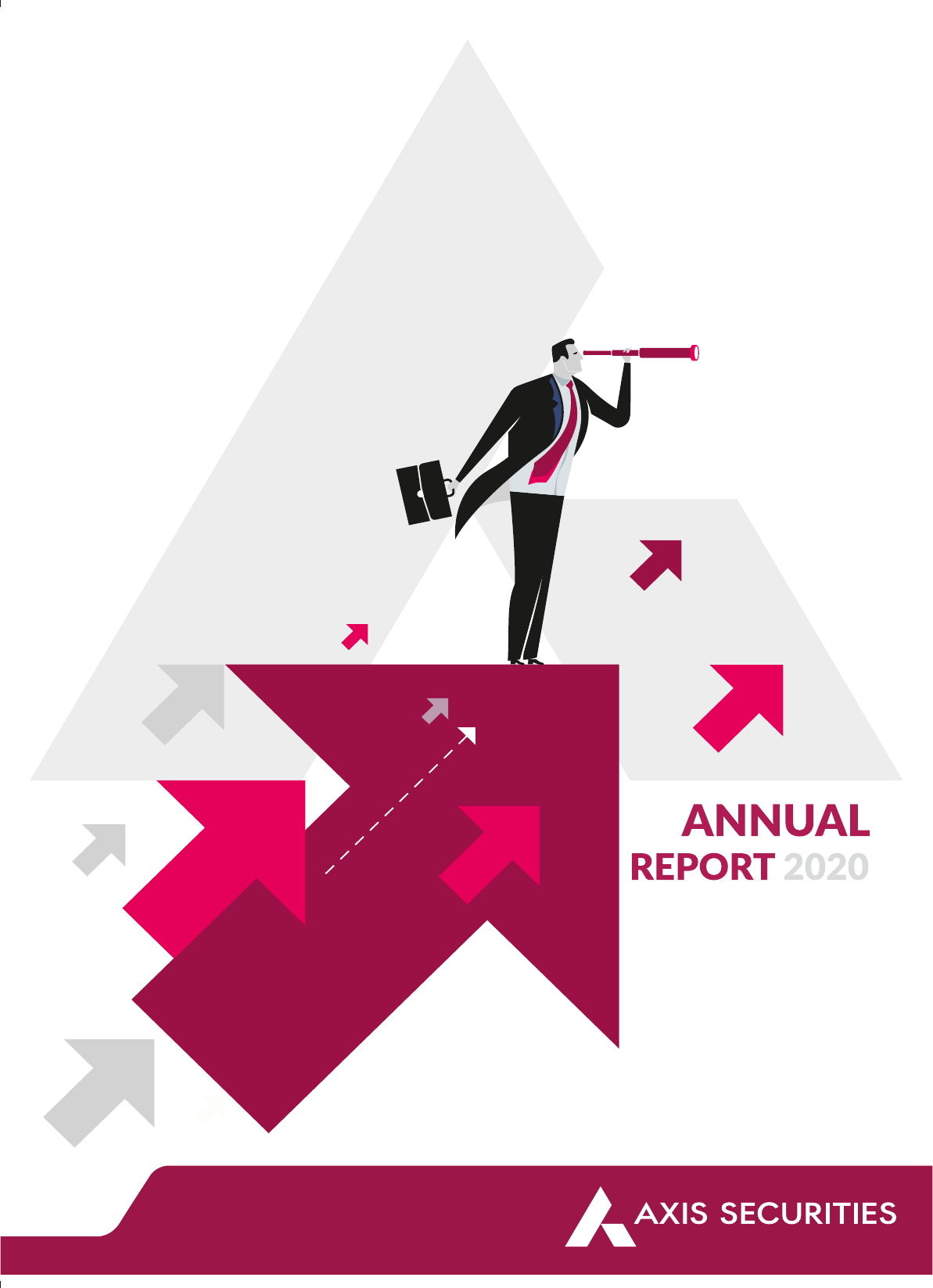

1
A Subsidiary of AXIS BANK
CONTENTS
Board of Directors 2
Directors’ Report 3
Auditors’ Report 37
Balance Sheet 46
Statement of Profit and Loss Account 48
Cash Flow Statement 50
Notes to Accounts 52

2
A Subsidiary of AXIS BANK
BOARD OF DIRECTORS
Pralay Mondal Chairman
Gop Kumar Bhaskaran Managing Director & CEO
Anand Kumar Shaha Whole Time Director
Ramesh Kumar Bammi Director
(Resigned w.e.f. 27.04.2020)
Jagdeep Mallareddy Director
(Resigned w.e.f. 19.05.2020)
Babu Rao Busi Independent Director
Bhumika Batra Independent Director
Divya Poojari (Ms.) Company Secretary
Hemantkumar Patel Chief Financial Officer
M/s. S.R. Batliboi & Co. LLP STATUTORY AUDITORS
Chartered Accountants
M/s. RVA & Associates LLP INTERNAL AUDITORS
Chartered Accountants
M/s. BNP & Associates SECRETARIAL AUDITORS
Practising Company Secretaries
KFintech Private Limited REGISTRAR AND SHARE TRANSFER AGENT
Karvy Selenium, Tower-B, Plot No 31& 32,
Gachibowli, Financial District,
Nanakramguda, Serilingampally,
Hyderabad - 500 008, India
Tel. : +91 040 67161604
REGISTERED OFFICE
Axis House, 8
th
Floor, Wadia International Centre,
Pandurang Budhkar Marg, Worli, Mumbai – 400 025
CIN : U74992MH2006PLC163204
Tel. : 022 2425 2009
Email : [email protected]
Website : www.axisdirect.in / www.axissecurities.in
CORPORATE OFFICE
Phoenix Market City, Unit No. 2, 2nd Floor, 15, LBS Road,
Near Kamani Junction, Kurla (West), Mumbai – 400 070
Tel. : 022 42671500
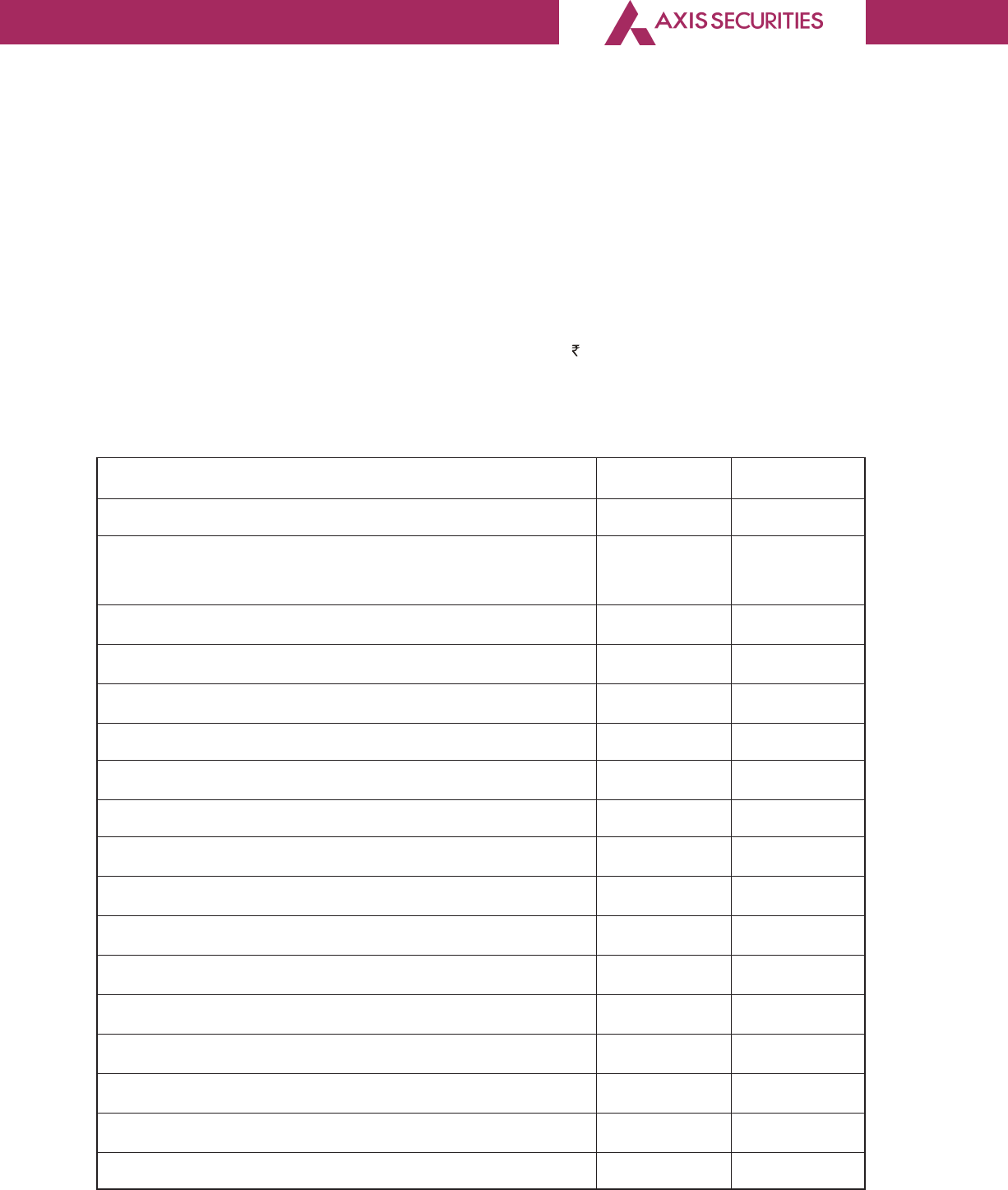
3
A Subsidiary of AXIS BANK
DIRECTORS’ REPORT
DEAR MEMBERS
Your Directors have pleasure in presenting the 14
th
Annual Report of Axis Securities Limited (the
Company) alongwith the Audited Financial Statements for the financial year ended March 31,
2020.
FINANCIAL PERFORMANCE:-
During the year, the Company achieved a total income of 2,377,238,793/-
The highlights of the financial Results of your Company for the year ended March 31, 2020 are
given below:
(Figures in Lakhs)
Particulars 2019-20 2018-19
Operating Income(A) 19,589 19,028
Interest Income on Fixed Deposits and Miscellaneous
Income (B) 1,329 816
Total Income (A)+(B) 20,918 19,844
Operating Expenses 11,991 14,230
Profit/(Loss) before Depreciation & provisions for tax 8,927 5,614
Depreciation 1,438 1,063
Provision for Tax 2,228 1,624
Profit for the year from continuing operation 5,261 2,927
Exceptional items (2,845) –
Profit before tax for the year from discontinued
Profit before tax for the year from discontinued operations 665 6,693
Tax income/ (expense) of discontinued operations 183 2,408
Deferred tax – 50
Profit for the year from discontinued operations 482 4,335
Profit for the year 2,898 7,262
Other Comprehensive Income (164) 189
Total Comprehensive Income for the year 2,734 7,451
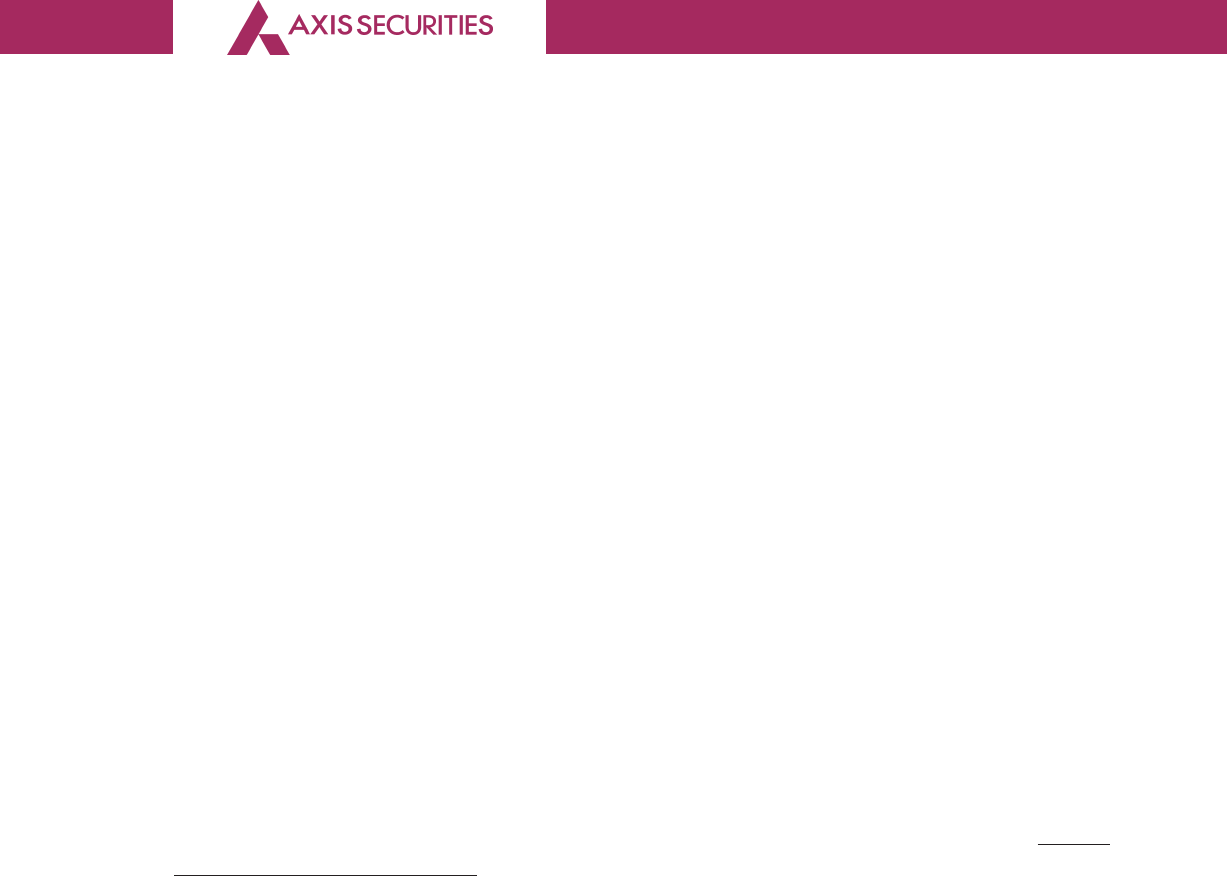
4
A Subsidiary of AXIS BANK
BUSINESS OVERVIEW & REVIEW OF OPERATIONS:-
In Financial Year 2019-20 Retail Broking has achieved overall revenue of Rs. 20918 lakhs which is
increase of 5% as compared to Rs. 19844 lakhs in Financial Year 2018-19 and have acquired 1.77
Lakhs customers.
GENERAL RESERVE:-
The Company in accordance with Section 123 of the Companies Act, 2013 (“the Act”), has
transferred a sum of Rs. 1,59,00,000/- to the General Reserve account.
MATERIAL CHANGE AND COMMITMENT:-
In terms of the information required under sub-section (3)(l) of Section 134 of the Act, it is to be
noted that no material changes and commitments, affecting the financial position of the Company
has occurred between the end of the Financial Year of the Company to which the Financial
Statements relate and to the date of the Directors Report.
ANNUAL RETURN:-
The Annual Return of the Company for the said financial year as required under Section 92 of the
Companies (Amendment) Act, 2017 is available on the website of the Company at https://
simplehai.axisdirect.in/aboutus and the same is enclosed as Annexure-A
DETAILS OF SIGNIFICANT AND MATERIAL ORDERS PASSED BY THE REGULATORS OR COURTS OR
TRIBUNALS IMPACTING THE GOING CONCERN STATUS AND COMPANY’S OPERATIONS IN FUTURE:-
In terms of the information required under Section – 134 of the Act and Clause – 8 of the Companies
(Accounts) Rules, 2014 it is to be noted that there is no significant and material order passed by the
Regulators or Courts or Tribunals impacting the going concern status and Company’s operations
in future.
STATEMENT INDICATING DEVELOPMENT AND IMPLEMENTATION OF A RISK MANAGEMENT POLICY
INCLUDING IDENTIFICATION THEREIN OF ELEMENTS OF RISK:-
Risk Management is a key function in a Stock Broking Company. Real-time monitoring of overall
exposure of the Company is required from the point of view of Risk Control. In volatile markets,
robust Risk Management policies are must.
The Company has adopted a comprehensive Risk Management Policy identifying various elements
of risks, risk parameters and risk containment measures. The Company has automated risk

5
A Subsidiary of AXIS BANK
management systems in place. The risk system monitors various trades and positions of the clients
on real-time basis with the help of real time data feeds from Exchanges. The system also generates
automated alerts in case of specified events based on the set parameters. A dedicated risk team
monitoring the risk systems acts promptly on such alerts. The above risk processes have been put in
place for Equities, Derivatives, Commodities and Currencies etc.
Client defaults in paying up the losses arising out of client positions poses significant risk, which in
the opinion of the Board may threaten the existence of the Company. Other identified risks are
system malfunction, black swan event, Internal as well as external frauds, adverse regulatory action
against the Company etc.
INTERNAL CONTROL SYSTEMS AND THEIR ADEQUACY:-
The Company has an Internal Control System commensurate with the size, scale and complexityof
its operations. Internal control systems comprising of policies and procedures are designed to ensure
reliability of financial reporting, timely feedback on achievement of operational and strategic
goals, compliance with policies, procedure, applicable laws and regulations and that all assets
and resources are acquired economically, used efficiently and protected adequately.
The Internal Audit Department monitors and evaluates the efficacy and adequacy of internal
control system in the Company, its compliance with operating systems, accounting procedures
and policies at all locations of the Company. Based on the report of internal audit function, process
owners undertake corrective action in their respective areas and thereby strengthen the controls.
Significant audit observations and corrective actions thereon are presented to the Audit Committee
of the Board. A yearly presentation on Internal Financial Control Systems is also presented to Audit
Committee of the Board.
VIGIL MECHANISM / WHISTLE BLOWER POLICY:-
The Company has adopted the code of conduct for employee, customers, vendors and also for
its directors for the highest degree of transparency, integrity, accountability and corporate social
responsibility. Any actual or potential violation of the Code would be a matter of serious concern
for the Company.
The Company has also in place a Whistleblower Policy (‘the Policy’) which aims to set up a
mechanism that enables employees to report about actual or potential illegal and/or
unacceptable practices. The policy is designed to enable employees, to raise concerns to
Whistleblower Committee, without revealing his/her identity, if he/she chooses to do so and to
disclose information which the individual believes, shows malpractice or wrongdoing which could
affect the business or reputation of the Company.
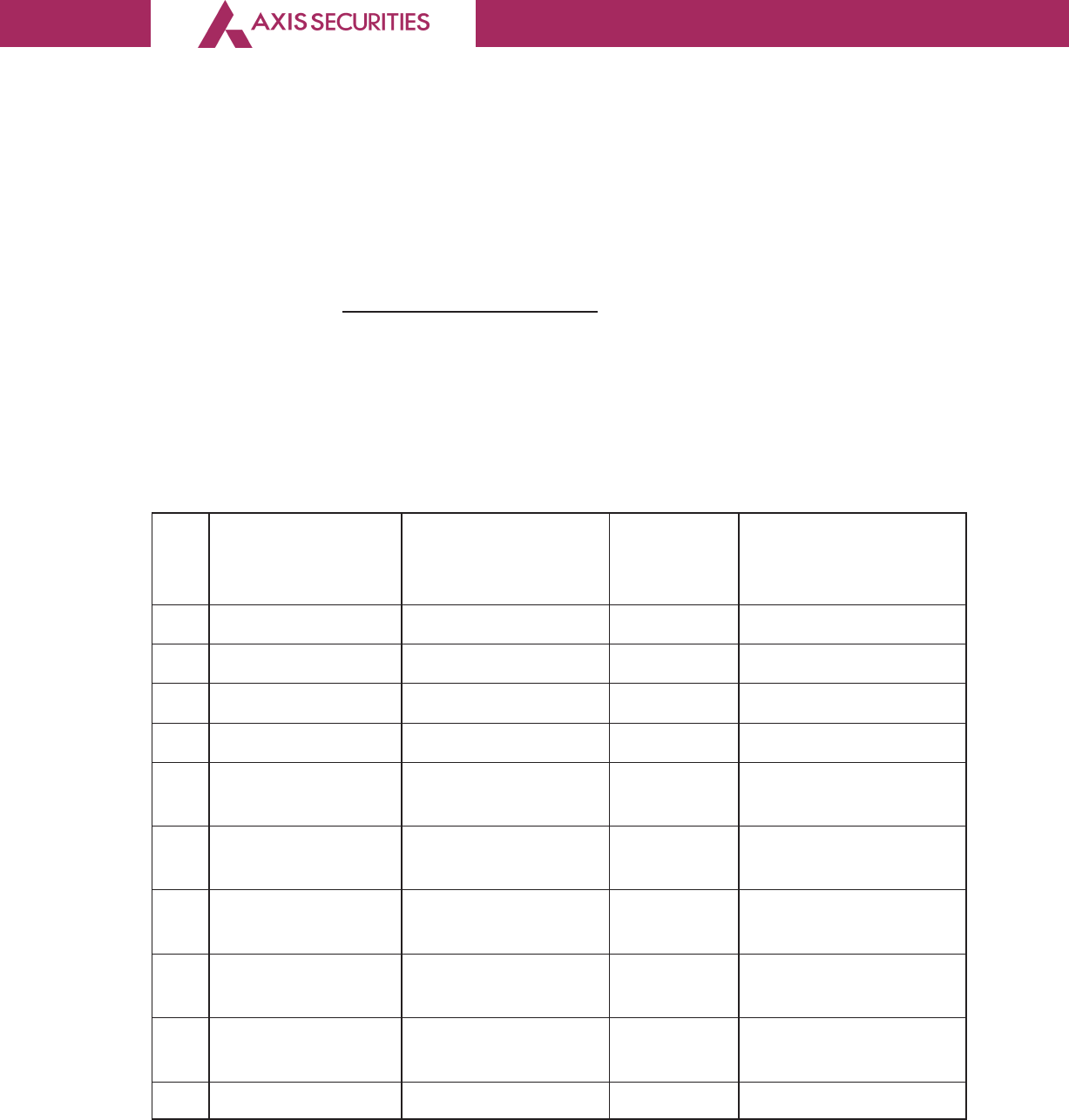
6
A Subsidiary of AXIS BANK
The Policy is to provide framework for an effective vigil mechanism and to provide protection to
employees, customers, vendors or directors reporting genuine concerns.
Employees of the Company are encouraged to use guidance provided in the Policy for reporting
all allegations of suspected improper activities to the Whistle Blower Committee by sending the
members an email on [email protected]
BOARD OF DIRECTORS, MEETINGS, EVALUATION ETC.:-
Board of Directors:-
During the year under review, following are the list of Directors being appointed or resigned from
the Board of the Company:
Sr. Name of the Status Date of Designation
No. Director appointment/
Resignation
1 Ms. Nithya Easwaran Resignation 12.04.2019 Independent Director
2 Mr. Pralay Mondal Appointment 12.04.2019 Additional Director
3. Mr. Rajiv Anand Resignation 09.05.2019 Director
4. Mr. Pralay Mondal Change in Designation 07.06.2019 Director
5. Ms. Bhumika Batra Appointment 23.07.2019 Additional Independent
Director
6. Mr. Gop Kumar
Bhaskaran Appointment 18.10.2019 Additional Director
7. Mr. Arun Thukral Resignation 31.12.2019 Managing Director
& CEO
8. Mr. Gop Kumar Change in 08.01.2020 Director
Bhaskaran Designation
9. Mr. Gop Kumar Appointment 01.01.2020 Managing Director
Bhaskaran & CEO
10. Ms. Bhumika Batra Change in Designation 08.01.2020 Independent Director
Board Meetings:-
During the year under review, the Board of Directors (hereinafter called as the “BOARD”) met for
five times viz. 12.04.2019, 16.07.2019, 24.09.2019, 18.10.2019 and 15.01.2020:

7
A Subsidiary of AXIS BANK
The details of the attendance of the Board are as follows:
Name of the Director Number of Board Number of Meetings
Meetings Entitled to Attend Attended
Mr. Rajiv Anand 1 1
Mr. Pralay Mondal 4 4
Mr. Ramesh Kumar Bammi 5 4
Mr. Babu Rao Busi 5 5
Ms. Nithiya Easwaran 1 1
Ms. Bhumika Batra 3 3
Mr. Jagdeep Mallareddy 5 4
Mr. Arun Thukral 4 4
Mr. Anand Kumar Saha 5 4
Mr. Gop Kumar Bhaskaran 1 1
COMMITTEES OF THE BOARD
I. AUDIT COMMITTEE
During the year under review, the Audit Committee met four times viz: 12.04.2019, 16.07.2019,
18.10.2019 and 15.01.2020
The details of the attendance of the Audit Committee Members are as follows:
Name of the Director Number of Board Number of Meetings
Meetings Entitled to Attend Attended
Ms. Nithiya Easwaran 1 1
Mr. Babu Rao Busi 4 4
Ms. Bhumika Batra 2 2
Mr. Jagdeep Mallareddy 4 3
Mr. Anand Shaha 1 0
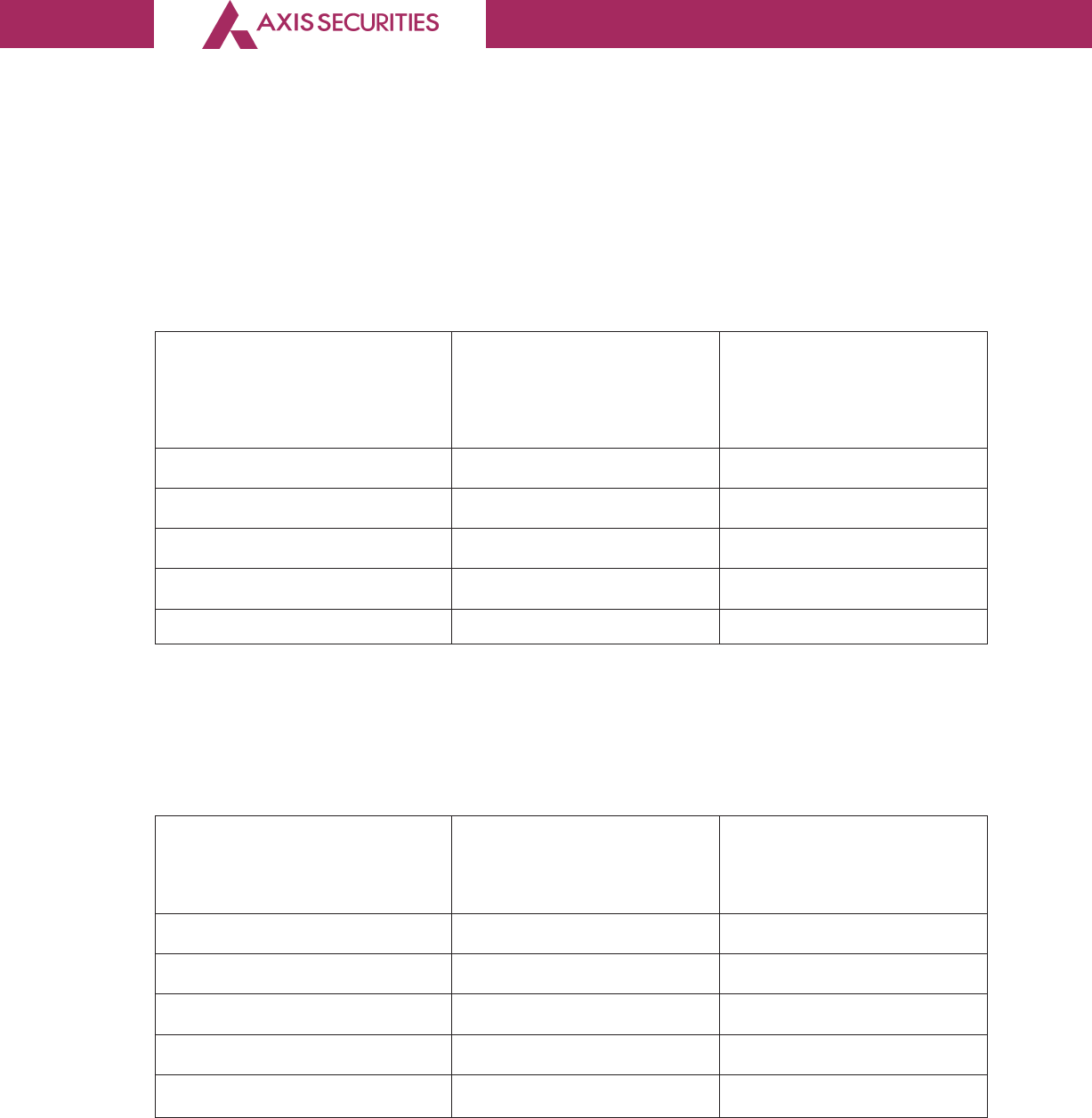
8
A Subsidiary of AXIS BANK
II. NOMINATION AND REMUNERATION COMMITTEE (NRC)
During the year under review, the Nomination and Remuneration Committee met thrice viz:
12.04.2019, 18.10.2019 and 15.01.2020.
The details of the attendance of the NRC Members are as follows:
Name of the Member Number of Nomination Number of Meetings
and Remuneration Attended
Committee Meetings
Entitled to Attend
Mr. Babu Rao Busi 3 3
Mr. Rajiv Anand 1 1
Mr. Pralay Mondal 2 2
Ms. Nithiya Easwaran 1 1
Ms. Bhumika Batra 2 2
III. CORPORATE SOCIAL RESPONSIBILITY COMMITTEE (CSR)
During the year under review, the CSR Committee met two timesviz: 16.07.2019 and15.01.2020.
The details of the attendance of the CSR Committee Members are as follows:
Name of the Member Number of CSR Number of Meetings
Committee Meetings Attended
Entitled to Attend
Mr. Ramesh Kumar Bammi 2 2
Mr. Babu Rao Busi 1 1
Mr. Jagdeep Mallareddy 2 2
Mr. Arun Thukral 1 1
Mr. Gop Kumar Bhaskaran 1 1
IV. RISK MANAGEMENT COMMITTEE (RMC)
During the year under review, the Risk Management Committee met four times viz: 11.04.2019,
15.07.2019, 17.10.2019 and 14.01.2020.
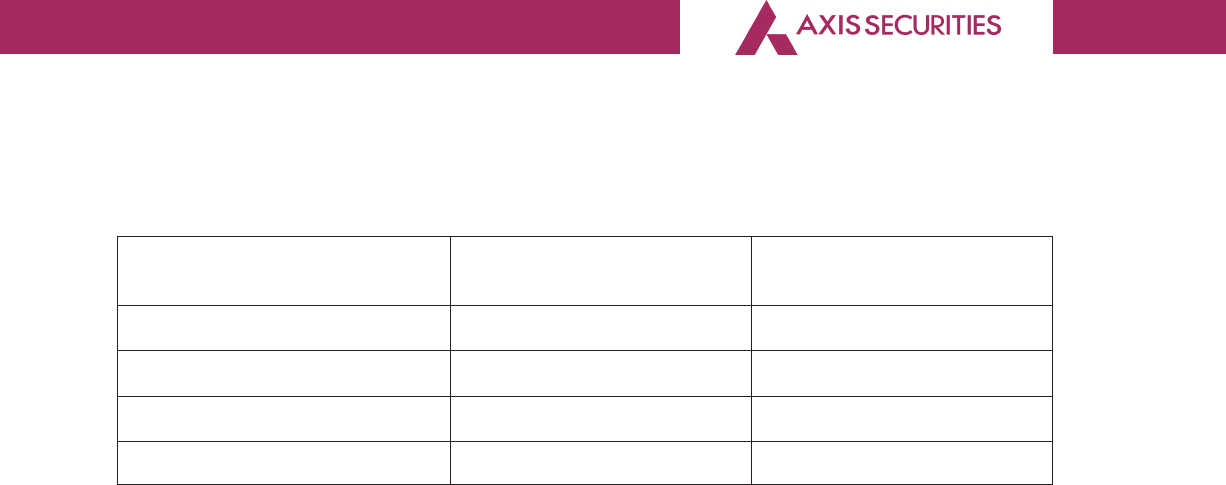
9
A Subsidiary of AXIS BANK
The details of the attendance of the RMC Members are as follows:
Name of the Member Number of Board Meetings Number of Meetings
Entitled to Attend Attended
Mr. Jagdeep Mallareddy 4 4
Mr. Arun Thukral 3 3
Mr. Gop Kumar Bhaskaran 1 1
Mr. Anand Kumar Shaha 4 4
The intervening gap between the Meetings was within the period prescribed under the Act.
Annual Evaluation:-
The Formal Annual Evaluation has been made as follows:-
During the year under review, the Independent Directors of the Company met on March 16, 2020
without the attendance of Non-Independent Directors and Members of Management. At the
said meeting, the Independent Directors reviewed the process adopted for conduct of Board
performance evaluation as recommended by the Nomination and Remuneration Committee.
The Nomination and Remuneration Committee (the Committee) of the Company is the nodal
agency for conduct of said performance evaluation. The Committee Chairman reviewed and
approved the manner for conducting the said performance evaluation and also determined the
criteria for the same. The Committee Chairman had appointed an External Agency M/s. Potentia
Growth Services Private Limited for evaluating the performance of the Board, Committees and
Directors.
The performance evaluation of the Board was conducted on various aspects of the Board’s
functioning such as strategic planning, identification and management of risks, succession planning
and evaluation of management, audit & compliance, governance, relationship with executive
management of the Company, etc. The performance evaluation of the Committees was based
on criteria such as appropriate composition, clarity in terms of reference, regularity of meetings,
quality of discussion/deliberation at its meetings, participation of members etc. The performance
evaluation of Directors was carried out on various criteria such as attendance, participation at the
meetings, interpersonal relationship with other Directors, providing guidance, knowledge and
understanding of areas relevant to the operations of the Company, etc.
The outcomes were reviewed by the Committee and the Board in their meetings held on April 20,
2020 and April 23, 2020 and their observations/ feedback were conveyed to the concerned
stakeholders, for appropriate action.
Declaration by Independent Director:-
The Company has received the declarations from its Independent Directors that they meet the
Criteria of Independence as laid down under Section 149(6) of the Act.
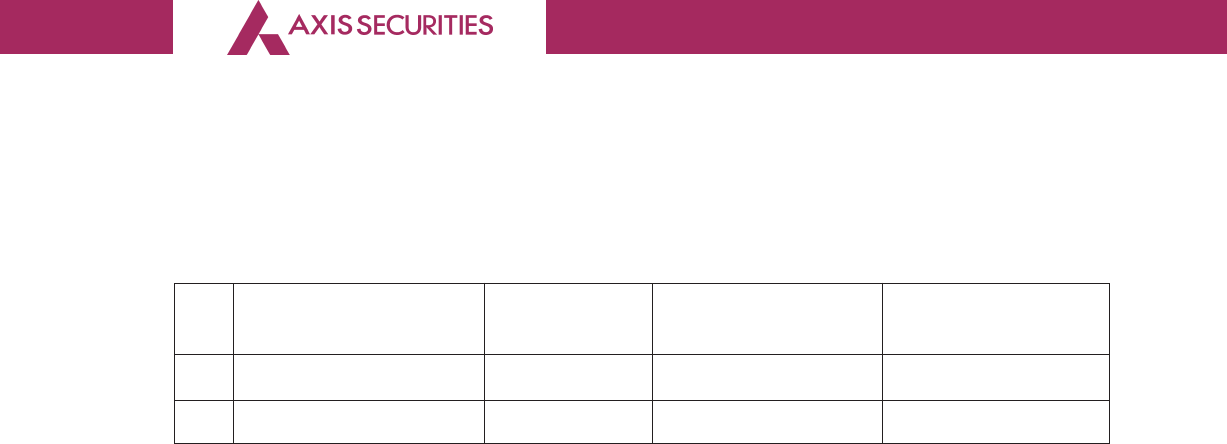
10
A Subsidiary of AXIS BANK
Key Managerial Personnel:-
During the year under review, following were the changes in the Key Managerial Personnel:
Sr. Name of the Key Status Date of appointment/ Designation
No. Managerial Personnel resignation
1. Ms. Lovelina Faorz Resignation 29/10/2019 Company Secretary
2. Ms. Divya Poojari Appointment 30/01/2020 Company Secretary
SHARE CAPITAL:-
During the year, the Company has increased its Authorised Capital from INR 150 crores to INR 250
crores.
Further, there is no change in the Issued, Subscribed and Paid – up Share Capital of the Company.
PUBLIC DEPOSITS:-
During the year under review, the Company has not accepted any deposit pursuant to Section 73
and Section 76 of the Act read with Companies (Acceptance of Deposits) Rules, 2014.
PARTICULARS OF CONSERVATION OF ENERGY, TECHNOLOGY ABSORPTION, FOREIGN EXCHANGE
EARNINGS AND OUTFLOWS:-
Information as per Section 134(3)(m) of the Act relating to the Conservation of Energy and
Technology Absorption is not given since the Company is not engaged in any manufacturing
activity.
During the year under review, the Company has spent Rs. 1,493,383 (Rupees Fourteen Lakh Ninety
Three Thousand Three Hundred and Eighty Three only) in foreign exchange towards technology
and other expenses. The Company has not earned any foreign exchange. The details of the Foreign
exchange outflow are enclosed in Annexure - B.
PARTICULARS OF LOANS, GUARANTEES OR INVESTMENT UNDER SECTION- 186:-
Pursuant to Section 134(3)(g) of the Act, the Company has not given any Loan, Guarantee or
made Investment under Section 186 of the Act.
PARTICULARS OF CONTRACTS OR ARRANGEMENTS WITH RELATED PARTIES UNDER SUB – SECTION (1)
OF SECTION 188
Information as per Section 134(3)(h) of the Act relating to the particulars of Contracts or
Arrangements with Related Parties under Sub – Section (1)of Section 188 is as mentioned below:-
All Related Party Transactions that were entered into during the financial year were on arm’s length
basis and were in the ordinary course of business. There wereno materially significant Related Party

11
A Subsidiary of AXIS BANK
Transactions made by the Company with Promoters, Directors, Key Managerial Personnel or other
designated persons which may have a potential conflict with the interest of the Company at
large.
All Related Party Transactions are placed before the Audit Committee for approval. Prior omnibus
approval of the Audit Committee is obtained for the transactions which are of foreseen and
repetitive in nature. The transactions entered into pursuant to the omnibus approval so granted
are audited and a statement giving details of all Related Party Transactions are placed before the
Audit Committee.
None of the Directors has any pecuniary relationship or transactions vis-à-vis the Company. The
disclosure of particulars of contracts/arrangements entered into by the Company with related
partiespursuant to Clause (h) of sub-section (3) of Section 134 of the Act and Rule 8(2) of the
Companies (Accounts) Rules, 2014 in Form AOC – 2 is enclosed herewith as Annexure - C.
PARTICULARS OF EMPLOYEES AS REQUIRED UNDER COMPANIES ACT, 2013 AND COMPANIES
(APPOINTMENT AND REMUNERATION OF MANAGERIAL PERSONNEL) RULES, 2014:-
In terms of Section 136 of the Act, the Report and Accounts are being sent to the Members and
others entitled thereto, excluding the information on employees’ particulars. If any Member is
interested in obtaining a copy thereof, such Member may write to the Company Secretary in this
regard.
CORPORATE SOCIAL RESPONSIBILITY INITIATIVES:-
The Company recognized the importance of good corporate governance and corporate social
responsibility in promoting and strengthening the trust of its clients, employees, society and other
stakeholders. The Company’s Corporate Social Responsibility (CSR) activities reflect its philosophy
of helping to build a better, more sustainable society by taking into account the societal needs of
the Community.
The Company’s CSR Policy has been framed in accordance with Section 135 of the Companies
Act, 2013 and the rules thereunder. The policy shall apply to all CSR programs undertaken/sponsored
by the Company, executed through itself, its Holding Company’s Axis Bank Foundation or through
any other Trust/NGO.
As part of its initiatives under “Corporate SocialResponsibility” (CSR), the Company has contributed/
undertakenproject namely KABIL.
Project Kabilwas directed towards the following:
1. Improving the income of household by implementation of different rural livelihood interventions
with two indicators:
a) Participating Households would be earning at least INR 75,000 pa at project level by the
end of the project period.
2. Enhance technical knowledge of farmers in modern agriculture and allied activities;
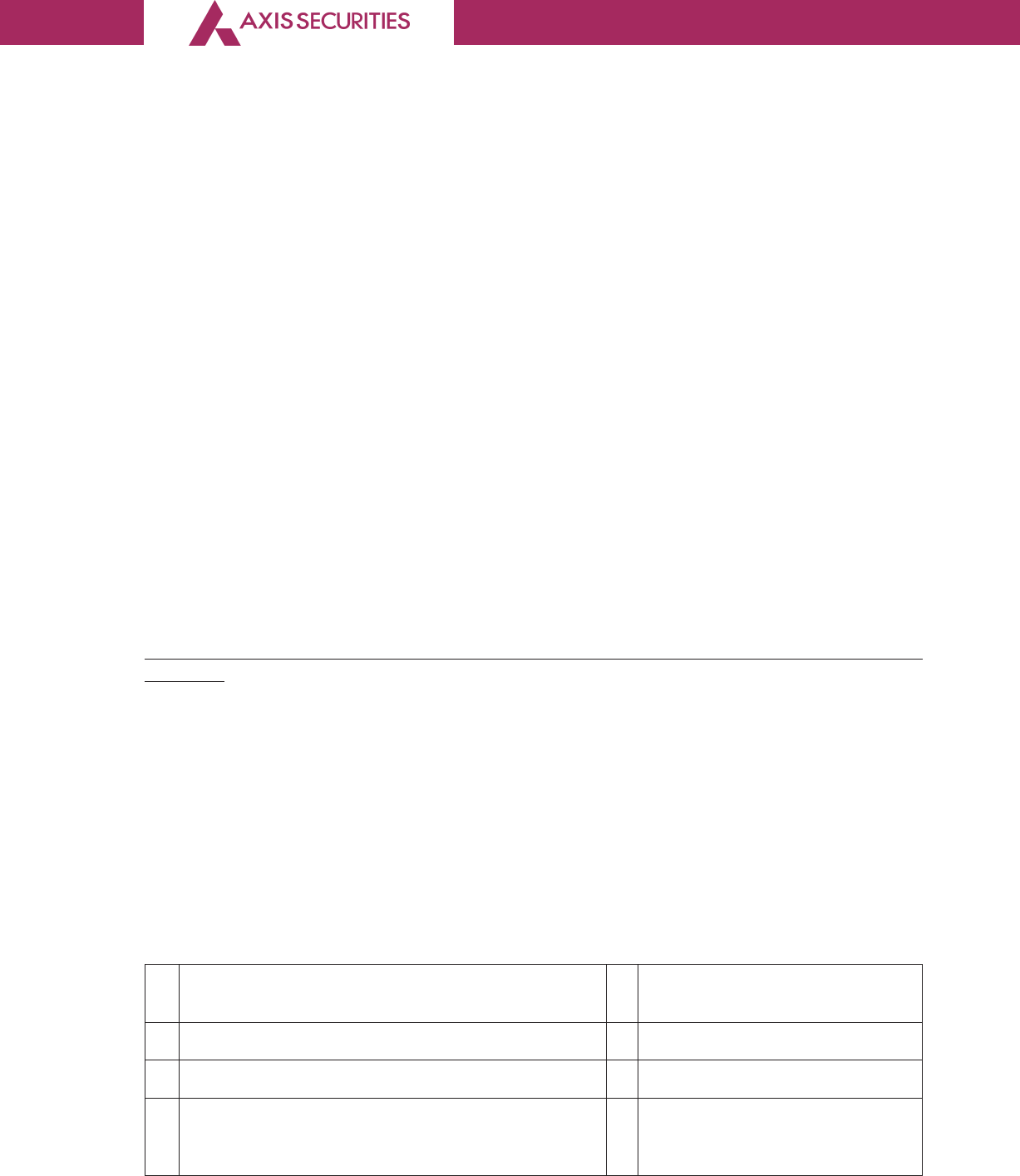
12
A Subsidiary of AXIS BANK
3. Develop entrepreneurs from the local community for market linked livelihood development
for sustainability;
4. Access government funds to livelihood activities.
KABIL project was done through Axis Bank Foundation. The said project is in accordance with
Schedule VII of the Companies Act, 2013.
During the year under review, the Company has spent Rs. 1,93,66,947/- (Rupees One Crore Ninety
Three Lakhs Sixty Six Thousand Nine Hundred and Forty Seven Only) towards CSR activity undertaken.
For detailed report refer Annexure –D.
POLICY OF THE NOMINATION AND REMUNERATION COMMITTEE:-
The Company has a Nomination and Remuneration Policy formulated in compliance with Section
178 of the Act read along with the applicable rules thereto as amended from time to time. The
policy shall apply to all Directors (Executive and Non-Executive), Key Managerial Personnel and
Senior Management. The Policy laid down the roles of the Committee, criteria for appointment of
Directors, Key Managerial Personnel and Senior Management and parameters for determining
the remuneration of Directors, Key Managerial Personnel, Senior Management and other
employees, etc. The policy is available on the website of the Company at:
https://simplehai.axisdirect.in/images/RegulatoryDisclosure/Policies/NominationRemuneration
Policy.pdf
DISCLOSURE UNDER THE SEXUAL HARASSMENT OF WOMEN AT WORKPLACE (PREVENTION, PROHIBITION
& REDRESSAL) ACT, 2013:-
The Company has in place a policy for Prevention, Prohibition & Redressal of Sexual Harassment at
workplace which is in line with the requirements of the Sexual Harassment of Women at Workplace
(Prevention, Prohibition & Redressal) Act, 2013 and Rules made thereunder.
All employees are covered under this policy. The Company has constituted an Internal Complaint
Committee for its Head office and branches under Section 4 of the captioned Act.
The details of the number of complaints filed and resolved during the year are as under:-
a. Number of complaints received during the year : 6
(2019-20)
b. Number of complaints disposed off during the year : 5
c. Number of cases pending for more than 90 days : NIL
d. Number of workshops or awareness programs : Organized workshops &
carried out against sexual harassment awareness programs at regular
intervals.
*Investigation of 1 case is under process.

13
A Subsidiary of AXIS BANK
DIRECTORS RESPONSIBILITY STATEMENT:-
Pursuant to sub-section (5) of Section 134 of the Act, the Board of Directors of the Company hereby
state and confirm that:
i. The applicable accounting standards have been followed in the preparation of the annual
accounts and proper explanations have been furnished, relating to material departures.
ii. Accounting policies have been selected, and applied consistently and reasonably, and
prudent judgments and estimates have been made so as to give a true and fair view of the
state of affairs of the Companyat the end of the Financial Year and of the profit of the Company
for the year ended March 31, 2020.
iii. Proper and sufficient care has been taken for the maintenance of adequate accounting
records, in accordance with the provisions of the Actfor safeguarding the assets of the
Company and for preventing and detecting fraud and other irregularities.
iv. The annual accounts of the Company have been prepared on a going concern basis.
v. The directors had laid down internal financial controls to be followed by the Company and
that such internal financial controls are adequate and were operating effectively.
vi. Proper system has been devised to ensure compliance with the provisions of all applicable
laws and such systems are adequate and operating effectively.
COMPLIANCES:-
The Company’s policy on compliance with external regulatory requirements is backed by stringent
internal policies and principles to ensure, Inter alia, priority to clients’ interests over proprietary
interest, maintenance of confidentiality of client information and prevention of insider trading.
AUDITORS:-
i. Statutory Auditors:
Pursuant to the provisions of Section 134 of the Companies Act, 2013 and the Companies (Audit
and Auditors) Rules, 2014, the Company has re-appointed
M/s. S. R. Batliboi & Co. LLP, Chartered Accountants, Mumbai as the Statutory Auditors of the
Company to hold office from the conclusion of 12
th
Annual General Meeting until the conclusion of
the 17
th
Annual General Meeting of the Company.
The Company has received the certificate of eligibility criteria under Section 141 from the Statutory
Auditors.

14
A Subsidiary of AXIS BANK
Also, pursuant to the notification issued by MCA dated May 7, 2018, the requirement of ratifying
the appointment of Statutory Auditors in every Annual General Meeting is done away.
ii. Secretarial Auditors:
Pursuant to the provisions of Section 204 of the Companies Act, 2013 and The Companies
(Appointment and Remuneration of Managerial Personnel) Rules, 2014, the Company has re-
appointed M/s. BNP & Associates, Practicing Company Secretaries, to undertake the Secretarial
Audit of the Company for the financial year under review. The Report of the Secretarial Audit
Report is annexed herewith as Annexure - E.
iii. Internal Auditors:-
Pursuant to the provisions of Section 138 of the Companies Act, 2013 and the Companies (Accounts)
Rules, 2014, the Company has appointed
M/s. RVA &Associates, LLP Chartered Accountantsto undertake the Internal Audit of the Company
for the financial year under review.
CORPORATE GOVERNANCE:-
The Company’s policy on Corporate Governance is as under:
i. To enhance the long term interest of its shareholders, provide good management, adopt
prudent risk management techniques and comply with the applicable regulatory requirements,
thereby safeguarding the interest of its other stakeholders such as customers, employees,
creditors and vendors.
ii. To identify and recognize the Board of Directors and the Management of the Company as
the principal instruments through which good corporate governance principles are articulated
and implemented.
iii. To also identify and recognize accountability, transparency and equality of treatment for all
stakeholders, as central tenets of good corporate governance.
FUTURE OUTLOOK:-
Retail Broking:
Equity markets are passing through one of the worst crisis since 2008; the corona pandemic has
brought the world to standstill, with disrupted economic activities and lockdown of various extents
following the standard operating procedures to contain the spread. IMF expects the global
economy to contract by 3%, the US economy to shrink by around 6%, Europe by 7.5%; Indian and
China to grow at a measly rate of 1.9% and 1.2% respectively. According to the IMF, India is expected
to recover sharply in the next fiscal year posting 7.4% GDP growth.

15
A Subsidiary of AXIS BANK
Back home, the economy is completely at standstill for the month of April due to extension of
lockdown till May 3, 2020 though partial relaxations have been offered for essential goods industries
and relatively unaffected geographies. Post resumption of normalcy, the business would start
functioning keeping the social distancing norms. On account of the disruption in economic activities,
the earnings cycle is expected to be impacted at least for Q1FY21 but repercussions of the fall in
economic activities is expected to be seen in the financial sector as delinquencies are expected
to be spread in the rest of the year.
The government has already come up with relief measures to protect the lower strata of the society
and few more steps/stimulus is expected shortly to ensure continuity in businesses and protect
jobs. Global lockdown led demand destruction has caused a sharp drop in crude oil prices which
was already suffering from surplus supply; savings from crude oil imports would give legroom to
Indian government for infrastructure investment. RBI has taken proactive measures viz., reduced
the policy rates, cut CRR unlocking liquidity to mitigate the impact of COVID-19 crisis; temporary
moratorium of three months on payments of installments of all term loans (home, auto, personal,
agricultural, retail and crop loans) outstanding as of March 1, 2020 has also been granted. Moreover,
the central bank has assured to step in as and when required to ensure economic stability and
sufficient liquidity in the financial system.
Indian economy is expected to face real challenges as it exits lockdown; it would have to confront
potential labour shortages as the migrant labour would have left for their home towns/villages.
Getting them back at reasonable cost would be a tough challenge in the immediate future to
ensure wheels of industrial economy are put in motion. In addition, the administration would have
to ensure social distancing to ensure a second wave of infections, if any, does not occur. Moreover,
investments in specialized medical facilities at possibly every district level would be a need of hour
to attend any outbreak in future. Additional challenges like stressed corporate balance sheet esp.
NBFCs, resource strapped state and weakened MSMEs would have to be dealt with adroitly. Overall,
FY21 is expected to be a challenging year.
Indian Meteorological Dept. has indicated a ‘normal’ monsoon for 2020; good Rabi harvest and
neutral ENSO cycle (indicating normal monsoon) is likely to support demand from both rural and
urban economy for staples and discretionary consumption while low interest rates would augur
well for autos, housing/ real estate & housing finance, banking and other interest rate sensitive
sectors though capital investments are likely to be deferred given the uncertainty with demand
growth. Commodity prices are expected to trade low given the demand supply mismatch thus
benefiting the user industries.
Equity markets are expected to be volatile given the precarious situation of developed economies;
markets are expected to be driven by global market movements and the FII buying/ selling numbers
in the short term. Inadequate measures taken by developed economies (like premature opening
of lockdown without precautionary steps) to contain the virus and the possibility of a second wave
of increase in infection is also expected to keep the markets on its toes. Selling in large caps from
the overseas ETF investors or sovereign funds from Oil rich nations would also keep the indices low
in near term. Fundamentally, the recovery would happen somewhere post Q1FY21 as the market

16
A Subsidiary of AXIS BANK
participants factor in and look beyond the downgrades of FY21 earnings of India Inc. and start
building in earnings recovery for FY22.
AWARDS & RECOGNITION:-
During the year, the Company received accolades for its initiatives. During the year, the Company
has been awarded the following:
i. Commodity and Equity Outlook 2019(CEO 2019) in June 2019 for Retail Broker of the year.
SECRETARIAL STANDARDS:-
During the year under review, the Company has complied with the applicable Secretarial Standard
issued by Institute of Company Secretaries of India.
ACKNOWLEDGEMENT:-
Your Directors would like to express their gratitude for all the guidance and co-operation received
from its holding company - Axis Bank Limited. Your Directors would like to place on record their
gratitude to the esteemed Clients, Bankers, Financial Institutions, Suppliers, Service providers, Advisors,
Securities and Exchange Board of India (SEBI), National Stock Exchange of India Limited (NSE), BSE
Limited(BSE), National Securities Depository Limited (NSDL), Central Depository Services (India) Limited
(CDSL), Ministry of Corporate Affairs, Multi Commodity Exchange of India Limited (MCX), National
Commodity & Derivatives Exchange Limited (NCDEX), Metropolitan Stock Exchange of India Limited
(MSEI),Insurance Regulatory and Development Authority(IRDA), Central, State and Local
Government Departments for their continued support and cooperation.
The Directors also express their warm appreciation to all the employees of the Company for their
diligence and contribution.
For and on Behalf of the Board of Directors
Pralay Mondal
Chairman
DIN: 00117994
Address: Flat No. 1901 & 1902, Wing E,
Rustomjee Paramount, 18th Road,
Vithaldas Nagar, Khar West, Mumbai 400052
Place : Mumbai
Date : April 23, 2020
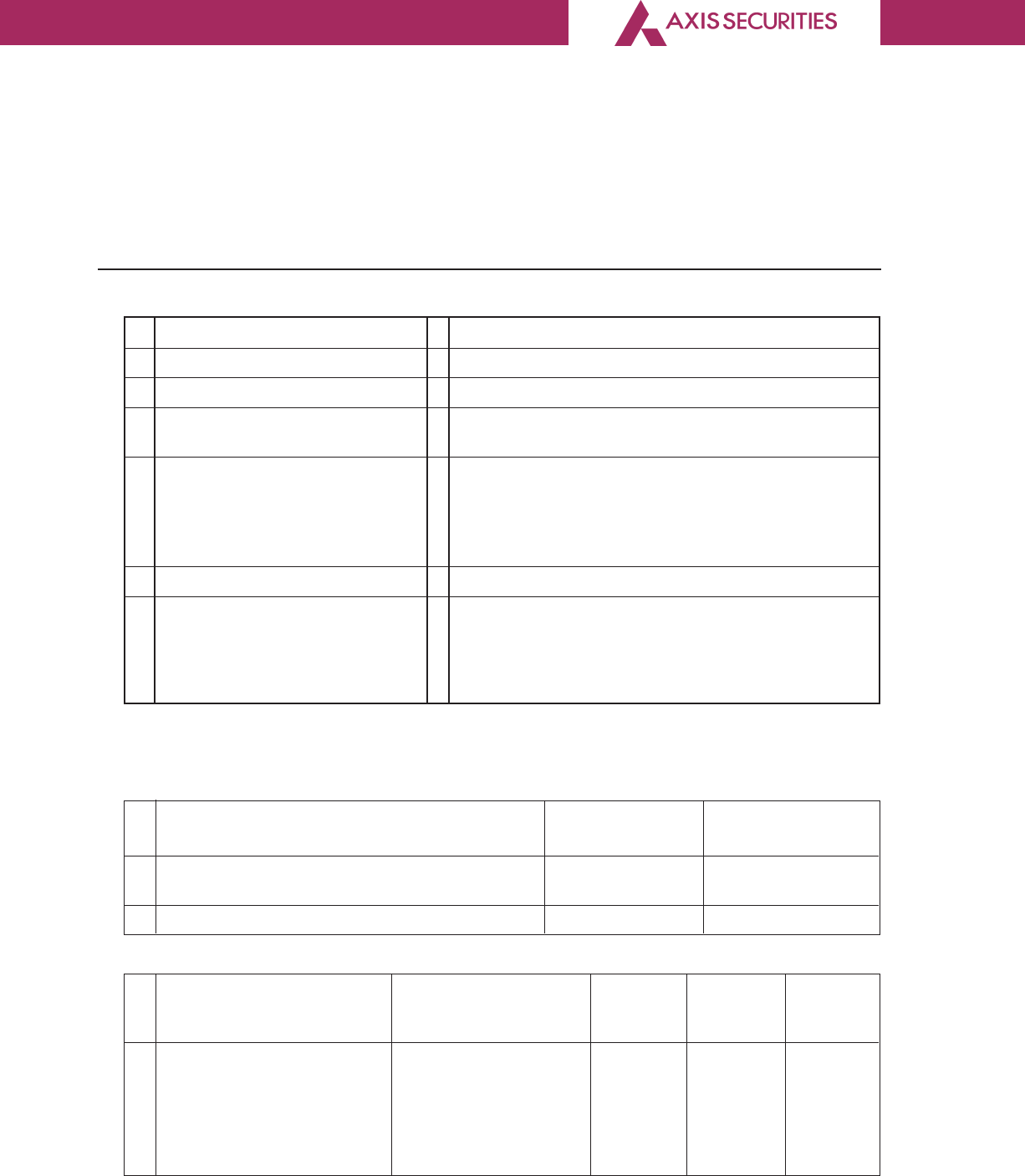
17
A Subsidiary of AXIS BANK
Form No. MGT-9 Annexure A
EXTRACT OF ANNUAL RETURN
as on the financial year ended on March 31, 2020
[Pursuant to Section 92(3) of the Companies Act, 2013 and Rule 12(1)of the
Companies (Management and Administration) Rules, 2014]
I. REGISTRATION AND OTHER DETAILS
i. CIN : U74992MH2006PLC163204
ii. Registration Date : 21/07/2006
iii. Name of the Company : Axis Securities Limited
iv. Category / Sub-Category of : Public Unlisted Company
the Company
v. Address of the Registered office : Axis House, 8
th
Floor, Wadia International Centre,
and contact details Pandurang Budhkar Marg, Worli, Mumbai – 400 025,
Maharashtra, India
Telephone No - 022 24252009
Email id – [email protected]
vi. Whether listed company : No
vii. Name, Address and Contact : M/s. Karvy Computershare Private Limited
details of Registrar and Transfer Karvy Selenium Tower- B, Plot No 31 & 32,
Agent, if any Gachibowli, Financial District, Nanakramguda,
Serilingampally, Hyderabad - 500 008, India.
Telephone No. : +91 040 67161604
II. PRINCIPAL BUSINESS ACTIVITIES OF THE COMPANY
All the business activities contributing 10% or more of the total turnover of the Company shall
be stated:-
Sr. Name and Description of main NIC Code of the % to total turnover
No. products/services Product/service of the Company
1. Business Sourcing and Resource
Management 99831130 12.72%
2. Brokerage on Securities 99715210 87.28%
III. PARTICULARS OF HOLDING, SUBSIDIARY AND ASSOCIATE COMPANIES:
Sr. Name and address of the CIN/GLN Holding/ % of Applicable
No. Company Subsidiary/ shares Section
Associate held
1. Axis Bank Limited
Trishul, 3
rd
Floor, L65110GJ1993PLC020769 Holding 99.999958 % 2(46)
Opp. Samartheshwar Temple,
Law Garden Ellisbridge,
Ahmedabad – 380006

18
A Subsidiary of AXIS BANK
IV. SHAREHOLDING PATTERN (Equity Share Capital Breakup as percentage of Total Equity)
i. Category - wise Share Holding
Category No. of shares held at the No. of shares held at the %change
of beginning of the year end of the year during
shareholders the year
Demat Physical Total % of Demat Physical Total % of
Total Total
shares shares
A. Promoters
(1) Indian
a) Individual / – – – – – – – – –
HUF
b) Central Govt. – – – – – – – – –
c) State Govt(s) – – – – – – – – –
d) Bodies Corp. – – – – – – – – –
e) Banks / FI 144,499,940 – 144,499,940 99.999958%144,499,940 – 144,499,940 99.999958% NIL
f) Any Other… – – – – – – – – –
Sub-total (A) (1): 144,499,940 – 144,499,940 99.999958%144,499,940 – 144,499,940 99.999958% NIL
(2) Foreign
a) NRIs - – – – – – – – – –
Individuals
b) Other – – – – – – – – – –
Individuals
c) Bodies Corp. – – – – – – – – –
d) Banks / FI – – – – – – – – –
e) Any Other…. – – – – – – – – –
Sub-total ––– –––– ––
(A) (2)
Total share-
holding of 144,499,940 – 144,499,940 99.999958%144,499,940 – 144,499,940 99.999958% NIL
Promoter (A) =
(A)(1)+(A)(2)
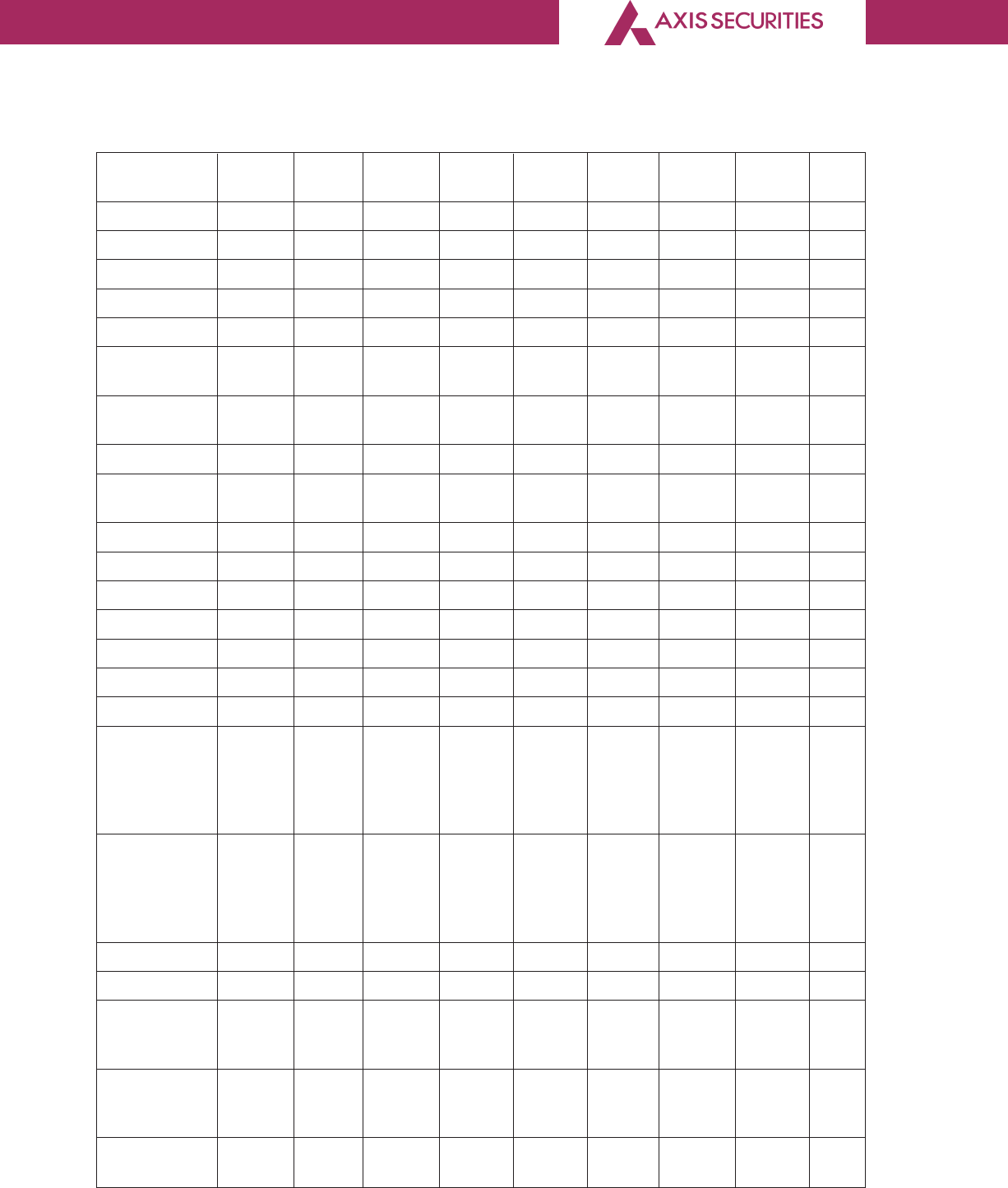
19
A Subsidiary of AXIS BANK
B. Public Share-
holding
1. Institutions
a) Mutual Funds – – – – – – – – –
b) Banks/ FI – – – – – – – – –
c) Central Govt – – – – – – – – –
d) State Govt(s) – – – – – – – – –
e) Venture Capital
Funds – – – – – – – – –
f) Insurance
Companies – – – – – – – – –
g) FIIs – – – – – – – – –
h) ForeignVenture
Capital Funds – – – – – – – – –
i) Others (specify) – – – – – – – – –
Sub-total (B)(1):- –– – ––– – ––
2. Non-Institutions
a) Bodies Corp. – – – – – – – – –
i) Indian – – – – – – – – –
ii) Overseas – – – – – – – – –
b) Individuals
i) Individual 60 – 60 0.000042% 60 – 60 0.000042% NIL
shareholders
holding nominal
share capital
upto Rs.1 lakh
ii) Individual share- – – – – – – – – –
holders holding
nominal share
capital in excess
of Rs. 1 lakh
c) Others(specify) – – – – – – – – –
Sub-total(B)(2):- 60 – 60 0.000042% 60 – 60 0.000042% NIL
Total Public 60 – 60 0.000042% 60 – 60 0.000042% NIL
Shareholding (B)=
(B)(1)+ (B)(2)
C. Shares held by – – – _ _ _ _ _ _
Custodian for
GDRs &ADRs
Grand Total
(A+B+C) 144,500,000 – 144,500,000 100% 144,500,000 – 144,500,000 100% _
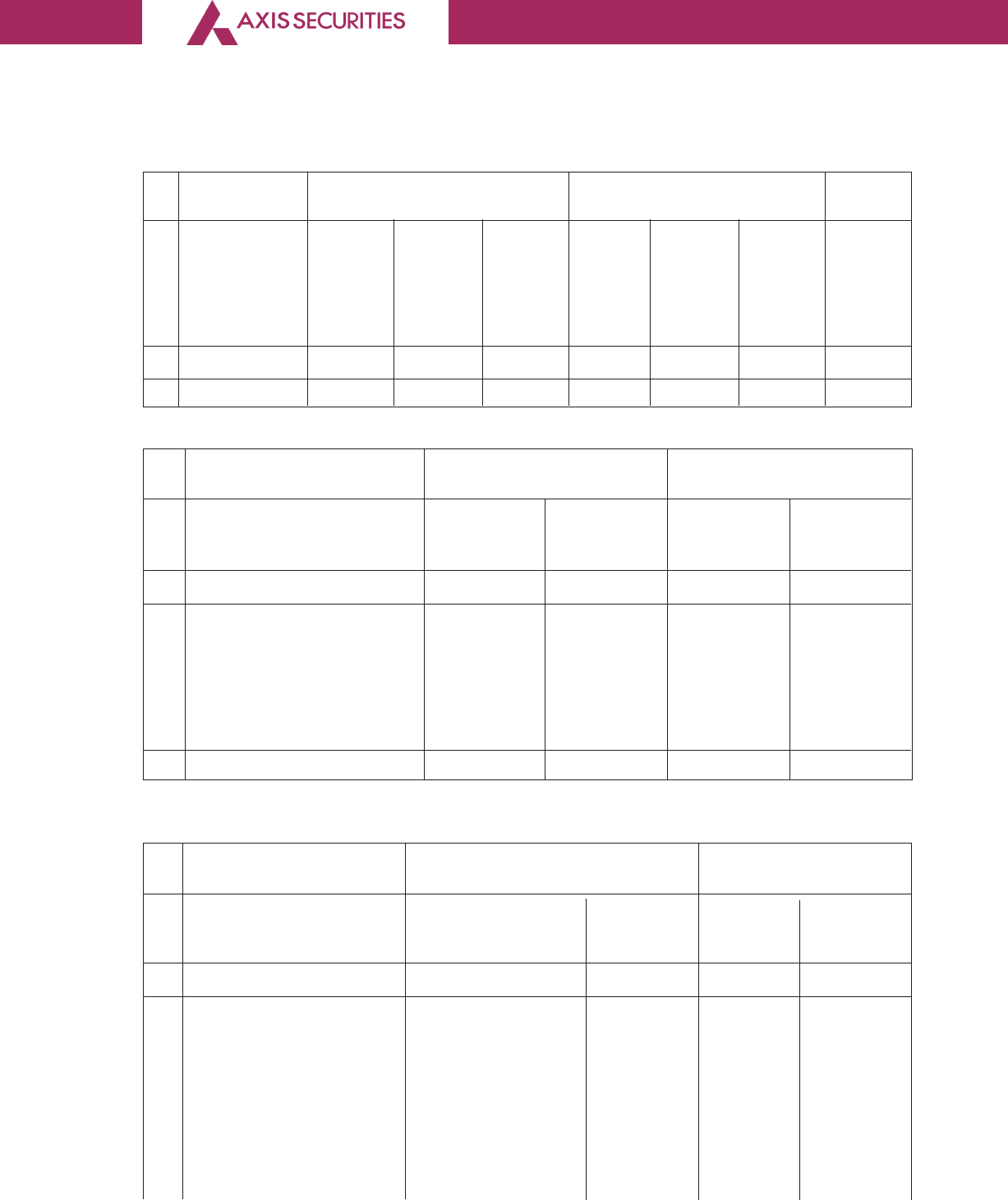
20
A Subsidiary of AXIS BANK
ii. Share Holding of Promoters
Sr. Shareholder’s Shareholding at the Shareholding at the
No. Name beginning of the year end of the year
No. of % of % of Shares No. of % of % of % Change
Shares total Pledged/ Shares total Shares in share
Shares encum- shares Pledged/ holding
of the bered to of the encum- during
Company total Company bered to the year
Shares total Shares
1. Axis Bank Limited 144,499,940 99.999958 % – 144,499,940 99.999958 % – –
Total 144,499,940 99.999958 % – 144,499,940 99.999958 % ––
iii. Change in Promoters’ Shareholding (please specify, if there is no change): NO CHANGE
Sr. Shareholding at the Cumulative Shareholding
No. beginning of the year during the year
No. of shares % of total No. of shares % of total
shares of the shares of the
company company
1. At the beginning of the year – – – –
2. Datewise Increase / – – – –
Decrease in Promoters Share
holding during the year
specifying the reasons for
increase/ decrease
(e.g. allotment / transfer /
bonus/ sweat equity etc):
3. At the End of the year – – – –
iv. Shareholding Pattern of top ten Shareholders (other than Directors, Promoters and Holders of
GDRs and ADRs):
Sr. Shareholding at the Cumulative Shareholding
No. beginning of the year during the year
For Each of No. of shares % of total No. of % of total
the Top 10 shares of the shares shares of the
Shareholders company company
1. At the beginning of year 40 0.000028% 40 0.000028%
2. Date wise Increase 09/05/2019
/ Decrease in Share Mr. Rajiv Anand
holding during the year Directors holding 10
specifying the reasons Shares resigned as
for increase /decrease the Directors of the 0.000007% 10 0.000007%
(e.g. allotment / transfer / Company
bonus / sweat equity etc): 22/05/2019
*10 Equity Shares held
by Mr. Arun Thukral
were trans fered to
Mr. Himadri Chaterjee
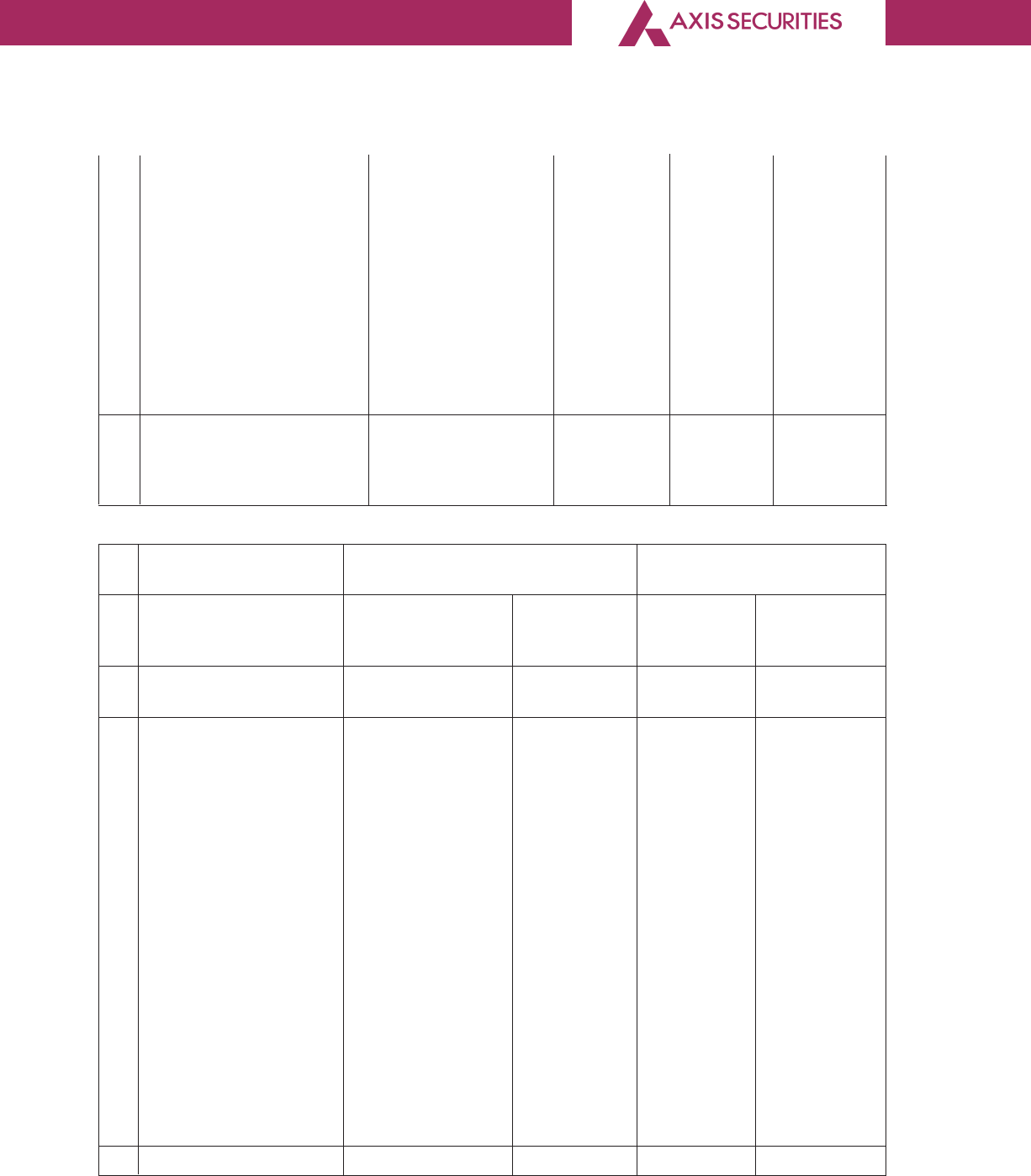
21
A Subsidiary of AXIS BANK
05/12/2019
*10 Equity Shares
held by Mr. Cyril 0 0 0
Anand were
transferred to
Mr. Pralay Mondal
(Director)
02/03/2020 0.000007% 10 0.000007%
*10 Equity Shares
held by Mr. Jairam
Sridharan were
transferred to
Mr. Ravi Narayan
3. At the End of the year 50 0.000035% 40 0.000035%
(or on the date of
separation, if separated
during the year)
v. Shareholding of Directors and Key Managerial Personnel:
Sr. Shareholding at the beginning Cumulative Shareholding
No. of the year during the year
For Each of the No. of % of total No. of % of total
Directors and shares shares of the shares shares of the
KMP company company
1. At the beginning 20 0.000014% 20 0.000014%
of the year
2. Date wise Increase / 09/05/2020 0.000007% 10 0.000007%
Decrease in Share- Mr. Rajiv Anand
holding during the Director holding
year specifying the 10 shares
reasons for increase/ resigned as the
decrease (e.g. Director of
allotment / transfer / the Company
bonus/ sweat equity 22/05/2019
etc): *10 Equity Shares
held by Mr. Arun
Thukral were
transferred to Mr.
Himadri Chatterjee
05/12/2019
*10 Equity Shares
held by Mr. Cyril
Anand were
transferred to
Mr. Pralay
Mondal (Director)
3. At the End of the year 10 0.000007% 10 0.000007%
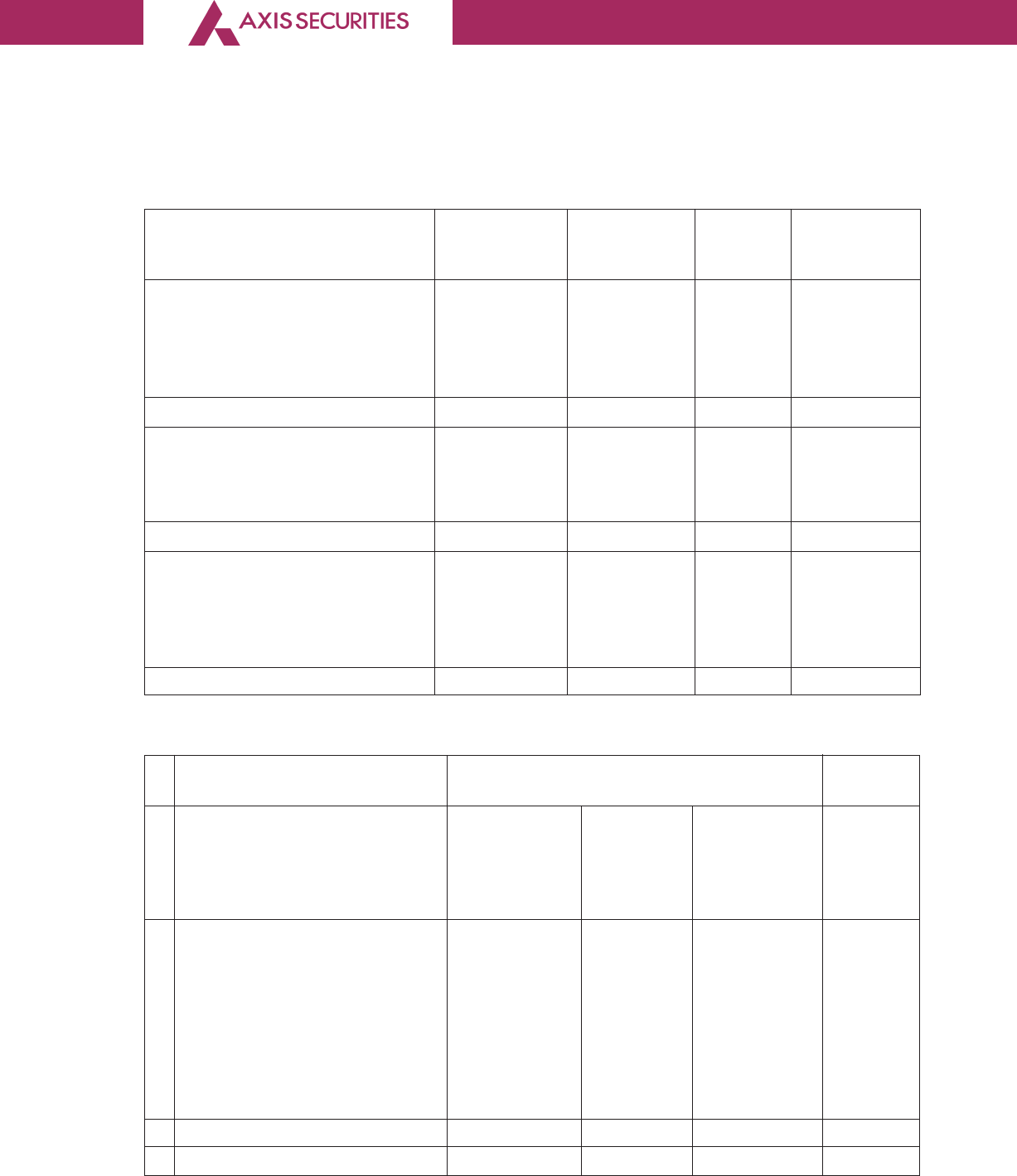
22
A Subsidiary of AXIS BANK
V. INDEBTEDNESS:
Indebtedness of the Company including interest outstanding/accrued but not due for payment:
Secured Loans Unsecured Deposits Total
excluding Loans Indebtedness
deposits
Indebtedness at the beginning ––––
of the financial year
i) Principal Amount
ii) Interest due but not paid
iii) Interest accrued but not due
Total (i+ii+iii) ––––
Change in Indebtedness during
the financial year
• Addition – – – –
• Reduction – – – –
Net Change ––––
Indebtedness at the end of the ––––
financial year
i) Principal Amount
ii) Interest due but not paid
iii) Interest accrued but not due
Total (i+ii+iii) ––––
VI. REMUNERATION OF DIRECTORS AND KEY MANAGERIAL PERSONNEL :
A. Remuneration to Managing Director, Whole-time Directors and/or Manager: (Figures is Rs.)
Sr. Particulars Name of MD / WTD / Manager Total
No. of Remuneration Amount
Arun Thukral, Gop Kumar Anand Kumar
Managing Bhaskaran, Shaha,
Director & CEO Managing Whole-Time
(01.04.2019- Director Director
31.12.2019) & CEO
1. Gross salary
(a) Salary as per provisions 14,072,123 10,427,788 9,425,068 3,39,24,979
contained in section 17(1)
of the Income-tax Act, 1961
(b) Value of perquisites u/s
17(2) Income-tax Act, 1961
(c) Profits in lieu of salary under
section 17(3) Income-tax
Act, 1961
2. Stock Option
3. Sweat Equity
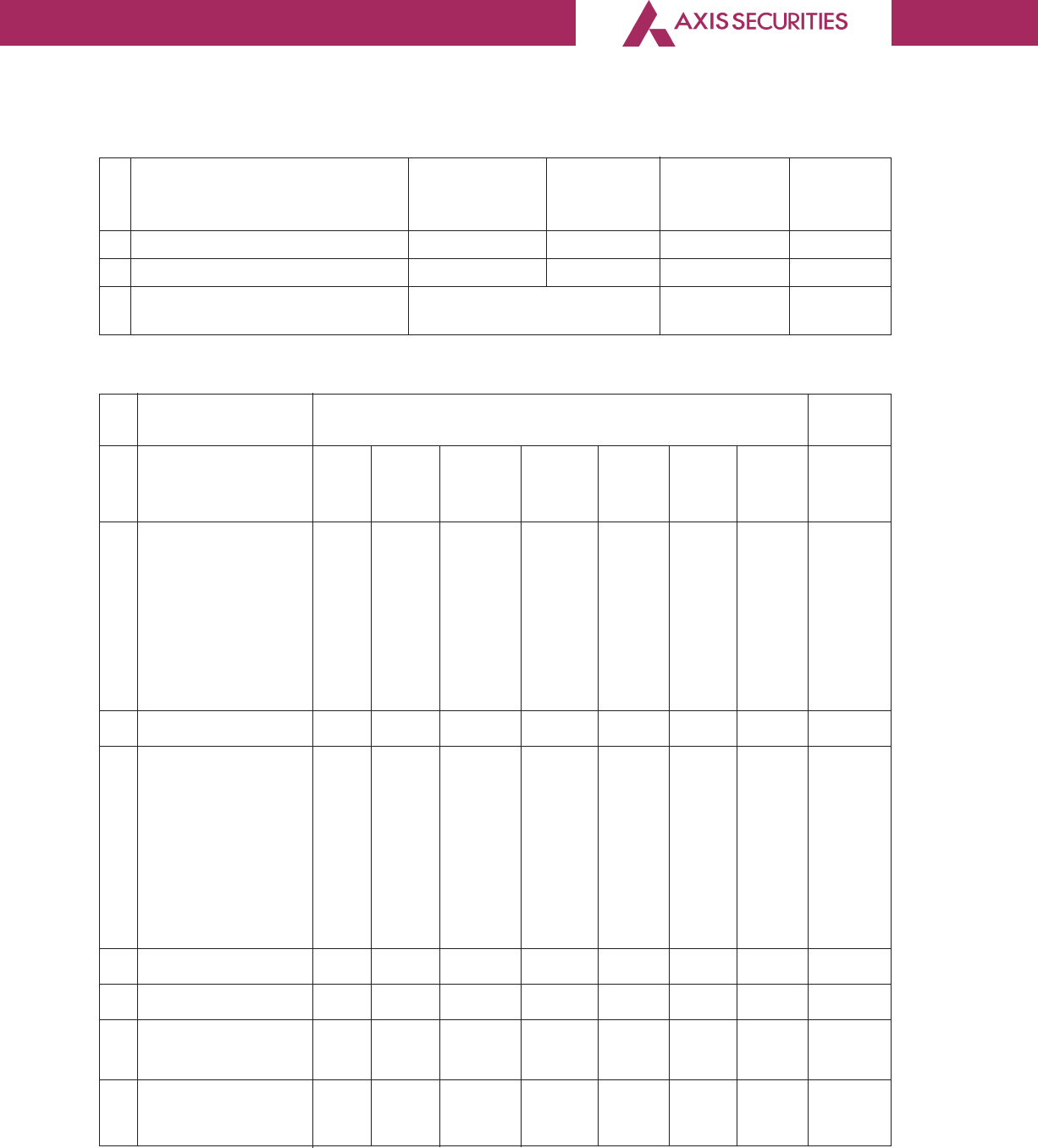
23
A Subsidiary of AXIS BANK
4. Commission
- as % of profit – – –
- others, specify.... – – –
5. Others, please specify – – –
Total (A) 14,072,123 10,427,788 9,425,068 3,39,24,979
Ceiling as per the Act
5% of the net Profit
5% of the 10% of the
net Profit net Profit
B. Remuneration to other directors:
Sr. Particulars of Name of Directors Total
No. Remuneration Amount
Rajiv Pralay Babu Rao Nithya Bhumika Ramesh Jagdeep
Anand Mondal Busi Easwaran Batra Kumar
Malla-
Bammi
reddy
1. Independent – – 6,50,000 1,50,000 3,50,000 300,000 – 14,50,000
Directors
• Fee for attending
Board & Committee
meetings
• Commission
• Others, please
specify
Total (1) – – 6,50,000 1,50,000 3,50,000 300,000 – 14,50,000
2. Other Non-Executive
Directors
• Fee for attending
Board & Committee
meetings
• Commission
• Others, please
specify
Total (2) –
Total (B)=(1+2) – – 6,50,000 1,50,000 3,50,000 300,000 – 14,50,000
Total Managerial –
Remuneration
Overall Ceiling as – – – –
–
––
1% of the
per the Act
net profit
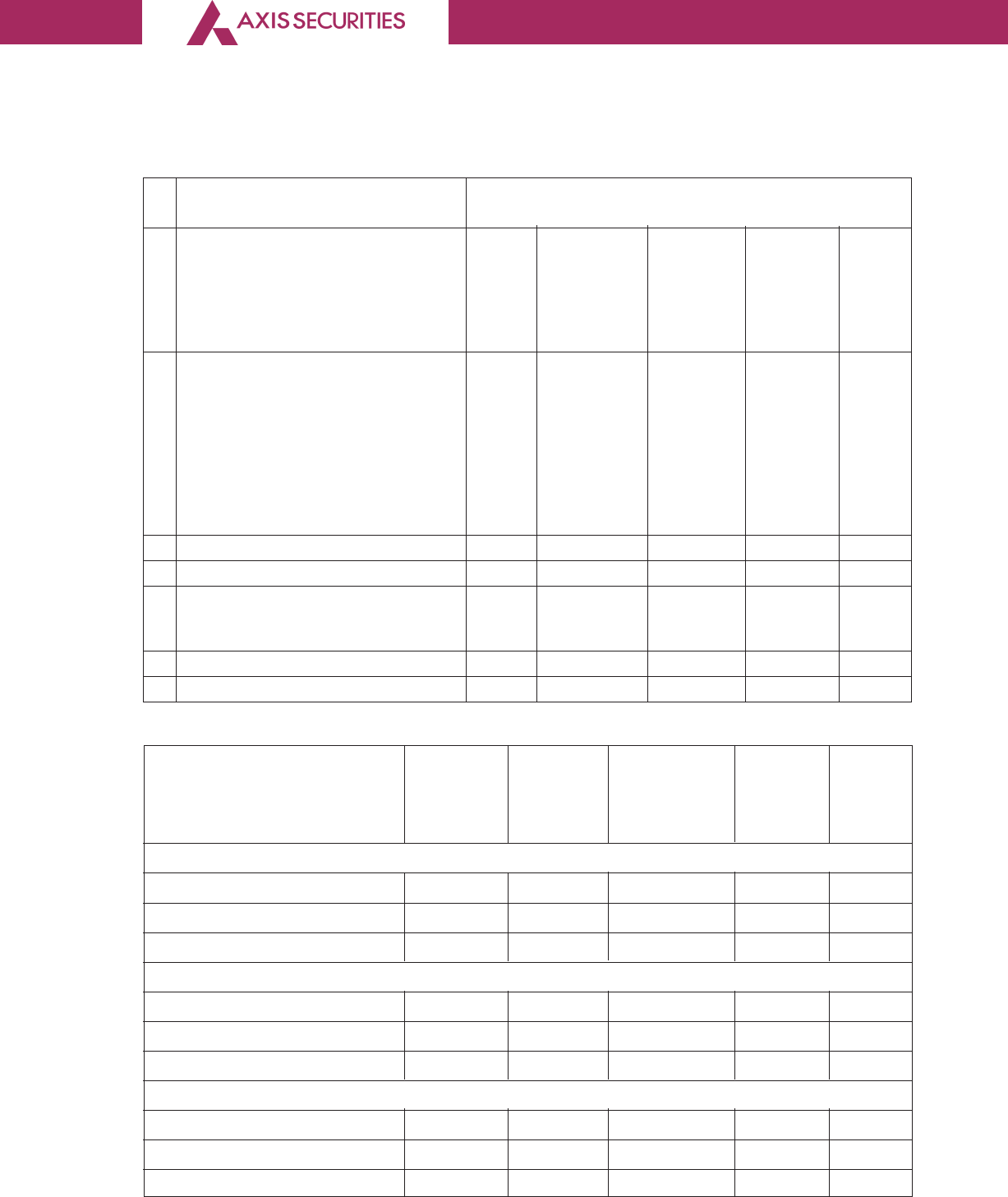
24
A Subsidiary of AXIS BANK
C. Remuneration to Key Managerial Personnel other than MD/Manager/WTD (Figures is Rs.)
Sr. Particulars of Remuneration Key Managerial Personnel
no.
CEO Ms. Lovelina Mr. Divya Mr. Hemant Total
Faroz, Poojari, Patel,
Company Company CFO
Secretary Secretary
01.04.2019 30.01.2020-
31.03.2020
1. Gross salary
(a) Salary as per provisions _ 9,69,514 3,03,992 58,66,047 71,39,553
contained in section 17(1)
of the Income-tax Act, 1961
(b) Value of perquisites u/s 17(2)
Income-tax Act, 1961
(c) Profits in lieu of salary under
section 17(3) Income-tax
Act, 1961
2. Stock Option – – – –
3. Sweat Equity – – – –
4. Commission
- as % of profit – – – –
- others, specify.... – – – –
5. Others, please specify – – – –
Total _ 9,69,514 3,03,992 58,66,047 71,39,553
VII. PENALTIES / PUNISHMENT/ COMPOUNDING OF OFFENCES: NIL
Type Section of Brief Details of Authority Appeal
the Description Penalty / [RD/NCLT/ made, if
Companies Punishment / Court] any (give
Act Compounding details)
fees imposed
A. COMPANY
Penalty – – – – –
Punishment – – – – –
Compounding – – – – –
B. DIRECTORS
Penalty – – – – –
Punishment – – – – –
Compounding – – – – –
C. OTHER OFFICERS IN DEFAULT
Penalty – – – – –
Punishment – – – – –
Compounding – – – – –
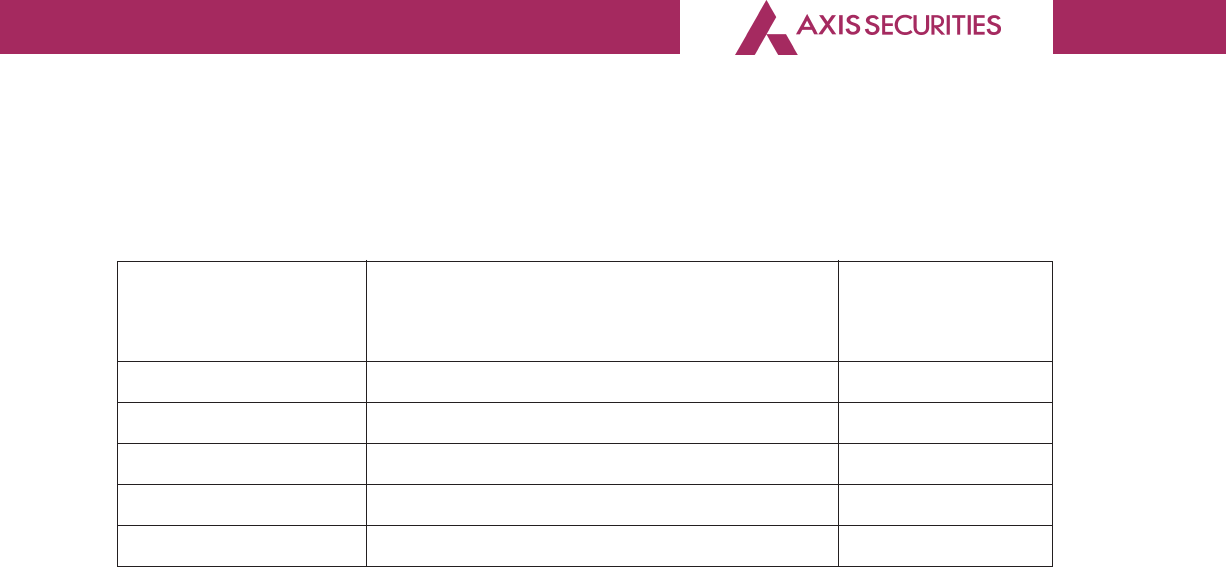
25
A Subsidiary of AXIS BANK
ANNEXURE-B
PARTICULARS OF FOREIGN EXCHANGE OUTFLOWS
Name of the Party Particulars of Purpose Amount of outflow
(in Rupees)
FY 2019-20
Logmein Ireland Limited Membership and subscription 558,499
Screener Membership and subscription 300,000
Apnic Pty Ltd Australia Membership and subscription 90,159
CHART IQ Membership and subscription 544,725
Total 1,493,383
For and on Behalf of the Board of Directors
Pralay Mondal
Chairman
DIN: 00117994
Address: Flat No. 1901 & 1902, Wing E,
Rustomjee Paramount, 18th Road,
Vithaldas Nagar, Khar West, Mumbai 400052
Place : Mumbai
Date : April 23, 2020
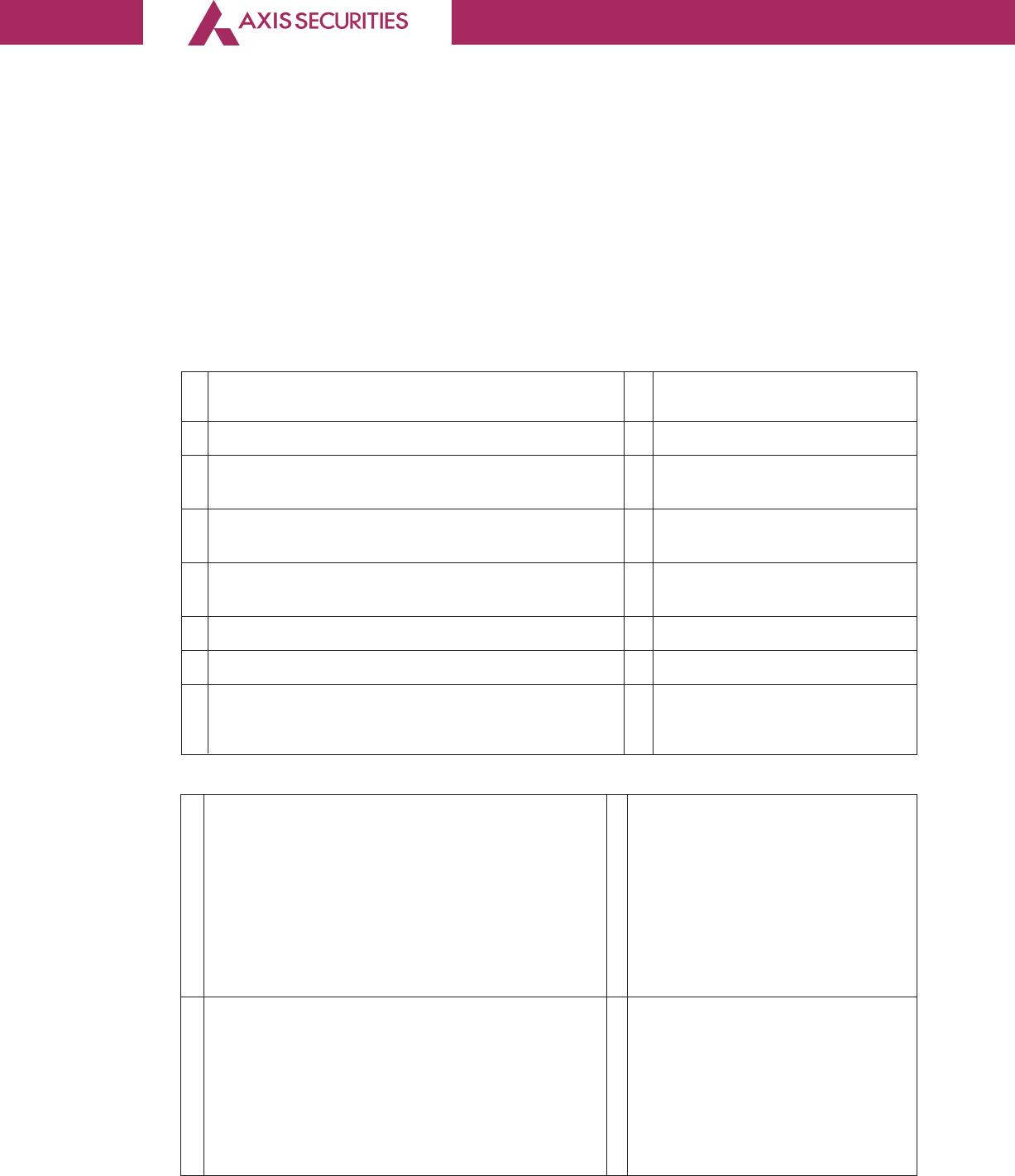
26
A Subsidiary of AXIS BANK
ANNEXURE - C
FORM AOC - 2
(Pursuant to Clause (h) of sub-section (3) of Section 134 of the Act and Rule 8(2) of the
Companies (Accounts) Rules, 2014)
Form for disclosure of particulars of contracts/arrangements entered into by the Company with
related parties referred to in sub–section (1) of section 188 of the Companies Act, 2013 including
certain arm’s length transactions under third proviso thereto:
1. Details of contracts or arrangements or transactions not at arm’s length basis
a) Name (s) of the related party and nature of
relationship : NIL
b) Nature of contracts/arrangements/transactions : NIL
c) Duration of the contracts / arrangements /
transactions : NIL
d) Salient terms of the contracts or arrangements
or transactions including the value, if any : NIL
e) Justification for entering into such contracts or
arrangements or transactions : NIL
f) Date(s) of approval by the Board : NIL
g) Amount paid as advances, if any : NIL
h) Date on which the special resolution was passed
in general meeting as required under first proviso : NIL
to Section 188
2. Details of material contracts or arrangement or transactions at arm’s length basis
a) Name (s) of the related party and nature of : 1. Axis Finance Limited
relationship (Group Company)
2. Axis Asset Management
Company Limited (Common
director / Group Company)
3. Axis Bank Limited
(Holding Company)
4. Axis Capital Limited
(Group Company)
b) Nature of contracts/arrangements/transactions : 1. Availing and Rendering of
services
2. Availing and Rendering of
services
3. Availing and Rendering of
services & Sale, Purchase or
supply of any goods or
materials
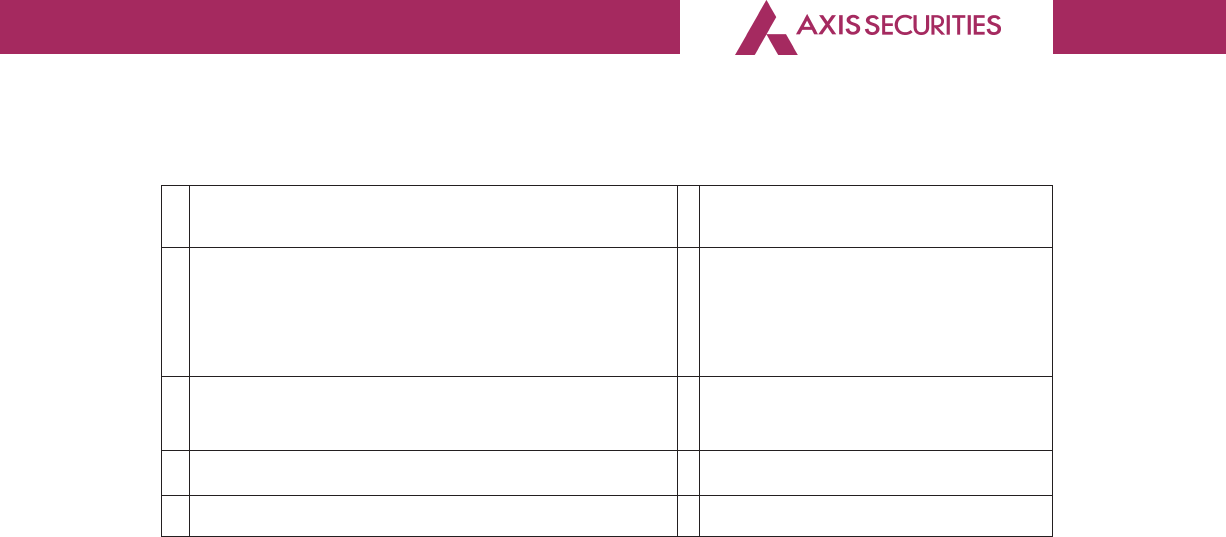
27
A Subsidiary of AXIS BANK
4. Availing and Rendering of
services
c) Duration of the contracts / arrangements / : 1. Continuous
transactions 2. Continuous
3. Continuous
4. Continuous
d) Salient terms of the contracts or arrangements : 1. Refer Financial statements
or transactions including the value, if any
e) Date (s) of approval by the Board, if any : 12.04.2019 & 18.10.2019
f) Amount paid as advances, if any : NIL
For and on Behalf of the Board of Directors
Pralay Mondal
Chairman
DIN: 00117994
Address: Flat No. 1901 & 1902, Wing E,
Rustomjee Paramount, 18th Road,
Vithaldas Nagar, Khar West, Mumbai 400052
Place : Mumbai
Date : April 23, 2020
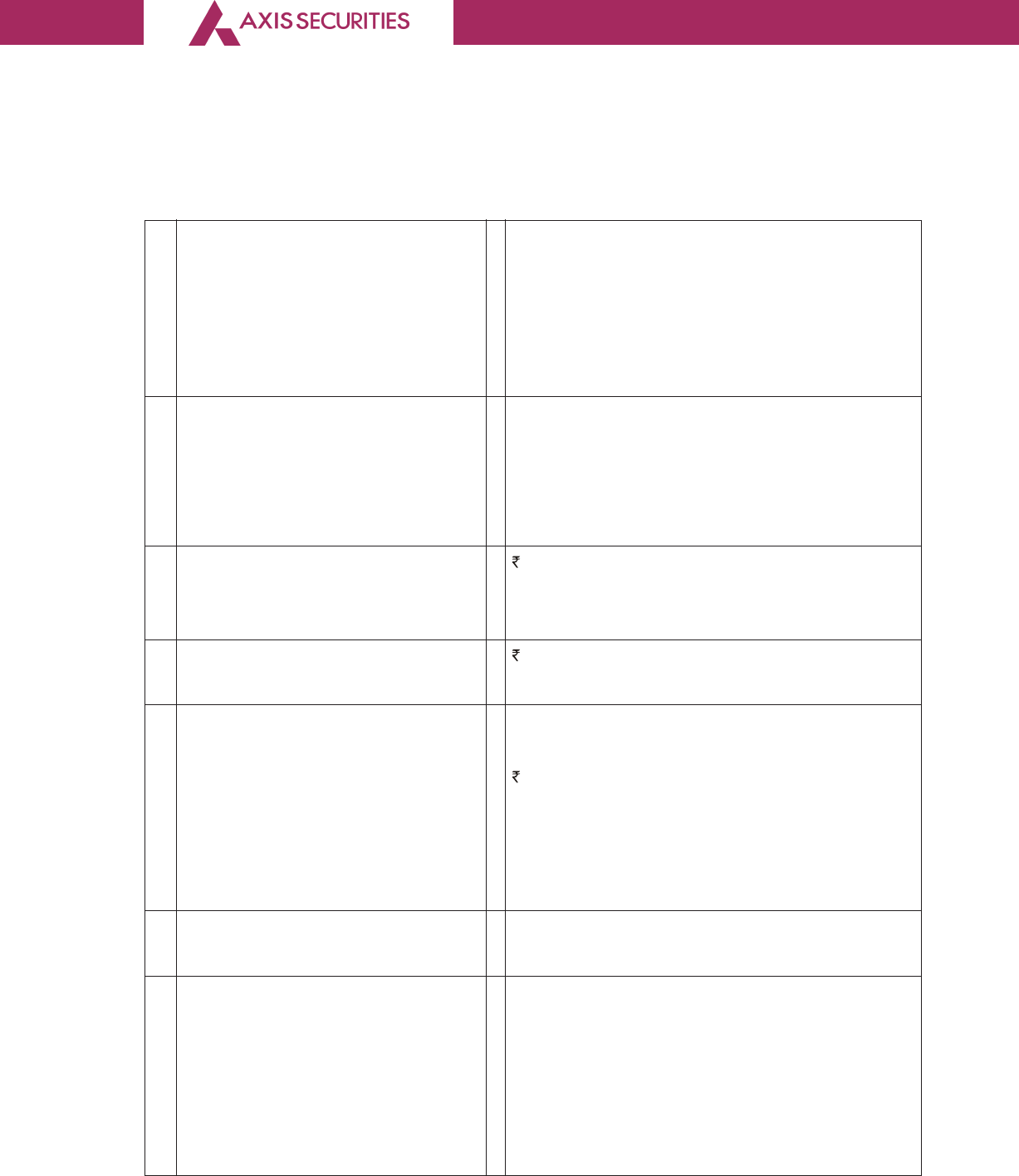
28
A Subsidiary of AXIS BANK
ANNEXURE - D
Annual Report on CSR Initiatives Pursuant to Section 135 of the Act & Rules made thereunder
1. Brief Outline of the CSR Policy : The Company’s Corporate Social Responsibility
(CSR) activities reflect its philosophy of helping to
build a better, more sustainable society by taking
into account the societal needs of the Community.
For detailed policy, please refer our
website : www.axissecurities.in
2. The Composition of the CSR : Mr. Ramesh Kumar Bammi – Chairman
Committee Mr. Gop Kumar Bhaskaran – Member
Mr. Jagdeep Mallareddy – Member
Ms. Babu Rao Busi – (Member Independent
Director)
3. Average Net Profit of the : 968,347,370/-
Company for last 3 financial
years
4. The Prescribed CSR expenditure : 1,93,66,947/-
(2% of amount)
5. Details of CSR activities/projects
undertaken during the year :
a. Total amount to be spent : 1,93,66,947/-
for the financial year
b. Amount unspent, if any : NIL
c. Manner in which the amount : Annexure D. 1
spent during the financial year
6. Reason for not spending the : NIL
amount
7. Responsibility statement by the : The CSR Committee confirms that the implemen-
CSR Committee that the CSR tation and monitoring of the CSR Policy, is in
Committee states that the compliance with the CSR objectives and Policy
implementation and monitoring of the Company.
of the CSR Policy, is in compliance
with CSR objectives and Policy of
the Company
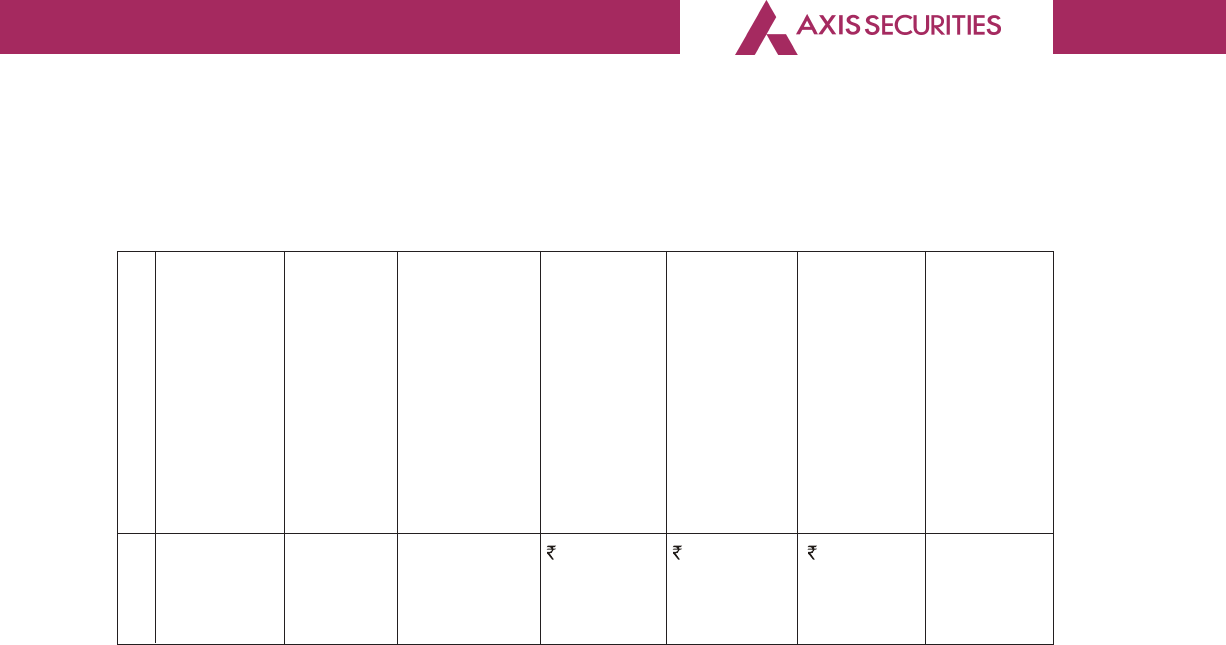
29
A Subsidiary of AXIS BANK
c. Manner in which the amount spent during the financial year is detailed below:
Sr. CSR Project Sector in Projects or Amount Amount Cumulative Amount
No. or activity which the programs (1) outlay spent on expenditure spent :
identified Project is Local area (budget) the projects upto the Direct or
covered or other (2) projects or or programs reporting through
Specify the programs Sub-heads: period implemen-
State and wise (1) Direct ting agency
district where expenditure
projects or on projects
programs or programs
was (2) Overheads
undertaken
1. Rural Livelihood Guwahati 1,93,66,947 1,93,66,947 1,93,66,947
Livelihood enhance- Through
mission- ment implementing
Kabil projects agency
Ramesh Kumar Bammi Gopkumar Bhaskaran
Chairman, CSR Committee Managing Director & CEO
DIN: 03411046 DIN: 07223999
Address: S 285, Third Floor, Address: Flat No. 1303/13 Floor,
Greater Kailash, D Wing, RNA Continental,
Part 2, New Delhi 110048 Chembur East, Mumbai - 400071
Place : New Delhi Place : Mumbai
Date : April 23, 2020 Date : April 23, 2020
ANNEXURE - D1

30
A Subsidiary of AXIS BANK
ANNEXURE - E
Form No. MR-3
SECRETARIAL AUDIT REPORT
FOR THE FINANCIAL YEAR ENDED MARCH 31, 2018
[Pursuant to Section 204(1) of the Companies Act, 2013 and Rule no. 9 of the Companies
(Appointment and Remuneration of Managerial Personnel) Rules, 2014]
To
The Members,
Axis Securities Limited
We have conducted a Secretarial Audit of the compliance of applicable statutory provisions and
the adherence to good corporate practices by Axis Securities Limited. CIN No-
U74992MH2006PLC163204 (hereinafter called the ‘Company’) during the financial year from 1
st
April 2019 to 31
st
March 2020, (‘the year’/ ‘audit period’/ ‘period under review’).
We conducted the Secretarial Audit in a manner that provided us a reasonable basis for evaluating
the company’s corporate conducts/statutory compliances and expressing our opinion thereon.
We are issuing this report based on :
(i) our verification of the books, papers, minute books, soft copy as provided by the company
and other records maintained by the company and furnished to us, forms/ returns filed and
compliance related action taken by the company during the financial year ended 31
st
March
2020 as well as before the issue of this report,
(ii) Our observations shared during our visits to the Corporate office of the Company,
(iii) Compliance Certificates confirming Compliance with all laws applicable to the company
given by Key Managerial Personnel / senior managerial Personnel of the company and taken
on record by Audit Committee / Board of Directors,and
(iv) Representations made, documents shown and information provided by the company, its
officers, agents, and authorised representatives during our conduct of secretarial Audit.
We hereby report that in our opinion, during the audit period covering the financial year ended on
31
st
March 2020 the Company has:
(i) complied with the statutory provisions listed hereunder, and
(ii) Board-processes and compliance mechanism are in place to the extent, in the manner and
subject to the reporting made hereinafter.

31
A Subsidiary of AXIS BANK
The members are requested to read this report along with our letter of even date annexed to this
report as Annexure - A.
1. Compliance with specific statutory provisions
We further report that:
1.1 We have examined the books, papers, minute books and other records maintained by the
Company and the forms, returns, reports, disclosures and information filed or disseminated
during the year according to the applicable provisions/clauses of:
(i) The Companies Act, 2013 and the Rules made thereunder;
(ii) The Securities Contracts (Regulation) Act, 1956 and the Rules made thereunder;
(iii) The Depositories Act, 1996 and the Regulations and Bye-laws framed thereunder;
(iv) The following Regulations Guidelines prescribed under the Securities and Exchange Board
of India Act, 1992 (‘SEBI Regulations’):
(a) The Securities and Exchange Board of India (Prohibition of Insider Trading)
Regulations, 2015; and
(b) The Securities and Exchange Board of India (Registrars to an Issue and Share Transfer
Agents) Regulations, 1993 regarding the Companies Act,2013 and dealing with
client
(c) The Securities and Exchange Board of India (Stock Brokers) Regulations, 1992;
(d) The Securities and Exchange Board of India (Research Analysts) Regulations, 2014;
(e) The Securities and Exchange Board of India (Portfolio Managers) Regulation, 1993.
(v) Secretarial Standards issued by The Institute of Company Secretaries of India(Secretarial
standards).
1.2 During the period under review, and also considering the compliance related action taken
by the company after 31
st
March, 2020 but before the issue of this report, the company has, to
the best of our knowledge and belief and based on the records, information, explanations
and representations furnished to us :
(i) Complied with the applicable provisions/clauses of the Act, Rules, SEBI Regulations and
Agreements mentioned under of paragraph 1.1

32
A Subsidiary of AXIS BANK
(ii) Generally complied with the applicable provisions/ clauses of :
(a) TheAct and rules mentioned under paragraph 1.1 (i);
(b) The Secretarial standards on meetings of the Board of Directors (SS-1) and Secretarial
standards on General Meetings (SS-2) mentioned under paragraph 1.1 (vi) above
to the extent applicable to Board meetings held during the year, the 13
th
Annual
General Meeting held on 7
th
June 2019 and Extra Ordinary General Meeting held
on September 25, 2019 and January 8, 2020 and the resolution passed by
circulation.The Compliance of the provisions of the Rules made under the Act
[paragraph 1.1(i)] and SS-1 [paragraph 1.1(vi) with regard to the Board meetings
held through video conferencing on various dates were verified based on the
minutes of the meetings , shown to us , by the company.
1.3 We are informed that, during the year, the company was not required to initiate any
compliance related action in respect of the following laws/rules/regulations/standards, and
was consequently not required to maintain any books, papers, minute books or other records
or file any form/returns thereunder:
(i) The Securities and Exchange Board of India (Substantial Acquisition of Shares and
Takeovers) Regulations, 2011;
(ii) The Securities and Exchange Board of India (Issue of Capital and Disclosure Requirements)
Regulations, 2009;
(iii) The Securities and Exchange Board of India (Listing Obligations and Disclosure
Requirements) Regulations, 2015;
(iv) The Securities and Exchange Board of India (Share Based Employee Benefits) Regulations,
2014;
(v) The Securities and Exchange Board of India (Issue and Listing of Debt Securities)
Regulations, 2008;
(vi) The Securities and Exchange Board of India (Delisting of Equity Shares) Regulations, 2009;
(vii) The Securities and Exchange Board of India (Buyback of Securities) Regulations, 1998; and
(viii) Foreign Exchange Management Act, 1999 and the Rules and Regulations made
thereunder to the extent of Foreign Direct Investment, Overseas Direct Investment and
External Commercial Borrowings;
1.4 There was no other law that was specifically applicable to the company, considering the
nature of its business. Hence the requirement to report on compliance with any other specific
law under paragraphs 1.1 and 1.2 above did not arise.

33
A Subsidiary of AXIS BANK
2. Board processes:
We further report that:
2.1 The Board of Directors of Company as on 31
st
March, 2020 comprised of:
(i) Two Executive Director,
(ii) Three Non-Executive Non Independent Director, and
(iii) Two Non-Executive Independent Directors, including a woman Independent Director
2.2 The processes relating to the following changes in the composition of the board of Directors
during the year were carried out in compliance with the provisions of the Act :
(i) Re-appointment of Mr Arun Thukral (DIN:03043072) as MD & CEO for term of three years
from May 25, 2019 to May 24, 2022 was approved at board meeting held on April 12,
2019.
(ii) Appointment of Mr Pralay Mondal (DIN: 00117994 ) as Additional Director of the company
was approved at the board meeting held on held on April 12, 2019 and the appointment
was regularised at 13
th
AGM
(iii) Resignation of Ms Nithya Eswaran(DIN:03605392), ID of the company was received on
April 12, 2019
(iv) Resignation of Mr Rajiv Anand(DIN:02541753) as Director of the company was accepted
by company on May 9, 2019 & Noted by passing circular resolution on May 13, 2019
(v) Resignation of Ms Lovelina Faroz, Company Secretary of the company was received by
the company on July 30, 2019 and was effective from October 29, 2019
(vi) Appointment of Ms Bhumika Batra (DIN: 03502004) as additional director(Independent)
of the company was approved at the board meeting held on July 16, 2019 and the
appointment was regularised at the Extra-ordinary General Meeting held on January 8,
2020
(vii) Re-appointment Mr Jagdeep Mallareddy (DIN: 07492539 ) as Director retiring by rotation
at 13
th
AGM,
(viii) Appointment of Mr. Gopkumar Bhaskaran (DIN:07223999 ) as MD & CEO for term starting
from January 1, 2020 to December 31, 2022 was approved at board meeting held on
October 18, 2019 and was approved by the shareholders at the Extra-ordinary General
Meeting held on January 8, 2020

34
A Subsidiary of AXIS BANK
(ix) Resignation of Mr Arun Thukral (DIN:03043072 ) as MD & CEO with effect from December
31, 2019 was taken on record at the board meeting held on October 18, 2019.
(x) Re-appointment of Mr Anand Kumar Saha (DIN: 02421213) as WTD & KMP for term of
three years from March 1, 2020 to February 28, 2023 was approved at board meeting
held on January 15, 2020
(xi) Appointment of Ms Divya Poojari as Company Secretary was approved by board of
directors at the board meeting held on January 15, 2020 and was effective from January
30, 2020
2.3 Adequate notice was given to all the directors to enable them to plan their schedule for the
Board meetings, except for one meeting which was convened at a shorter notice to transact
urgent business.
2.4 Notice of Board meetings was sent to directors at least seven days in advance as required
under Section 173(3) of the Act and SS-1.
2.5 Agenda and detailed notes on agenda were sent to the directors at least seven days before
the board meetings.
2.6 Agenda and detailed notes on agenda for the following items were either circulated
separately less than seven days before or at the Board meetings and consent of the Board for
so circulating them was duly obtained as required under SS-1:
(i) Supplementary agenda notes and annexures in respect of unpublished price sensitive
information such as audited financial statement/results, unaudited financial results and
connected papers, and
(ii) Additional subjects/information/presentations and supplementary notes.
2.7 A system exists for directors to seek and obtain further information and clarifications on the
agenda items before the meetings and for their meaningful participation at the meetings.
2.8 We note from the minutes verified that, at the Board meetings held during the year:
(i) Majority decisions were carried through; and
(ii) No dissenting views were expressed by any Board member on any of the subject matters
discussed, that were required to be captured and recorded as part of the minutes.
3. Compliance mechanism
There are reasonably adequate systems and processes in the company, commensurate with
the company’s size and operations, to monitor and ensure compliance with applicable laws,

35
A Subsidiary of AXIS BANK
rules, regulations and guidelines. There is scope for further improvement in the compliance
systems and processes, Commensurate with the increasing statutory requirements and growth
in operations.
4. Specific events/ actions
4.1 During the year, the following specific events/ actions having a major bearing on the
company’s affairs took place, in pursuance of the above referred laws, rules, regulations and
standards:
(i) Approval of members was accorded by way of ordinary resolution passed at Extra
Ordinary General Meeting held on September 25, 2019 to Increase the Authorised Share
Capital of the company from 150 crore to 250 crore
(ii) Approval of members was accorded by way of special resolution passed at Extra Ordinary
General Meeting held on September 25, 2019 for Alteration of Memorandum of
Association& Alteration of Association.
For BNP & Associates
Company Secretaries
B. Narasimha
Place : Mumbai Partner
Date : 30.04.2020 FCS 1303/C.P. No. 10440
Peer Review No-637/2019
UDIN- F001303B000190151
Firm Reg No-P2014MH037400
Note: This report is to be read with our letter of even date which is annexed as Annexure A and
forms an integral part of this report.

36
A Subsidiary of AXIS BANK
Annexure A
To,
The Members,
Axis Securities Limited
Secretarial Audit Report of even date is to be read along with this letter.
1. The Company’s management is responsible for maintenance of secretarial records and
compliance with the provisions of corporate and other applicable laws, rules, regulations
and standards. Our responsibility is to express an opinion on the secretarial records produced
for our audit.
2. We have followed such audit practices and processes as we considered appropriate to obtain
reasonable assurance about the correctness of the contents of the secretarial records.
3. While forming an opinion on compliance and issuing this report, we have also considered
compliance related action taken by the company after 31
st
March 2020 but before the issue
of this report.
4. we have considered compliance related actions taken by the company based on
independent legal /professional opinion obtained as being in compliance with law.
5. We have verified the secretarial records furnished to us on a test basis to see whether the
correct facts are reflected therein. We also examined the compliance procedures followed
by the company on a test basis. We believe that the processes and practices we followed,
provides a reasonable basis for our opinion.
6. We have not verified the correctness and appropriateness of financial records and Books of
Accounts of the Bank.
7. we have obtained the management’s representation about the compliance of laws, rules
and regulations and happening of events, wherever required.
8. Our Secretarial Audit Report is neither an assurance as to the future viability of the Bank nor of
the efficacy or effectiveness with which the management has conducted the affairs of the
Company.
For BNP & Associates
Company Secretaries
B. Narasimha
Place : Mumbai Partner
Date : 30.04.2020 FCS 1303/C.P. No. 10440
Peer Review No-637/2019
UDIN- F001303B000190151
Firm Reg No-P2014MH037400

37
A Subsidiary of AXIS BANK
INDEPENDENT AUDITORS’ REPORT
To the Members of Axis Securities Limited
Report on the Financial Statements
Opinion
We have audited the accompanying Ind AS financial statements of Axis Securities Limited (“the
Company”), which comprise the Balance sheet as at March 31 2020, the Statement of Profit and
Loss, including the statement of Other Comprehensive Income, the Cash Flow Statement and
the Statement of Changes in Equity for the year then ended, and notes to the financial statements,
including a summary of significant accounting policies and other explanatory information.
In our opinion and to the best of our information and according to the explanations given to us,
the aforesaid Ind AS financial statements give the information required by the Companies
Act, 2013, as amended (“the Act”) in the manner so required and give a true and fair view in
conformity with the accounting principles generally accepted in India, of the state of affairs of
the Company as at March 31, 2020, its profitincluding other comprehensive income, its cash flows
and the changes in equity for the year ended on that date.
Basis for Opinion
We conducted our audit of the Ind AS financial statements in accordance with the Standards on
Auditing (SAs),as specified under section 143(10) of the Act. Our responsibilities under those
Standards are further described in the ‘Auditor’s Responsibilities for the Audit of theInd AS Financial
Statements’ section of our report. We are independent of the Company in accordance with the
‘Code of Ethics’ issued by the Institute of Chartered Accountants of India together with the ethical
requirements that are relevant to our audit of the financial statements under the provisions of the
Act and the Rules thereunder, and we have fulfilled our other ethical responsibilities in accordance
with these requirements and the Code of Ethics. We believe that the audit evidence we have
obtained is sufficient and appropriate to provide a basis for our audit opinion on the Ind AS financial
statements.
Other Information
The Company’s Board of Directors is responsible for the other information. The other information
comprises the information included in the Annualreport,but does not include the Ind AS financial
statements and our auditor’s report thereon.
Our opinion on the Ind AS financial statements does not cover the other information and we do
not express any form of assurance conclusion thereon.
In connection with our audit of the Ind AS financial statements, our responsibility is to read the
other information and, in doing so, consider whether such other information is materially inconsistent
with the financial statements or our knowledge obtained in the audit or otherwise appears to be
materially misstated. If, based on the work we have performed, we conclude that there is a
material misstatement of this other information, we are required to report that fact. We have
nothing to report in this regard.
Responsibilities of Management for the Ind AS Financial Statements
The Company’s Board of Directors is responsible for the matters stated in Section 134(5) of the Act
with respect to the preparation of these Ind ASfinancial statements that give a true and fair view
of the financial position, financial performance including other comprehensive income, cash

38
A Subsidiary of AXIS BANK
flows and changes in equity of the Company in accordance with the accounting principles
generally accepted in India, including the Indian Accounting Standards (Ind AS) specified under
section 133 of the Act, read with the Companies (Indian Accounting Standards) Rules, 2015, as
amended. This responsibility also includes maintenance of adequate accounting records in
accordance with the provisions of the Act for safeguarding of the assets of the Company and for
preventing and detecting frauds and other irregularities; selection and application of appropriate
accounting policies; making judgments and estimates that are reasonable and prudent; and the
design, implementation and maintenance of adequate internal financial controls, that were
operating effectively for ensuring the accuracy and completeness of the accounting records,
relevant to the preparation and presentation of the Ind AS financial statements that give a true
and fair view and are free from material misstatement, whether due to fraud or error.
In preparing the Ind AS financial statements, management is responsible for assessing the
Company’s ability to continue as a going concern, disclosing, as applicable, matters related to
going concern and using the going concern basis of accounting unless management either intends
to liquidate the Company or to cease operations, or has no realistic alternative but to do so.
Those Board of Directors are also responsible for overseeing the Company’s financial reporting
process.
Auditor’s Responsibilities for the Audit of the Ind AS Financial Statements
Our objectives are to obtain reasonable assurance about whether the Ind AS financial statements
as a whole are free from material misstatement, whether due to fraud or error, and to issue an
auditor’s report that includes our opinion. Reasonable assurance is a high level of assurance but
is not a guarantee that an audit conducted in accordance with SAs will always detect a material
misstatement when it exists. Misstatements can arise from fraud or error and are considered material
if, individually or in the aggregate, they could reasonably be expected to influence the economic
decisions of users taken on the basis of these Ind AS financial statements.
As part of an audit in accordance with SAs, we exercise professional judgment and maintain
professional skepticism throughout the audit. We also:
• Identify and assess the risks of material misstatement of the Ind AS financial statements, whether
due to fraud or error, design and perform audit procedures responsive to those risks, and
obtain audit evidence that is sufficient and appropriate to provide a basis for our opinion. The
risk of not detecting a material misstatement resulting from fraud is higher than for one resulting
from error, as fraud may involve collusion, forgery, intentional omissions, misrepresentations, or
the override of internal control.
• Obtain an understanding of internal control relevant to the audit in order to design audit
procedures that are appropriate in the circumstances. Under section 143(3)(i) of the Act, we
are also responsible for expressing our opinion on whether the Company has adequate internal
financial controls system in place and the operating effectiveness of such controls.
• Evaluate the appropriateness of accounting policies used and the reasonableness of
accounting estimates and related disclosures made by management.
• Conclude on the appropriateness of management’s use of the going concern basis of
accounting and, based on the audit evidence obtained, whether a material uncertainty

39
A Subsidiary of AXIS BANK
exists related to events or conditions that may cast significant doubt on the Company’s ability
to continue as a going concern. If we conclude that a material uncertainty exists, we are
required to draw attention in our auditor’s report to the related disclosures in the financial
statements or, if such disclosures are inadequate, to modify our opinion. Our conclusions are
based on the audit evidence obtained up to the date of our auditor’s report. However, future
events or conditions may cause the Company to cease to continue as a going concern.
• Evaluate the overall presentation, structure and content of the Ind AS financial statements,
including the disclosures, and whether the Ind AS financial statements represent the underlying
transactions and events in a manner that achieves fair presentation.
We communicate with those charged with governance regarding, among other matters, the
planned scope and timing of the audit and significant audit findings, including any significant
deficiencies in internal control that we identify during our audit.
We also provide those charged with governance with a statement that we have complied with
relevant ethical requirements regarding independence, and to communicate with them all
relationships and other matters that may reasonably be thought to bear on our independence,
and where applicable, related safeguards.
Report on Other Legal and Regulatory Requirements
1. As required by the Companies (Auditor’s Report) Order, 2016 (“the Order”), issued by the
Central Government of India in terms of sub-section (11) of Section 143 of the Act, we give in
the “Annexure 1” a statement on the matters specified in paragraphs 3 and 4 of the Order.
2. As required by Section 143(3) of the Act, we report that:
(a) We have sought and obtained all the information and explanations which to the best of
our knowledge and belief were necessary for the purposes of our audit;
(b) In our opinion, proper books of account as required by law have been kept by the
Company so far as it appears from our examination of those books;
(c) The Balance Sheet, the Statement of Profit and Loss including the Statement of Other
Comprehensive Income, the Cash Flow Statement and Statement of Changes in Equity
dealt with by this Report are in agreement with the books of account;
(d) In our opinion, the aforesaid Ind AS financial statements comply with the Accounting
Standards specified under Section 133 of the Act, read with Companies (Indian
Accounting Standards) Rules, 2015, as amended;
(e) On the basis of the written representations received from the directors as on March 31,
2020 taken on record by the Board of Directors, none of the directors is disqualified as on
March 31, 2020 from being appointed as a director in terms of Section 164 (2) of the Act;

40
A Subsidiary of AXIS BANK
(f) With respect to the adequacy of the internal financial controls over financial reporting
of the Company with reference to these Ind AS financial statements and the operating
effectiveness of such controls, refer to our separate Report in “Annexure 2” to this report;
(g) In our opinion, the managerial remuneration for the year ended March 31, 2020 has
been paid by the Company to its directors in accordance with the provisions of section
197 read with Schedule V to the Act;
(h) With respect to the other matters to be included in the Auditor’s Report in accordance
with Rule 11 of the Companies (Audit and Auditors) Rules, 2014, as amended in our
opinion and to the best of our information and according to the explanations given to
us:
i. The Company has disclosed the impact of pending litigations on its financial position
in its Ind AS financial statements – Refer Note 34 to theInd AS financial statements;
ii. The Company did not have any long-term contracts including derivative contracts
for which there were any material foreseeable losses;
iii. There were no amounts which were required to be transferred to the Investor
Education and Protection Fund by the Company.
For S. R. Batliboi & Co. LLP
Chartered Accountants
ICAI Firm Registration Number : 301003E / E300005
per Jitendra H. Ranawat
Partner
Membership No.: 103380
Place of Signature : Mumbai
Date : 23 April 2020

41
A Subsidiary of AXIS BANK
Annexure 1 referred to under the heading “Report on other legal and regulatory requirements” of
our report of even date
Re: Axis Securities Limited (‘the Company’)
(i) (a) The Company has maintained proper records showing full particulars, including
quantitative details and location of fixed assets.
(i) (b) Fixed assets have been physically verified by the management during the year and no
material discrepancies were noticed on such verification.
(i) (c) According to the information and explanations given by the management, there are
no immovable properties, included in property, plant and equipment/ fixed assets of
the Company and accordingly, the requirements under paragraph 3(i)(c) of the Order
are not applicable to the Company.
(ii) The Company holds securities in dematerialized form. The Company is maintaining proper
records for securities held as stock in trade and no material discrepancies were noticed on
comparing the statement from custodian and physical shares with book records.
(iii) According to the information and explanations given to us, the Company has not granted
any loans, secured or unsecured to companies, firms, Limited Liability Partnerships or other
parties covered in the register maintained under section 189 of the Companies Act, 2013.
Accordingly, the provisions of clause 3(iii)(a), (b) and (c) of the Order are not applicable to
the Company and hence not commented upon.
(iv) In our opinion and according to the information and explanation given to us, there are no
loans, investments, guarantees and securities granted in respect of which provisions of section
185 and 186 of the Companies Act 2013 are applicable and hence not commented upon.
(v) The Company has not accepted any deposits within the meaning of Sections 73 to 76 of the
Act and the Companies (Acceptance of Deposits) Rules, 2014 (as amended). Accordingly,
the provisions of clause 3(v) of the Order are not applicable.
(vi) To the best of our knowledge and as explained, the Company is not in the business of sale of
any goods. Therefore, in our opinion, the provisions of clause 3(vi) of the Order are not
applicable to the Company.
(vii) (a) The Company is regular in depositing with appropriate authorities undisputed statutory
dues including provident fund, income-tax, goods & services tax and other statutory
dues applicable to it. The provisions relating to employees’ state insurance, duty of
customs, duty of excise, value added tax and cess are not applicable to the Company.
(vii) (b) According to the information and explanations given to us, no undisputed amounts
payable in respect of provident fund, income-tax, goods & services tax and other
statutory dues were outstanding, at the year end, for a period of more than six months
from the date they became payable. The provisions relating to employees’ state
insurance, duty of customs, duty of excise, value added tax and cess are not applicable
to the Company.
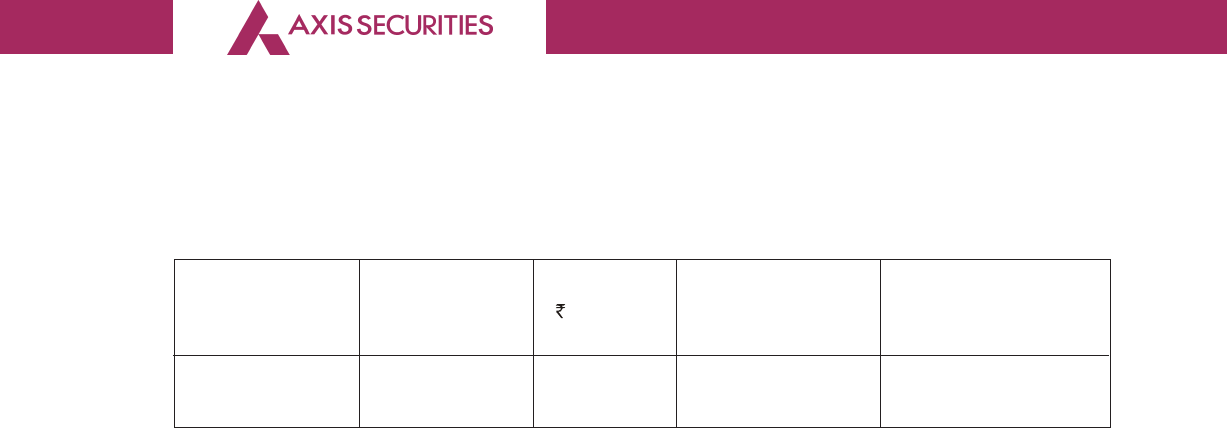
42
A Subsidiary of AXIS BANK
(vii) (c) According to the records of the Company, the dues of income-tax, goods and service
tax, and cess on account of any dispute, are as follows:
Name of the Nature of dues Amount ** Period to which Forum where dispute
statute ( ) the amount relates is pending
Income Tax Penalty 2,79,94,887 2013-14 Commissoner of
Income tax
As informed, provision of sales tax, customs duty, wealth tax and excise duty are currently not
applicable to the company.
(viii) In our opinion and according to the information and explanations given by the management,
the Company has not defaulted in repayment of loans or borrowing to a financial institution,
bank or government or dues to debenture holders.
(ix) According to the information and explanations given by the management, the Company
has not raised any money way of initial public offer / further public offer / debt instruments)
and term loans hence, reporting under clause (ix) is not applicable to the Company and
hence not commented upon.
(x) Based upon the audit procedures performed for the purpose of reporting the true and fair
view of the financial statements and according to the information and explanations given by
the management, we report that no fraud by the company or no fraud / material fraud on
the company by the officers and employees of the Company has been noticed or reported
during the year.
(xi) According to the information and explanation given by the management, the managerial
remuneration has been paid in accordance with the requisite approvals mandated by the
provisions of Section 197 read with Schedule V to the Companies Act, 2013.
(xii) In our opinion, the Company is not a Nidhi company. Therefore, the provisions of clause 3(xi)
of the order are not applicable to the Company and hence not commented upon.
(xiii) According to the information and explanations given by the management, transactions with
the related parties are in compliance with Section 177 and 188 of Companies Act, 2013 where
applicable and the details have been disclosed in the notes to the financial statements, as
required by the applicable accounting standards.
(xiv) According to the information and explanations given to us and on an overall examination of
the balance sheet, the Company has not made any preferential allotment or private
placement of shares or fully or partly convertible debentures during the year under review
and hence reporting requirements under clause 3(xiv) are not applicable to the Company
not commented upon.

43
A Subsidiary of AXIS BANK
(xv) According to the information and explanations given by the management, the Company
has not entered into any non-cash transactions with directors or persons connected with him
as referred to in Section 192 of Companies Act, 2013.
(xvi) According to the information and explanations given to us, the provisions of Section 45-IA of
the Reserve Bank of India Act, 1934 are not applicable to the Company.
For S. R. Batliboi & Co. LLP
Chartered Accountants
ICAI Firm Registration Number : 301003E / E300005
per Jitendra H. Ranawat
Partner
Membership Number : 103380
Place of Signature : Mumbai
Date : April 23, 2020

44
A Subsidiary of AXIS BANK
“ANNEXURE 2” TO THE INDEPENDENT AUDITOR’S REPORT OF EVEN DATE ON THE STANDALONE
FINANCIAL STATEMENTS OF AXIS SECURITIES LIMTED
Report on the Internal Financial Controls under Clause (i) of Sub-section 3 of Section 143 of the
Companies Act, 2013 (“the Act”)
To the Members of Axis Securities Limited
We have audited the internal financial controls over financial reporting of Axis Securities Limited
(“the Company”) as of March 31, 2020 in conjunction with our audit of the standalone financial
statements of the Company for the year ended on that date.
Management’s Responsibility for Internal Financial Controls
The Company’s Management is responsible for establishing and maintaining internal financial
controls based on the internal control over financial reporting criteria established by the Company
considering the essential components of internal control stated in the Guidance Note on Audit of
Internal Financial Controls Over Financial Reporting issued by the Institute of Chartered Accountants
of India. These responsibilities include the design, implementation and maintenance of adequate
internal financial controls that were operating effectively for ensuring the orderly and efficient
conduct of its business, including adherence to the Company’s policies, the safeguarding of its
assets, the prevention and detection of frauds and errors, the accuracy and completeness of the
accounting records, and the timely preparation of reliable financial information, as required under
theCompanies Act, 2013.
Auditor’s Responsibility
Our responsibility is to express an opinion on the Company’s internal financial controls over financial
reporting with reference to these financial statements based on our audit. We conducted our
audit in accordance with the Guidance Note on Audit of Internal Financial Controls Over Financial
Reporting (the “Guidance Note”) and the Standards on Auditing as specified under section 143(10)
of the Companies Act, 2013, to the extent applicable to an audit of internal financial controls and,
both issued by the Institute of Chartered Accountants of India. Those Standards and the Guidance
Note require that we comply with ethical requirements and plan and perform the audit to obtain
reasonable assurance about whether adequate internal financial controls over financial reporting
with reference to these financial statements was established and maintained and if such controls
operated effectively in all material respects.
Our audit involves performing procedures to obtain audit evidence about the adequacy of the
internal financial controls over financial reporting with reference to these financial statements and
their operating effectiveness. Our audit of internal financial controls over financial reporting included
obtaining an understanding of internal financial controls over financial reportingwith reference to
these financial statements, assessing the risk that a material weakness exists, and testing and
evaluating the design and operating effectiveness of internal control based on the assessed risk.
The procedures selected depend on the auditor’s judgement, including the assessment of the risks
of material misstatement of the financial statements, whether due to fraud or error.
We believe that the audit evidence we have obtained is sufficient and appropriate to provide a
basis for our audit opinion on the internal financial controls over financial reportingwith reference
to these financial statements.

45
A Subsidiary of AXIS BANK
Meaning of Internal Financial Controls Over Financial Reporting With Reference to these Financial
Statements
A company’s internal financial control over financial reportingwith reference to thesefinancial
statements is a process designed to provide reasonable assurance regarding the reliability of
financial reporting and the preparation of financial statements for external purposes in accordance
with generally accepted accounting principles. A company’s internal financial control over financial
reporting with reference to these financial statements includes those policies and procedures that
(1) pertain to the maintenance of records that, in reasonable detail, accurately and fairly reflect
the transactions and dispositions of the assets of the company; (2) provide reasonable assurance
that transactions are recorded as necessary to permit preparation of financial statements in
accordance with generally accepted accounting principles, and that receipts and expenditures
of the company are being made only in accordance with authorisations of management and
directors of the company; and (3) provide reasonable assurance regarding prevention or timely
detection of unauthorised acquisition, use, or disposition of the company’s assets that could have
a material effect on the financial statements.
Inherent Limitations of Internal Financial Controls Over Financial Reporting With Reference to these
Financial Statements
Because of the inherent limitations of internal financial controls over financial reporting with
reference to these financial statements, including the possibility of collusion or improper
management override of controls, material misstatements due to error or fraud may occur and
not be detected. Also, projections of any evaluation of the internal financial controls over financial
reporting with reference to these financial statements to future periods are subject to the risk that
the internal financial control over financial reporting with reference to these financial statements
may become inadequate because of changes in conditions, or that the degree of compliance
with the policies or procedures may deteriorate.
Opinion
In our opinion, the Company has, in all material respects, adequate internal financial controls over
financial reporting with reference to these financial statements and such internal financial controls
over financial reporting with reference to these financial statements were operating effectively as
at March 31, 2020, based on the internal control over financial reporting criteria established by the
Company considering the essential components of internal control stated in the Guidance Note
on Audit of Internal Financial Controls Over Financial Reporting issued by the Institute of Chartered
Accountants of India.
For S. R. Batliboi & Co. LLP
Chartered Accountants
ICAI Firm Registration Number : 301003E / E300005
per Jitendra H. Ranawat
Partner
Membership Number : 103380
Place of Signature : Mumbai
Date : April 23, 2020
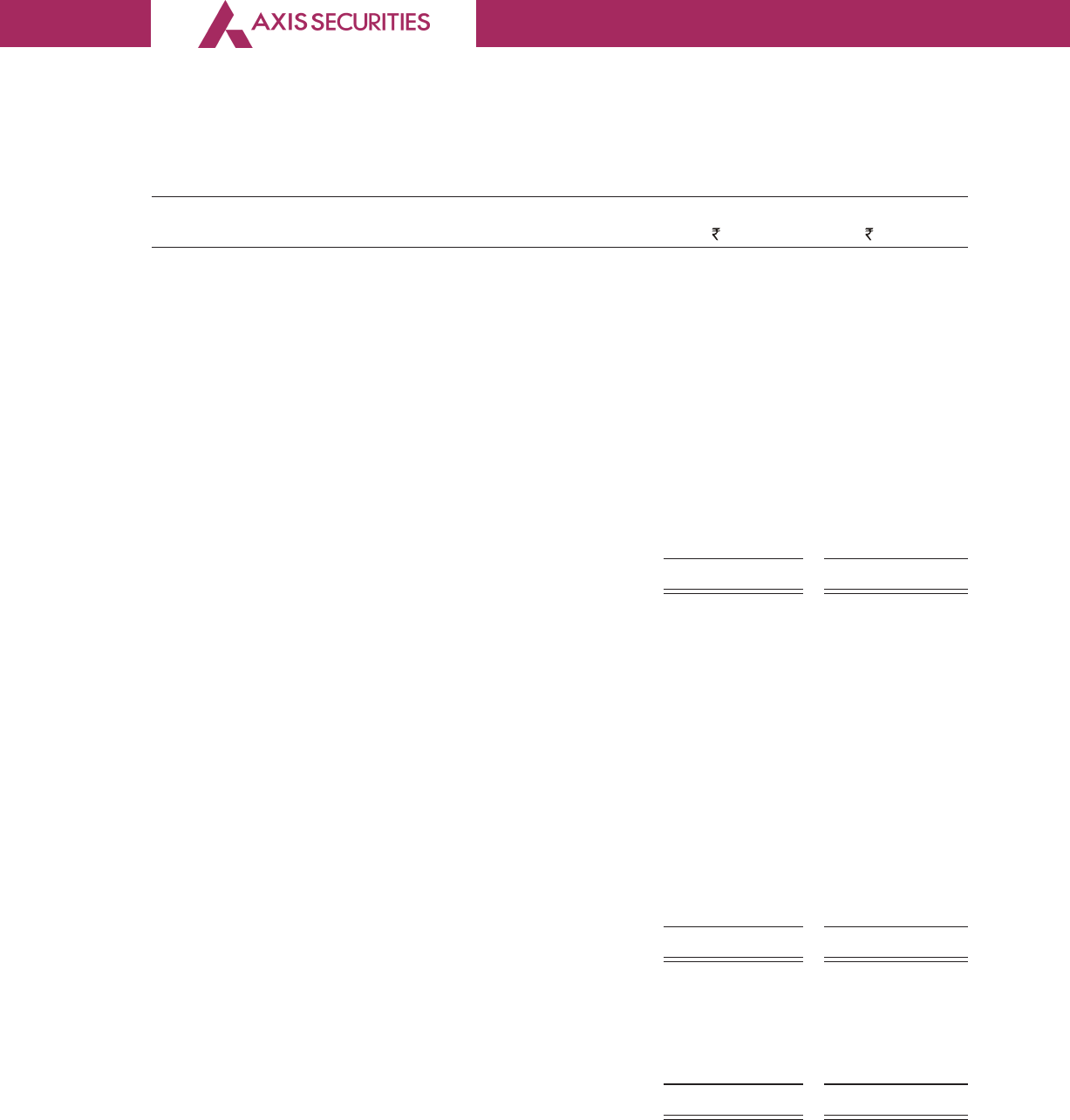
46
A Subsidiary of AXIS BANK
Balance sheet as at 31 March 2020
PARTICULARS Notes 31 March 2020 31 March 2019
( in Lakhs) ( in Lakhs)
ASSETS
Financial assets
Cash and cash equivalent 3 12,237 8,588
Bank balances other than (3 above) 4 24,400 13,187
Receivables
(i) Trade receivables 5 2,796 5,311
(ii) Other receivables – –
Loans 6 4,298 10,263
Other financial assets 7 6,281 1,748
Total Financial assets 50,012 39,097
Non - Financial assets
Current tax assets (net) 8 2,850 2,816
Deferred tax asset (net) 9 504 1,204
Property, plant and equipment 10 1,218 1,031
Right-of-use-asset 1,305 –
Capital work in progress 10 –35
Intangible assets under development 10 235 42
Intangible assets 10 1,497 1,386
Other non financial assets 11 883 518
Total Non- Financials assets 8,492 7,032
Assets included in disposal group in
accordance with Ind As 105 – 15,504
Total Assets 58,504 61,633
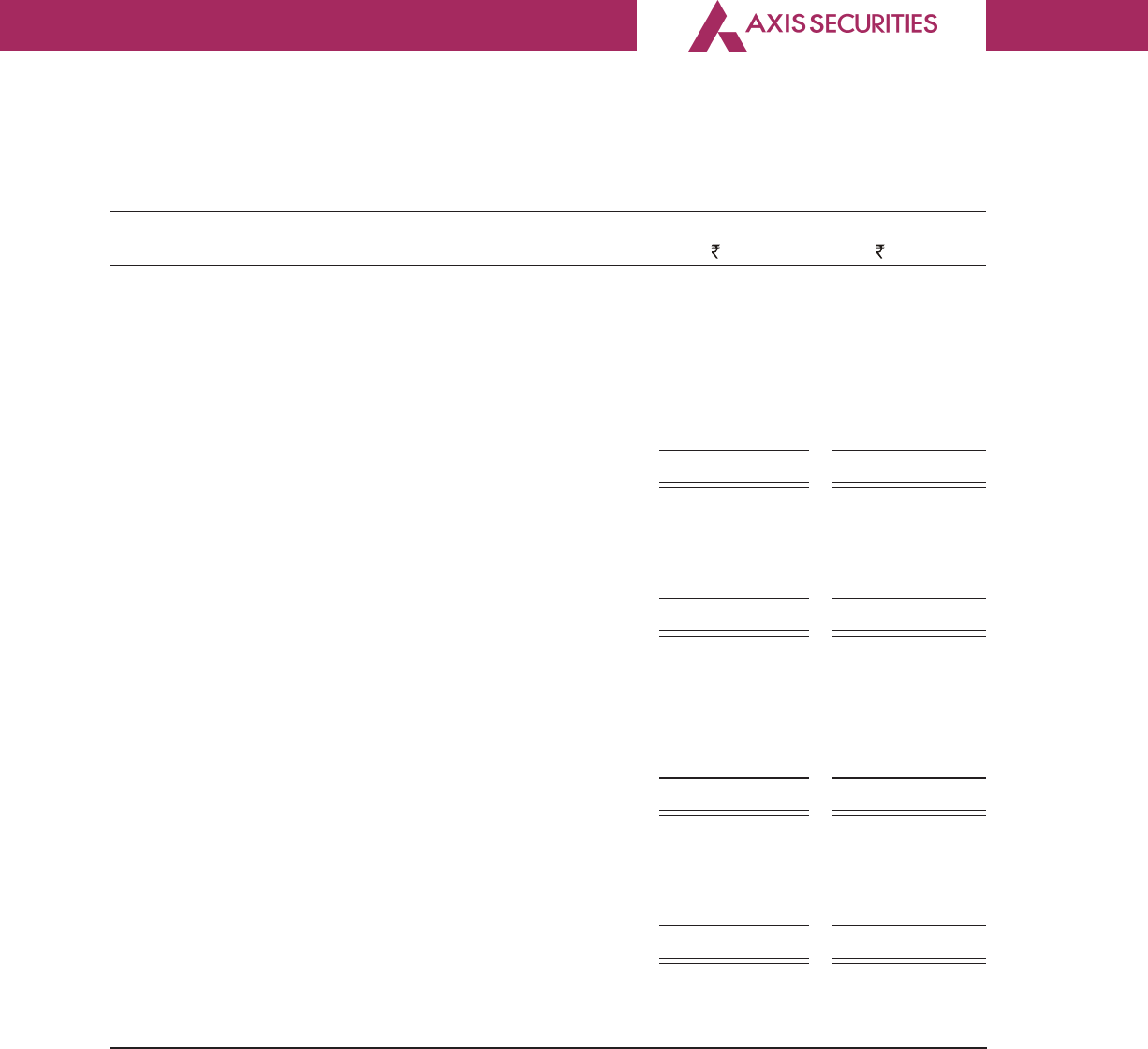
47
A Subsidiary of AXIS BANK
As per our report of even date
For S.R.Baltiboi & Co. LLP For and on behalf of the Board of Directors
Firm Registration No.: 301003E/E300005
Chartered Accountants
Pralay Mondal
Chairman
DIN No: 00117994
per Jitendra H. Ranawat Gopkumar Bhaskaran Anand Shaha
Partner Managing Director & CEO Whole-Time Director
Membership No. : 103380 DIN No: 07223999 DIN No: 02421213
Place : Mumbai Hemantkumar Patel Divya Poojari
Date : 23 April 2020 Chief Financial Officer Company Secretary
PAN: AGOPP9611N PAN: BIJPP6102N
Balance sheet cntd....
PARTICULARS Notes 31 March 2020 31 March 2019
( in Lakhs) ( in Lakhs)
LIABILITIES AND EQUITY
Financial liabilities
Payables
Trade payables 12 19,826 11,928
Lease Liabilities 1,651 124
Other financial liabilities 13 192 92
Total Financials liabilties 21,669 12,144
Non - Financial liabilities
Provisions 14 3,337 2,108
Other non-financial liabilties 15 1,916 3,575
Total Non-Financials liabilties 5,253 5,683
Equity
Equity share capital 16 14,450 14,450
Other Equity 17 17,132 18,547
Total Equity 31,582 32,997
Liabilities included in disposal group in – 10,809
accordance with Ind AS 105
Total Equity & Liabilities 58,504 61,633
Significant accounting Policies 2.1
The accompanying notes are an integral part of the financial statements
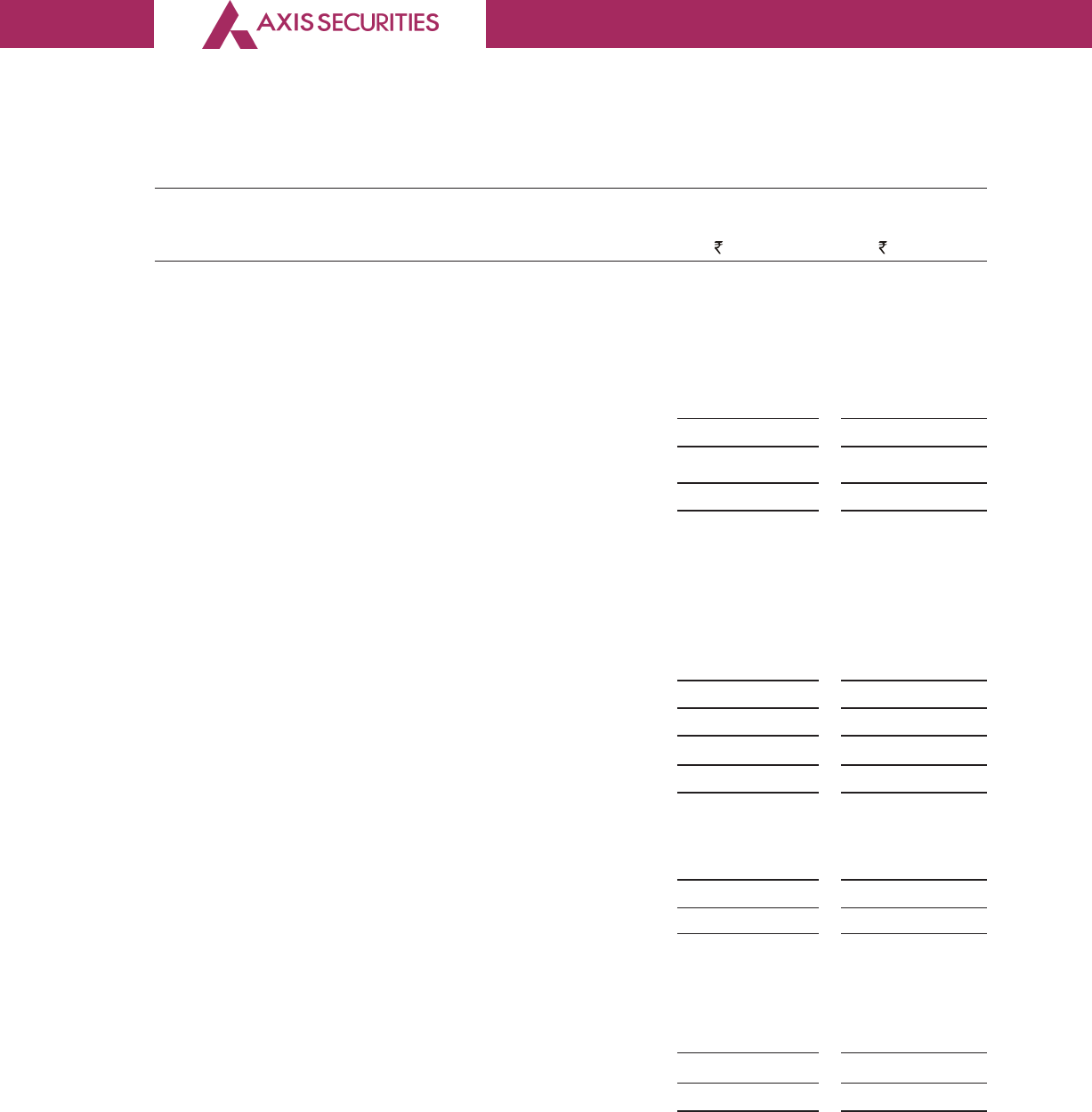
48
A Subsidiary of AXIS BANK
Statement of Profit and Loss for the year ended 31 March, 2020
PARTICULARS Notes Year ended Year ended
31 March, 2020 31 March, 2019
( in Lakhs) ( in Lakhs)
Continuing operation
Revenue from operations
Brokerage income 13,888 15,970
Interest on delayed payment 1,845 1,793
Other operating income 3,856 1,265
Total Revenue from operations 19,589 19,028
Other income 18 1,329 816
Total Income 20,918 19,844
Expenses:
Employee benefit expense 19 7,413 9,528
Depreciation amortization and 20 1,438 1,063
Impairment expense
Finance charges 21 363 227
Other expenses 22 4,215 4,475
Total expenses 13,429 15,293
Profit/(loss) before exceptional items and tax 7,489 4,551
Exceptional items 2,845 –
Profit before tax 4,644 4,551
Tax expense:
Current tax (1,424) (1,939)
Deferred tax (804) 315
Total tax (2,228) (1,624)
Profit for the year from continuing operation 2,416 2,927
Discontinued opearations
Profit before tax for the year from discontinued operations 665 6,693
Tax income/(expense) of discontinued operations (183) (2,408)
Deferred tax – 50
Profit for the year from discontinued operations 482 4,335
Profit for the year 2,898 7,262
Other comprehensive income (OCI)
(A) (i) Items that will be reclassified to profit or loss
(B) (i) Items that will not be reclassified to profit or loss
(a) Remeasurement of defined employee benefit plan (100) 269
(ii) Income tax relating to items that will not be
reclassified to profit or loss (64) (81)
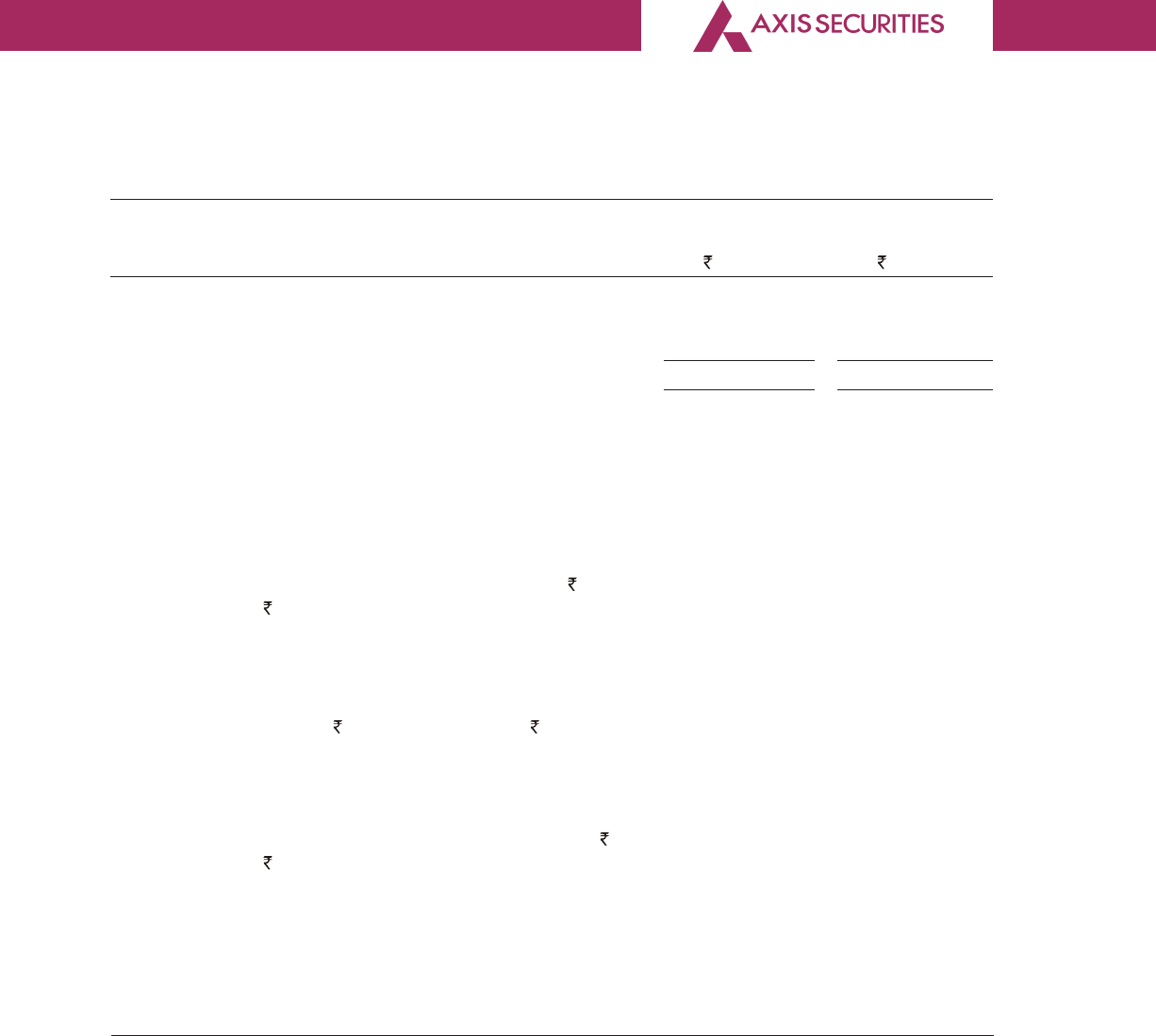
49
A Subsidiary of AXIS BANK
Statement of Profit and Loss cntd....
PARTICULARS Notes Year ended Year ended
31 March, 2020 31 March, 2019
( in Lakhs) ( in Lakhs)
Other comprehensive income for the year,
net of income tax (164) 189
Total comprehensive income for the year,
net of tax attributable to: 2,734 7,451
Profit for the year 2,898 7,262
Attributable to:
Equity holders of the parent 2,898 7,262
Total comprehensive income for the year 2,734 7,451
Attributable to:
Equity holders of the parent 2,734 7,451
Earnings per equity share (nominal value of share 10)
(31 March 2019: 10)]
Basic 1.56 2.16
Diluted 1.56 2.16
Earnings per equity share for discontinued operations
(nominal value of share 10) (31 March 2019: 10)]
Basic 0.33 3.00
Diluted 0.33 3.00
Earnings per equity share for continuing operations
and discontinued operations (nominal value of share 10)
(31 March 2019: 10)]
Basic 1.89 5.16
Diluted 1.89 5.16
Significant accounting policies 2.1
The accompanying notes are an integral part of the financial statements.
As per our report of even date
For S.R.Baltiboi & Co. LLP For and on behalf of the Board of Directors
Firm Registration No.: 301003E/E300005
Chartered Accountants
Pralay Mondal
Chairman
DIN No: 00117994
per Jitendra H. Ranawat Gopkumar Bhaskaran Anand Shaha
Partner Managing Director & CEO Whole-Time Director
Membership No. : 103380 DIN No: 07223999 DIN No: 02421213
Place : Mumbai Hemantkumar Patel Divya Poojari
Date : 23 April 2020 Chief Financial Officer Company Secretary
PAN: AGOPP9611N PAN: BIJPP6102N
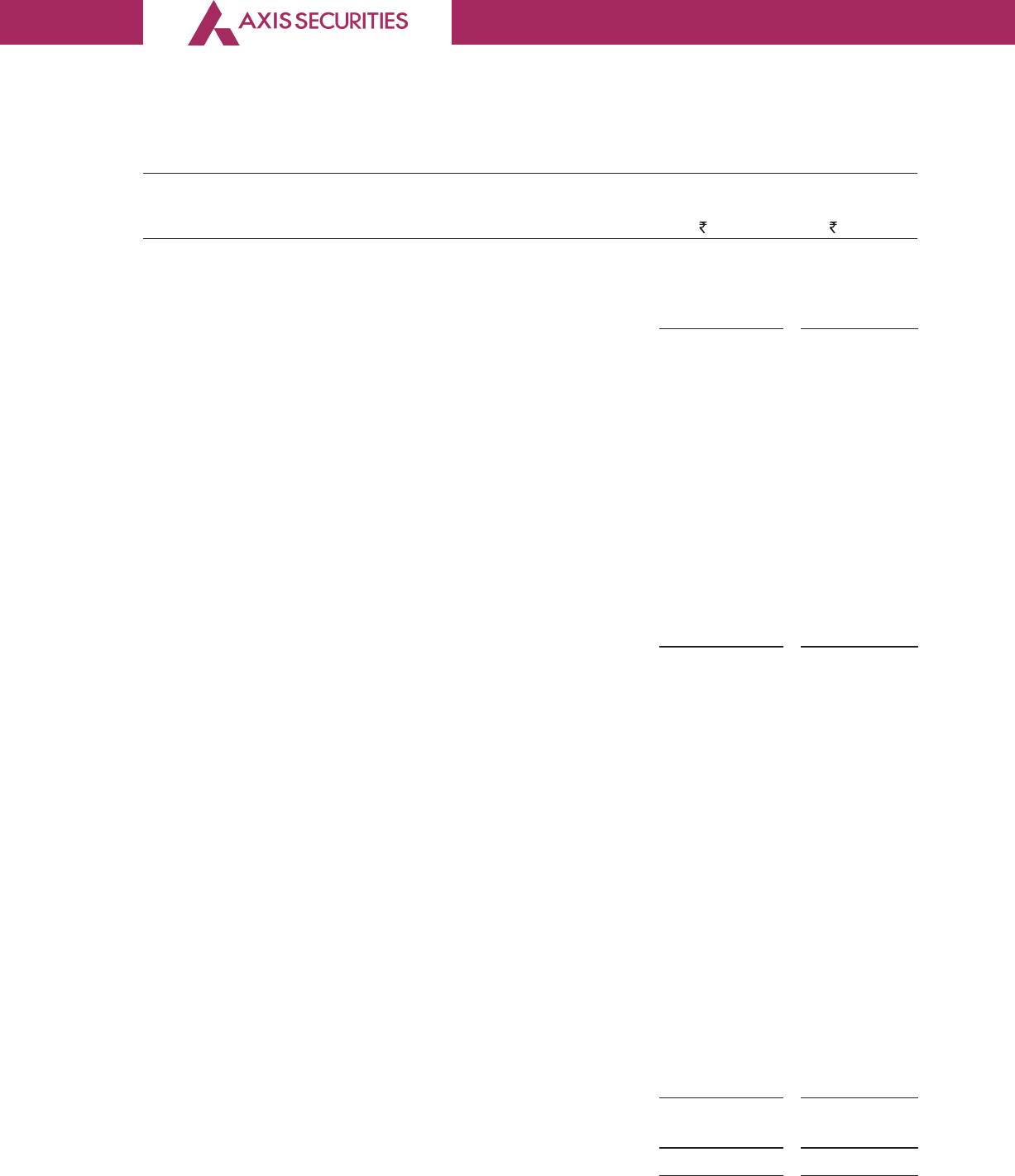
50
A Subsidiary of AXIS BANK
Cash flow statement for the year ended 31 March 2020
PARTICULARS
Year Ended Year Ended
31 March, 2020 31 March, 2019
( in Lakhs) ( in Lakhs)
Cash flow from operating activities
Profit before taxes from continuing operations 4,644 4,551
Profit/(loss) before tax from discontinued operations 665 6,693
Profit before tax 5,309 11,244
Adjustments to reconcile profit before tax to net
cash flows:
Depreciation and impairment of property,
plant and equipment 1,367 925
Amortisation and impairment of intangible assets 525 450
Gain on disposal of investment (129) (175)
Loss on disposal of property, plant and equipment 52 92
Interest income (1,189) (1,028)
Provision for doubtful debts 53 63
Prepaid rent –14
Provision for employee cost - ESOP 115 155
Finance costs 363 218
6,466 11,958
Working capital adjustments:
Decrease / (increase) in other financial asset (4,532) (9)
Decrease / (increase) in other assets 4,427 3,825
Decrease / (increase) in other non financial asset (32) 0
Decrease / (increase) in Loans 5,941 1,200
Decrease / (increase) in trade receivables 2,515 (8,366)
Decrease / (increase) in other financial liabilities 100 (15)
Increase / (decrease) in long term provisions 1,536 90
Increase / (decrease) in net employee defined
benefit liabillities (47) (80)
(Decrease) / increase in other non financial liabilities (7,793) (12)
Decrease / (increase) in employee benefit – 39
(Decrease) / increase in Liabilities for Statutory dues – 369
Increase / (decrease) in trade payables 7,898 1,708
Increase / (decrease) in provisions 806 592
Increase / (decrease) in net employee defined
benefit liabillities (171) (128)
Cash generated from operations 17,114 11,171
Income tax paid (1,641) (3,289)
Net cash flows from operating activities 15,473 7,882
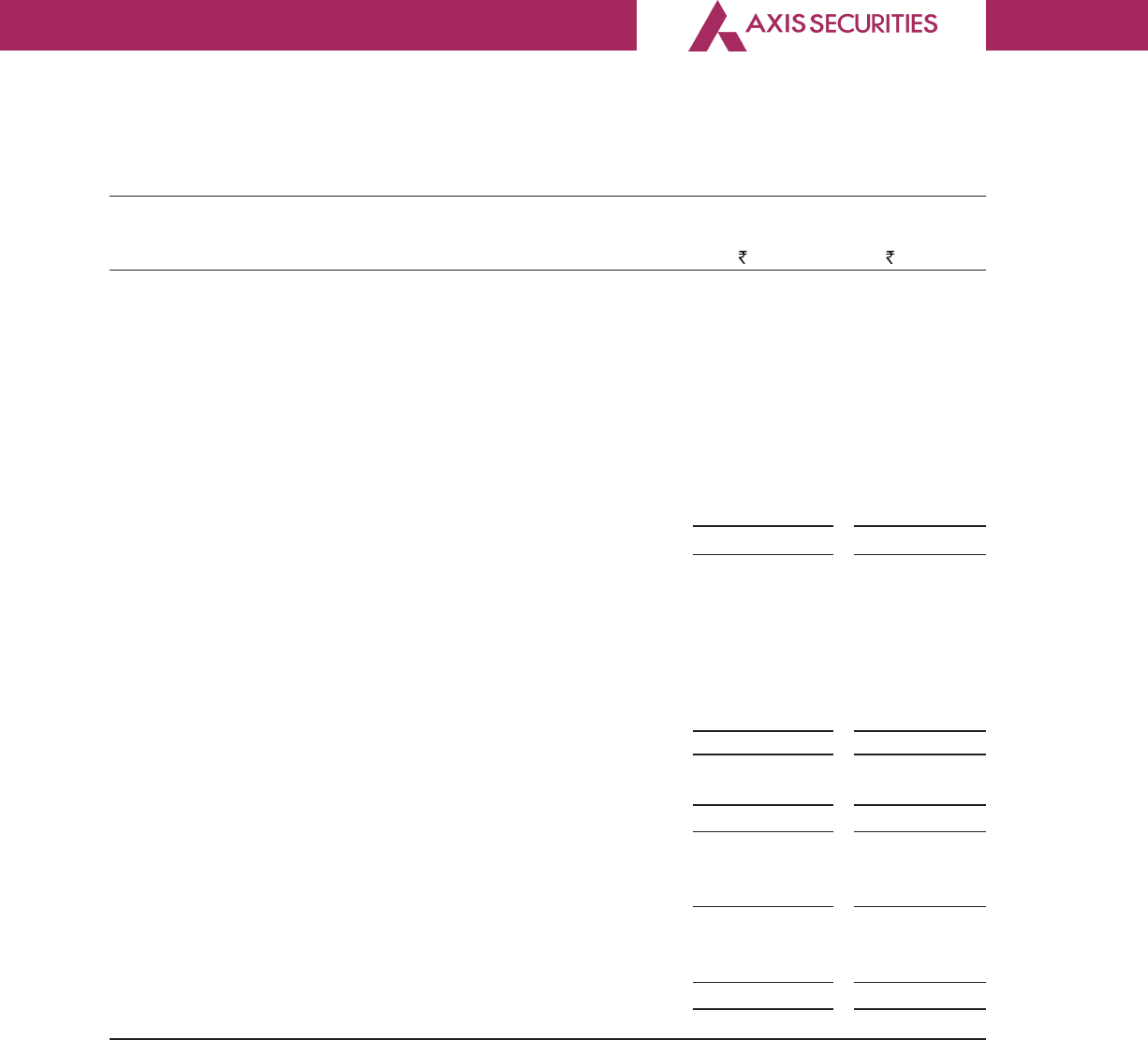
51
A Subsidiary of AXIS BANK
As per our report of even date
For S.R.Baltiboi & Co. LLP For and on behalf of the Board of Directors
Firm Registration No.: 301003E/E300005
Chartered Accountants
Pralay Mondal
Chairman
DIN No: 00117994
per Jitendra H. Ranawat Gopkumar Bhaskaran Anand Shaha
Partner Managing Director & CEO Whole-Time Director
Membership No. : 103380 DIN No: 07223999 DIN No: 02421213
Place : Mumbai Hemantkumar Patel Divya Poojari
Date : 23 April 2020 Chief Financial Officer Company Secretary
PAN: AGOPP9611N PAN: BIJPP6102N
Cash flow statement cntd....
PARTICULARS
Year Ended Year Ended
31 March, 2020 31 March, 2019
( in Lakhs) ( in Lakhs)
Investing activities
Purchase of property, plant and equipment (835) (533)
Purchase of other Intangible assets (581) (578)
Right of use asset (1,305) –
Proceeds from sale of property, plant and equipment & other
Intangible assets 1,027 40
Investment in bank fixed deposit under lien with exchange (15,132) (4,594)
Investment in mutual funds (79,530) (1,34,679)
Redemption of mutual funds 79,716 1,36,154
Interest received (finance income) 1,276 997
Net cash flows used in investing activities (15,364) (3,193)
Financing activities
Finance charges (231) (186)
Interest paid on lease liabilities (132) –
Reepayment of lease liabilities 2,961 –
Proceeds from issuance of commercial paper – 2,500
Redemption of commercial paper – (5,000)
Dividend paid (including distribution tax) (4,007) –
Net cash flows from/(used in) financing activities (1,409) (2,686)
Net increase in cash and cash equivalents (1,300) 2,003
Cash and cash equivalents at the beginning of the year 13,537 11,534
Cash and cash equivalents at year end 12,237 13,537
Components of cash and cash equivalents as at 31st March 2020
Cash in hand – –
With scheduled bank -
On current account 12,235 6,376
On fixed deposit account – 7,160
Balance in prepaid cards 2 1
Total 12,237 13,537
The accompanying notes are an integral part of the financial statements. 2.1
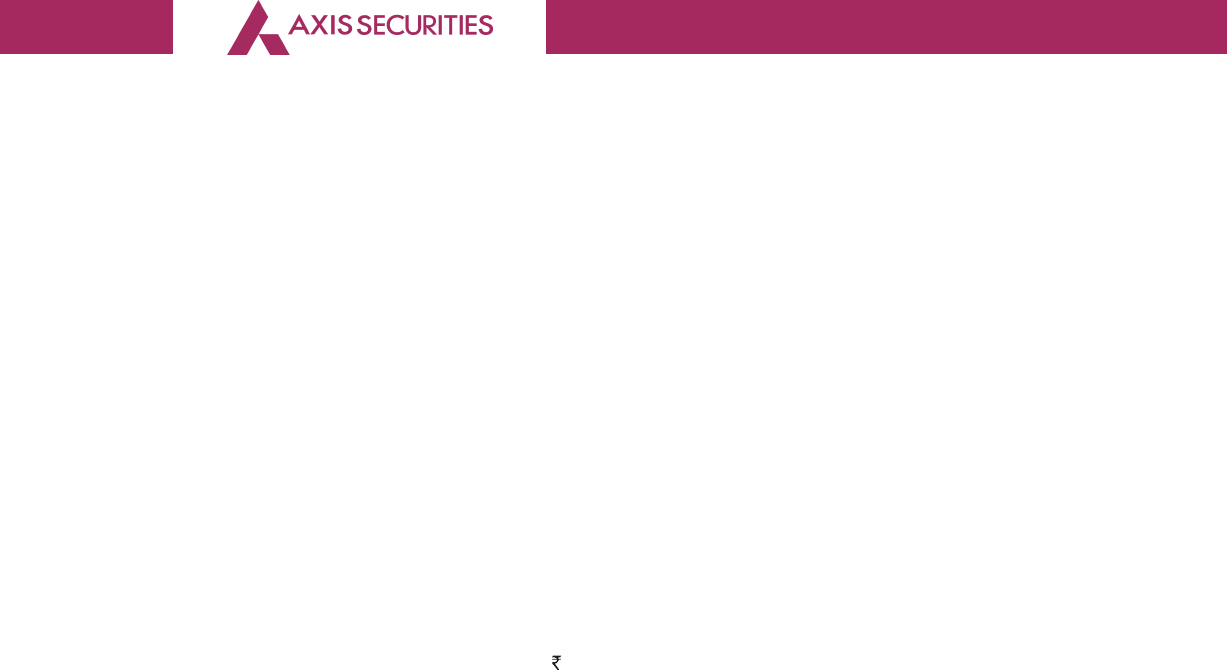
52
A Subsidiary of AXIS BANK
Notes forming part of the financial statements
1.1 Coporate Information
Axis Securities Limited (‘the Company’) is public company domiciled in India and is
incorporated under the provision of Companies Act applicable in India. The Company is
engaged in the business of broking, distribution of financial products and advisory services.
The company is an unlisted public limited Company and is a wholly owned subsidiary of Axis
Bank Limited (the “Parent”).
2. Basis of preparation
The Balance Sheet, the Statement of Changes in Equity and the Statement of Profit and Loss
are presented in the format prescribed under Division III of Schedule III of Companies Act,
2013 as amended from time to time that are required to comply with IND AS as notified under
Section 133 of Companies Act, 2013 and other relevant provisions of the Act. The Statement
of Cash Flows has been presented as per the requirements of IND AS 7 Statement of Cash
Flows.The financial statements have been prepared under the historical cost convention and
on accrual basis, except for certain financial assets and liablities, defined benefit-plan liablities
and share based payments being measured at fair value.These financial statements are
presented in Indian Rupees (INR)/ , which is also its functional currency and all values are
rounded to nearest Lakhs except when otherwise indicated.
2.1 Significant accounting policies
i. Use of estimates
The preparation of the financial statements in conformity with the Ind AS requires the
management to make estimates and assumptions that affect the reported amounts of
assets and liabilities, revenues and expenses and disclosure of contingent liabilities at
the end of the reporting period. Actual results could differ from those estimates. The
management believes that the estimates used in the preparation of the financial
statements are prudent and reasonable. Any revisions to the accounting estimates are
recognised prospectively in the current and future periods.
ii. Financial instruments
A financial instrument is any contract that gives rise to a financial asset of one entity and
financial liability or equity instrument of another entity. Financial assets and financial
liabilities are recognized when Company becomes party to the contractual provisions
of the instruments.
a) Date of recognition
Financial assets and liabilities, with the exception of loans, debt securities and
borrowings are initially recognised on the trade date, i.e., the date that the
Company becomes a party to the contractual provisions of the instrument. This
includes regular way trades, purchases or sales of financial assets that require
delivery of assets within the time frame generally established by regulation or
convention in the market place (regular way trades) are recognized on the trade
date, i.e., the date that the Company commits to purchase or sell the asset. Loans
are recognised when funds are transferred to the customers’ account. The
company recognises debt securities, deposits and borrowings when funds reach
the company.

53
A Subsidiary of AXIS BANK
b) Initial recognition, classification and subsequent measurement of financial assets
Financial assets are classified into one of the three categories for measurement
and income recognition:
• Amortized Cost (AC)
• Fair value through other comprehensive income (FVTOCI)
• Fair value through profit and loss (FVTPL)
Classification of financial assets is based on the assessment of business model and
contractual cash flow test.
Financial asset is measured at amortized cost, if both the following conditions are met:
a) The financial asset is held within a business model whose objective is to hold the financial
assets in order to collect the contractual cash flows; and
b) The contractual terms of the financial asset give rise on specific dates to cash flows that
are solely payments of principal and interest on the principal amount outstanding (SPPI).
Further other things remain the same (as in (a) and (b) above), if the financial asset is
held within a business model whose objective is achieved by both collecting contractual
cash flows and selling the financial assets, such asset/s are classified as held at FVTOCI.
In case of a financial asset that does not meet both the above conditions, it is classified
as FVTPL
iii. Classification of financial liabilities
The Company classified all financial liabilities as subsequently measured at amortized cost.
Initial and Subsequent measurement of Financial Liability
The Company measures the financial liability at its fair value plus or minus, in the case of a
financial asset or financial liability not at fair value through profit or loss, transaction costs that
are directly attributable to the acquisition or issue of the financial asset or financial liability, at
initial recognition.
Initial recognition and subsequent measurement of financial liability is based on their
classification.
De-recognition
De-recognition of financial assets
A financial asset is derecognized only when:
• The Company has transferred the rights to receive cash flows from the financial asset or
• Retains the contractual rights to receive the cash flows of the financial asset, but assumes
a contractual obligation to pay the cash flows to one or more recipients.
• Where the entity has transferred an asset, the entity evaluates whether it has transferred
substantially all risks and rewards of ownership of the financial asset. In such cases, the
financial asset is derecognized. Where the entity has not transferred substantially all risks
and rewards of ownership of the financial asset, the financial asset is not derecognized.
Notes forming part of the financial statements

54
A Subsidiary of AXIS BANK
• Where the entity has neither transferred a financial asset nor retains substantially all risks
and rewards of ownership of the financial asset, the financial asset is derecognized if
the entity has not retained control of the financial asset. Where the entity retains the
control of the financial asset, the asset is continued to be recognized to the extent of
continuing involvement in the financial asset.
De-recognition of financial liabilities
A financial liability is derecognized when the obligation under the liability is discharged or
cancelled or expires. When an existing financial liability is replaced by another from the same
lender on substantially different terms, or the terms of an existing liability are substantially
modified, such an exchange or modification is treated as the de-recognition of the original
liability and the recognition of a new liability. The difference in the respective carrying amounts
is recognized in the statement of profit or loss.
iv. Reclassification of financial assets and financial liabilities
An entity is required to reclassify financial assets when and only when it changes its business
model for managing financial assets.
Reclassifications are expected to be very infrequent. Such changes must be determined by
the entity’s senior management as a result of external or internal changes and must be
significant to the entity’s operations and demonstrable to external parties.
Further re- classification is not allowed in following cases;
• Investments in equity instruments irrevocably designated as at FVTOCI cannot be
reclassified.
• Reclassification of financial liabilities
v. Impairment of financial assets
A) Trade receivables
The Company applies the Ind AS 109 simplified approach to measuring expected credit
losses which uses a lifetime expected loss allowance (ECL) for all trade receivables. The
application of simplified approach does not require the Company to track changes in
credit risk. Rather, it recognises impairment loss allowance based on lifetime ECLs at
each reporting date, right from its initial recognition. To measure the expected credit
losses, trade receivables have been grouped based on shared credit risk characteristics
and the days past due. The expected loss rates are based on average of historical loss
rate adjusted to reflect current and available forward-looking information affecting the
ability of the customers to settle the receivables. The Company has also computed
expected credit loss due to significant delay in collection.
B) Other Financial Assets
For recognition of impairment loss on financial assets and risk exposure, the Company
determines that whether there has been a significant increase in the credit risk since
initial recognition. If credit risk has not increased significantly, 12-month ECL is used to
provide for impairment loss. However, if credit risk has increased significantly, lifetime
ECL is used. If in subsequent years, credit quality of the instrument improves such that
Notes forming part of the financial statements

55
A Subsidiary of AXIS BANK
there is no longer a significant increase in credit risk since initial recognition, then the
entity reverts to recognizing impairment loss allowance based on 12 month ECL. Life
time ECLs are the expected credit losses resulting from all possible default events over
the expected life of a financial instrument. The 12 month ECL is a portion of the lifetime
ECL which results from default events that are possible within 12 months after the year
end. ECL is the difference between all contractual cash flows that are due to the
Company in accordance with the contract and all the cash flows that the entity expects
to receive (i.e. all shortfalls), discounted at the original EIR. When estimating the cash
flows, an entity is required to consider all contractual terms of the financial instrument
(including prepayment, extension etc.) over the expected life of the financial instrument.
However, in rare cases when the expected life of the financial instrument cannot be
estimated reliably, then the entity is required to use the remaining contractual term of
the financial instrument. ECL impairment loss allowance (or reversal) recognized during
the year is recognized as income/expense in the statement of profit and loss. In balance
sheet ECL for financial assets measured at amortized cost is presented as an allowance,
i.e. as an integral part of the measurement of those assets in the balance sheet. The
allowance reduces the net carrying amount. Until the asset meets write off criteria, the
Company does not reduce impairment allowance from the gross carrying amount.
vi. Fair Value Measurement
The Company measures financial instruments such as investment in mutual funds at fair value
at each balance sheet date. Fair value is the price that would be received to sell an asset or
paid to transfer a liability in an orderly transaction between market participants at the
measurement date. Fair value measurement is based on the presumption that the transaction
to sell the asset or transfer the liability takes place either:
- In the principal market for the asset or liability, or
- In the absence of a principal market, In the most advantageous market for the asset or
liability
The Principal or the most advantageous market must be accessible by the Company.
The fair value of an asset or a liability is measured using the assumptions that market participants
would use when pricing the asset or liability, assuming that market participants act in their
economic best interest.
A fair value measurement of a non-financial asset takes into account a market participant’s
ability to generate economic benefits by using the asset in its highest and best use or by
selling it to another marker participant that would use the asset in its highest and best use.
The company uses Net Asset Value (NAV) to fair value investments in mutual funds.
Fair value hierarchy
Ind AS 107, ‘Financial Instrument - Disclosure’ requires classification of the valuation method
of financial instruments measured at fair value in the Balance Sheet, using a three level fair-
value-hierarchy (which reflects the significance of inputs used in the measurements). The
hierarchy gives the highest priority to un-adjusted quoted prices in active markets for identical
assets or liabilities (Level 1 measurements) and lowest priority to un-observable inputs (Level 3
Notes forming part of the financial statements

56
A Subsidiary of AXIS BANK
measurements). The three levels of the fair-value-hierarchy under Ind AS 107 are described
below:
Level 1: Level 1 hierarchy includes financial instruments measured using quoted prices.
Level 2: The fair value of financial instruments that are not traded in an active market is
determined using valuation techniques which maximize the use of observable market data
and rely as little as possible on entity specific estimates. If all significant inputs required to fair
value an instrument are observable, the instrument is included in level 2.
Level 3: If one or more of the significant inputs is not based on observable market data, the
instrument is included in level. This is the case for unlisted equity securities included in level 3.
vii. Financial assets and financial liabilities at fair value through profit or loss
Financial assets and financial liabilities in this category are those that are not held for trading
and have been either designated by management upon initial recognition or are mandatorily
required to be measured at fair value under Ind AS 109. Management only designates an
instrument at FVTPL upon initial recognition when one of the following criteria are met. Such
designation is determined on an instrument-by-instrument basis:
The designation eliminates, or significantly reduces, the inconsistent treatment that would
otherwise arise from measuring the assets or liabilities or recognising gains or losses on them on
a different basis
Or
The liabilities are part of a group of financial liabilities, which are managed and their
performance evaluated on a fair value basis, in accordance with a documented risk
management or investment strategy
Or
The liabilities containing one or more embedded derivatives, unless they do not significantly
modify the cash flows that would otherwise be required by the contract, or it is clear with little
or no analysis when a similar instrument is first considered that separation of the embedded
derivative(s) is prohibited.
Financial assets and financial liabilities at FVTPL are recorded in the balance sheet at fair
value. Changes in fair value are recorded in profit and loss with the exception of movements
in fair value of liabilities designated at FVTPL due to changes in the Group’s own credit risk.
Such changes in fair value are recorded in the Own credit reserve through OCI and do not
get recycled to the profit or loss. Interest earned or incurred on instruments designated at
FVTPL is accrued in interest income or finance cost, respectively, using the EIR, taking into
account any discount/ premium and qualifying transaction costs being an integral part of
instrument. Interest earned on assets mandatorily required to be measured at FVTPL is recorded
using contractual interest rate.
viii. Revenue recognition
Revenue (other than for those items to which IND AS 109 Financial Instruments are applicable)
is measured at fair value of consideration received or receivable. IND AS 115 Revenue from
contracts with customers outlines a single comprehensive model of accounting for revenue
arising from contracts with customers and supersedes current revenue recognition guidance
found within IND ASs.
Notes forming part of the financial statements

57
A Subsidiary of AXIS BANK
The Company recognises revenue from contracts with customers based on five step model
as set out in IND AS 115 :
Step 1: Identify Contract(s) with a customer :
A contract is defined as an agreement between two or more parties that creates enforceable
rights and obligations and sets out the criteria for every contract that must be met.
Step 2: Identify performance obligations in the contract :
A performance obligation is a promise in a contract with a customer to transfer a good or
service to the customer.
Step 3 : Determine the transaction price :
The transaction price is the amount of consideration to which the Company expects to be
entitled in exchange for transferring promised goods or services to a customer, excluding
amounts collected on behalf of third parties.
Step 4 : Allocate the transaction price to the performance obligations in the contract :
For a contract that has more than one performance obligation, the Company allocates the
transaction price to each performance obligation in an amount that depicts the amount of
consideration to which the company expects to be entitled in exchange for satisfying each
performance obligation.
Step 5 : Recognise revenue when (or as ) the company satisfies performance obligation.
a. Business sourcing and resource management
The Company recognises the fee income on periodic bases based on the quantum of services
provided at agreed rates.
b. Brokerage fee income
Revenue recognition for brokerage fees can be divided into the following two categories:
1) Brokerage fees – point in time
Brokerage income on securities is recognized as per contracted rates at the execution of
transactions on behalf of the customers on the trade date.
2) Brokerage fees – over time
Fees earned for the provision of services are recognised over time as the customer
simultaneously receives and consumes the benefits, as the services are rendered. These include
brokerage fees which is fixed at inception irrespective of number of transaction executed.
The revenue for such contracts is recognised on consumption of benefits and the balance
unutilized plan value is recognised on maturity/ validity of plan.
c. Selling commissions/ brokerage generated from primary market operations i.e. procuring
subscriptions from investors for public offerings of companies, mutual funds etc are recorded
on determination of the amount due to the company, once the allotment of securities are
completed.
Notes to financial statements for the year ended 31 March, 2020
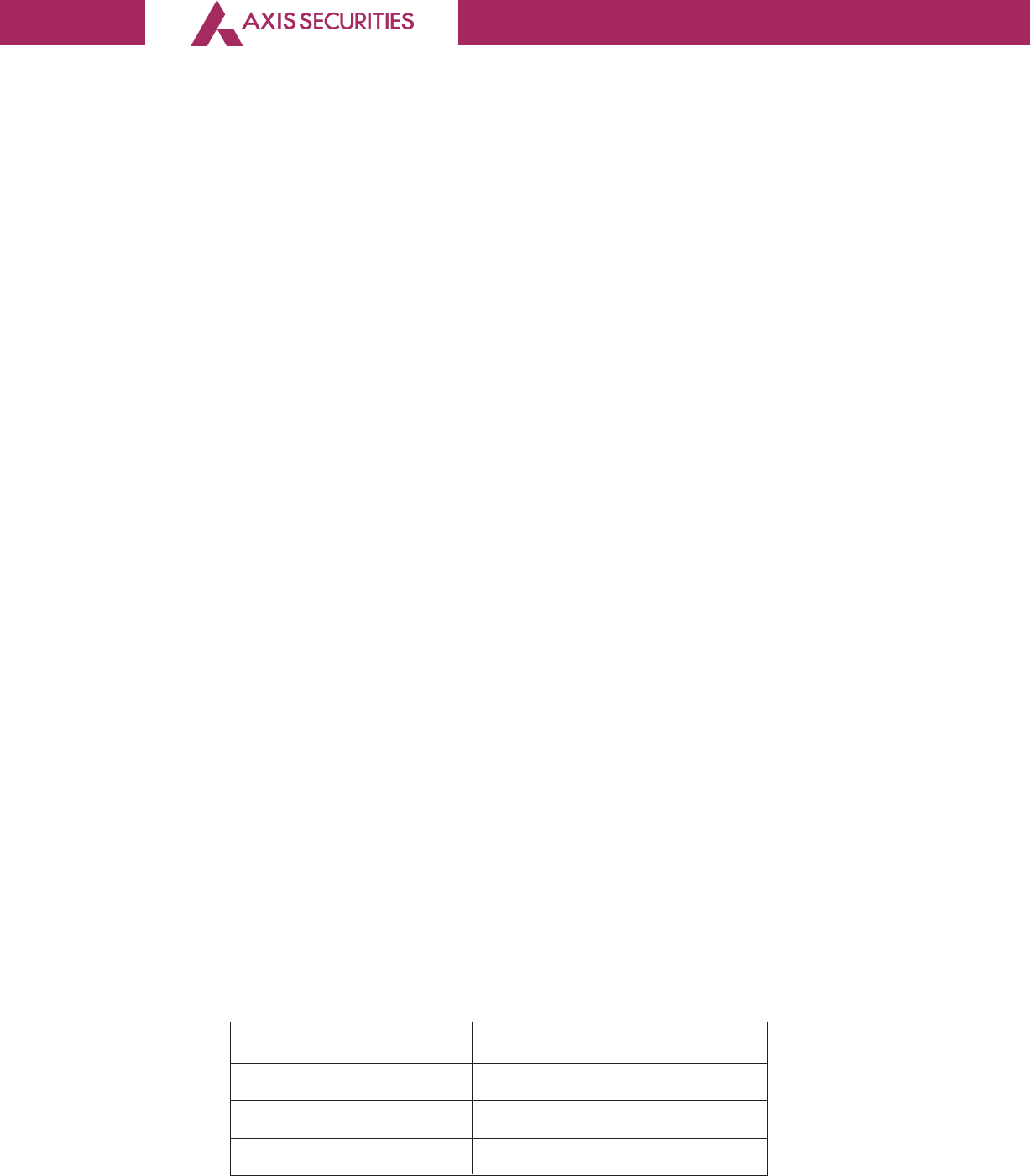
58
A Subsidiary of AXIS BANK
d. Depository fees
Depository fees are recognized on completion of the transaction.
e. Portfolio management fees
Portfolio management fees are recognised when corpus is offered for investment by the
customer. Subsequently fees are charged at contracted rates periodically.
Further, fees are charged on withdrawal of invested funds before a specified period.
f. Interest
The Company calculates interest income by applying the (Effective Interest Rate) EIR to the
gross carrying amount of loans other than credit-impaired loans.
g. Income from investments
Income from sale of investments is determined on weighted average basis and recognised
on the trade date basis.
h. Financial risk management objectives and policies
(A) Market Risk
Market risk is the risk that the fair value of future cash flows of a financial instrument will
fluctuate because of changes in market prices. Market risk comprises following types of
risk: interest rate risk and currency risk. Financial instruments affected by market risk include
borrowings.
(i) Interest Rate Risk
Interest rate risk is the risk that the fair value or future cash flows of a financial instrument
will fluctuate because of changes in market interest rates. The Company is exposed to
interest rate risk arising mainly from borrowings with floating interest rates. The Company
is exposed to interest rate risk because the cash flows associated with floating rate
borrowings will fluctuate with changes in interest rates. The Company manages the
interest rate risks by maintaining a debt portfolio comprising a mix of fixed and floating
rate borrowings.
At the reporting date, the interest profile of the Company’s borrowings is as follows:
Exposure to interest rate risk
March 31, 2020 March 31, 2019
Fixed rate borrowings – –
Variable rate borrowings 9.80% 9.70%
Total borrowings 9.80% 9.70%
Notes to financial statements for the year ended 31 March, 2020
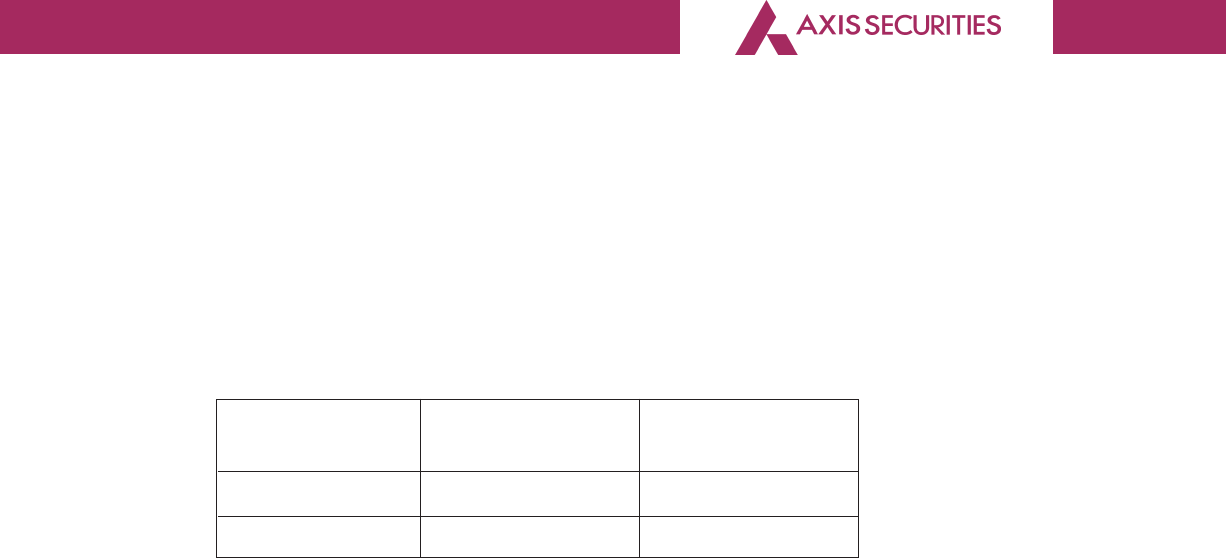
59
A Subsidiary of AXIS BANK
Interest rate sensitivity
The following table demonstrates the sensitivity to a reasonably possible change in interest
rates on that portion of loans and borrowings. With all other variables held constant, the
Group’s profit before tax is affected through the impact on floating rate borrowings, as
follows:
Increase/ decrease Effect on profit
in basis points before tax
31-Mar-19 0.45 0.16
31-Mar-20 0.10 0.03
(ii) Foreign currency risk
Foreign currency risk is the risk that the fair value or future cash flows of a financial
instrument will fluctuate because of changes in foreign exchange rates. As at each
reporting date, the Company does not have exposure in foreign currency, therefore it is
not exposed to currency risk.
(B) Credit Risk
Credit risk is the risk that the Company will incur a loss because its customers or counterparties
fail to discharge their contractual obligations. The company manages and controls credit risk
by setting limits on the amount of risk it is willing to accept for individual counter parties, and
by monitoring exposures in relations to such limits.The maximum exposure to credit risk for
each class of financial instruments is the carrying amount of that class of financial instruments
presented in the financial statements. The Company’s major classes of financial assets are
cash and cash equivalents, loans, term deposits, trade receivables and security deposits.Cash
and cash equivalents and term deposits with banks are considered to have negligible risk or
nil risk, as they are maintained with high rated banks/financial institutions as approved by the
Board of directors. Security deposits are kept with stock exchanges for meeting minimum
base capital requirements. These deposits do not have credit risk. The management has
established accounts receivable policy under which customer accounts are regularly
monitored. The company has a dedicated risk management team, which monitors the
positions, exposures and margins on a continous basis.
(C) Liquidity Risk
Liquidity risk is the risk that the Company will not be able to meet its financial obligations as
they become due. The Company manages its liquidity risk by ensuring, as far as possible, that
it will always have sufficient liquidity to meet its liabilities when due.
Notes to financial statements for the year ended 31 March, 2020
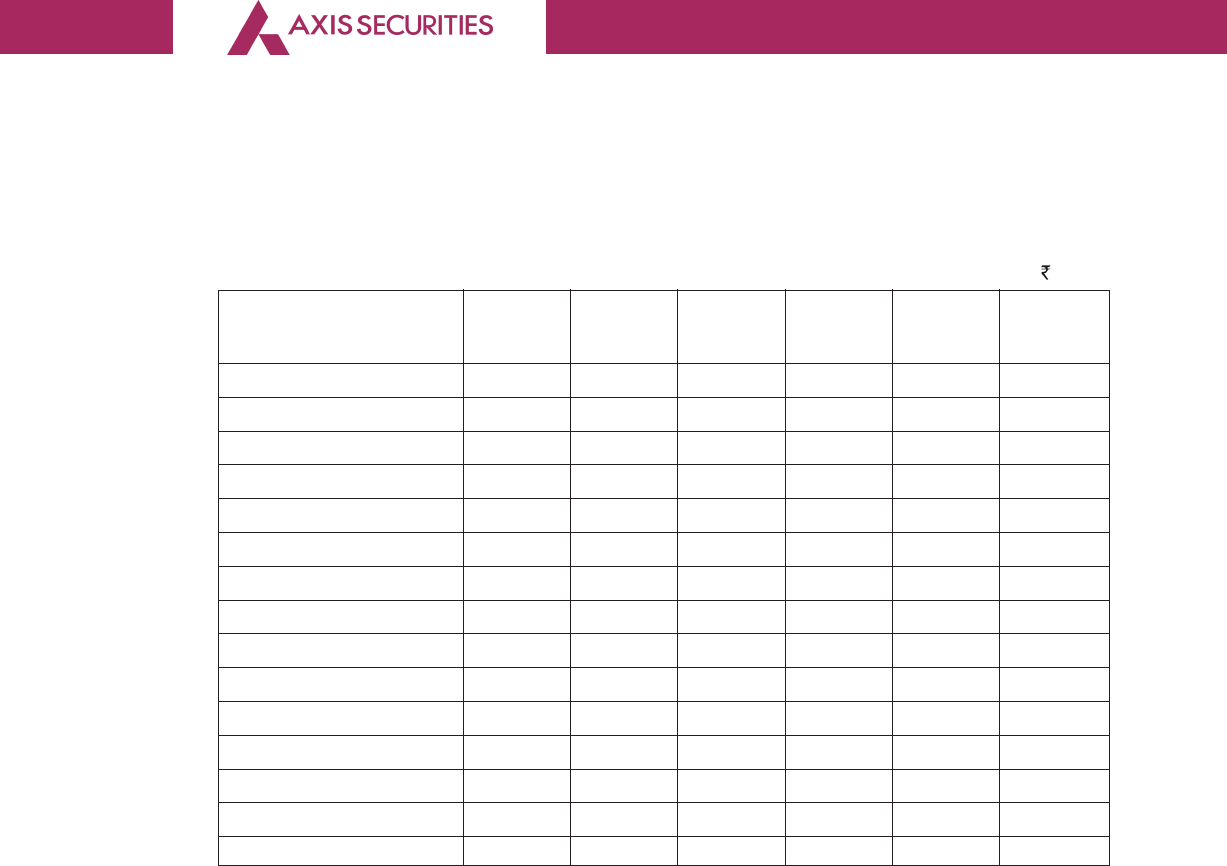
60
A Subsidiary of AXIS BANK
The table below summarizes the maturity profile of the Company’s financial liabilities:
(Amount in Lacs)
0–1 year 1–2 year 2–3 year 3–4 year Beyond Total
4 years
01-Apr-18
Borrowings 2,468 – – – – 2,468
Trade payables 10,220 – – – – 10,220
Other financial liabilities – – – – – –
12,688 – – – – 12,688
31-Mar-19
Borrowings – – – – – –
Trade payables 11,928 – – – – 11,928
Other financial liabilities 773 – – – – 773
12,701 – – – – 12,701
31-Mar-20
Borrowings – – – – – –
Trade payables 19,826 – – – – 19,826
Other financial liabilities 1,864 – – – – 1,864
21,690 – – – – 21,690
ix. Plant, Property and Equipment including intangible assets
Plant, Property and Equipment and intangible assets are stated at cost, net off accumulated
depreciation and impairment losses, if any. Cost comprises the purchase price and any
attributable cost of bringing the asset to its working condition for its intended use.
Subsequent expenditure related to an item of fixed asset is added to its book value only if it
increases the future benefits from the existing asset beyond its previously assessed standard of
performance. All other expenses on existing fixed assets, including day-to-day repair and
maintenance expenditure and cost of replacing parts, are charged to the Statement of profit
and loss for the period during which such expenses are incurred.
Gains or losses arising from derecognition of fixed assets are measured as the difference
between the net disposal proceeds and the carrying amount of the asset and are recognized
in the Statement of profit and loss when the asset is derecognized.
The Company’s other intangible assets mainly include the value of computer software.
An intangible asset is recognised only when its cost can be measured reliably and it is probable
that the expected future economic benefits that are attributable to it will flow to the Company.
Intangible assets acquired separately are measured on initial recognition at cost.
The residual values is considered as nil.
Notes to financial statements for the year ended 31 March, 2020
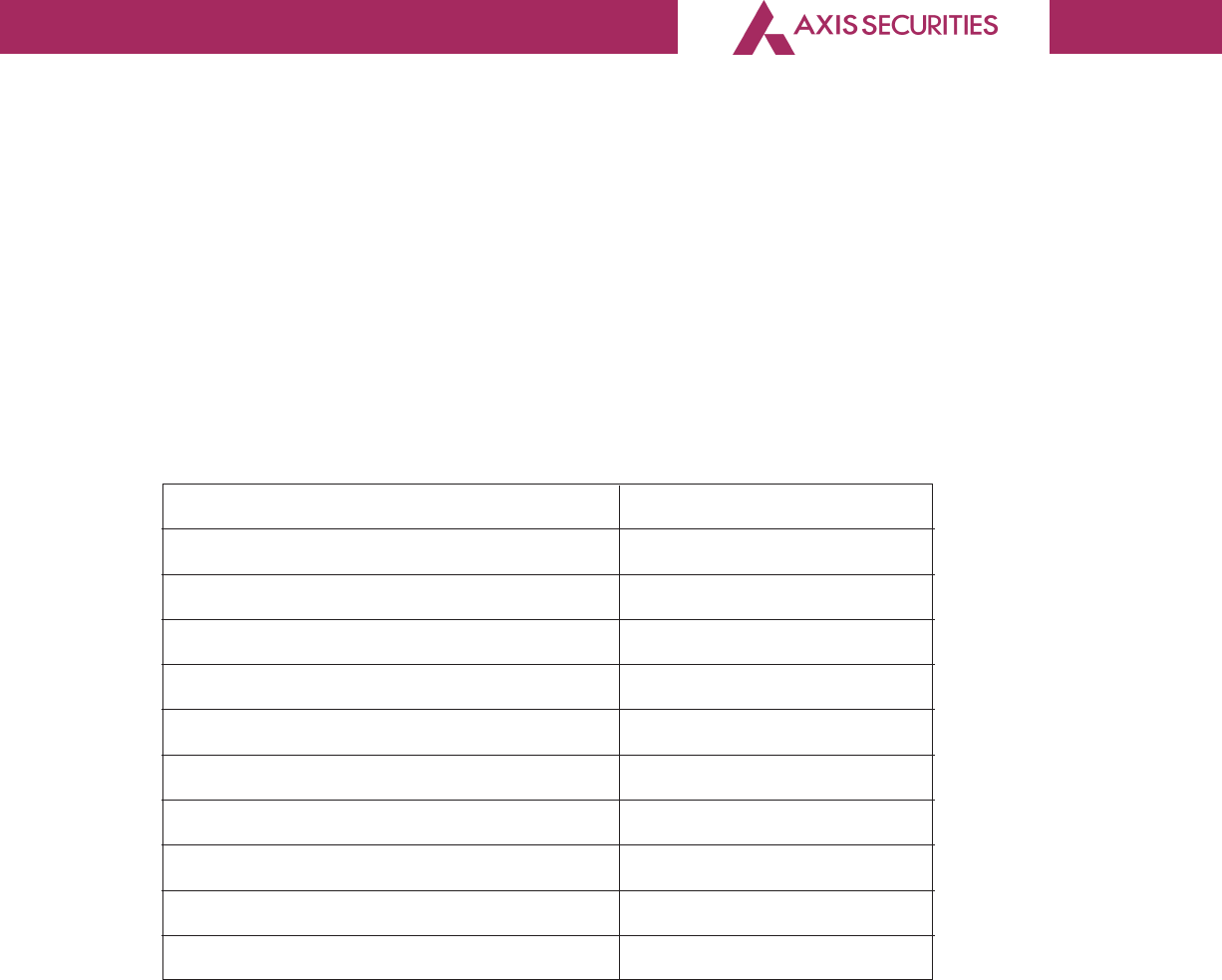
61
A Subsidiary of AXIS BANK
Useful lives and methods of depreciation of property, plant and equipment are reviewed at
each financial year end and adjusted prospectively
Intangible assets are amortised over the useful economic life. The amortisation expense on
intangible assets is presented as a separate line item in the statement of profit and loss.
x. Depreciation and amortization
Depreciation on plant, property and equipment is calculated on a straight-line basis using
the rates arrived at, based on the useful lives estimated by the management.
Depreciation has been provided using the following estimated useful lives:
Useful Life
Leasehold improvements Upon Lease Period
Electrical fittings and other equipments 10 Years
Furniture and fittings 10 Years
Office equipments 5 Years
Computers 3 Years
Mobile phone 2 Years
Softwares 5 Years
EPBAX 8 Years
Softwares 5 Years
Motor Vehicles 4 Years
The residual values, useful lives and methods of depreciation of property, plant and equipment
and intangible assets are reviewed at each financial year end and adjusted prospectively, if
appropriate.
Depreciation on assets sold during the year is recognised on a pro-rata basis to the Statement
of profit and loss till the date of sale of assets.
Intangible assets are amortized on a straight line basis over the estimated useful economic
life
xi. Impairment of tangible and intangible assets
The Company assesses at each reporting date whether there is an indication that an asset
may be impaired. If any indication exists, or when annual impairment testing for an asset is
required, the Company estimates the asset’s recoverable amount. An asset’s recoverable
amount is the higher of an asset’s net selling price and its value in use. The recoverable amount
Notes to financial statements for the year ended 31 March, 2020

62
A Subsidiary of AXIS BANK
is determined for an individual asset, unless the asset does not generate cash inflows that are
largely independent of those from other assets or groups of assets. Where the carrying amount
of an asset exceeds its recoverable amount, the asset is considered impaired and is written
down to its recoverable amount. In assessing value in use, the estimated future cash flows are
discounted to their present value using a pre-tax discount rate that reflects current market
assessments of the time value of money and the risks specific to the asset. In determining net
selling price, recent market transactions are taken into account, if available. If no such
transactions can be identified, an appropriate valuation model is used. After impairment,
depreciation is provided on the revised carrying amount of the asset over its remaining useful
life.
An assessment is made at each reporting date as to whether there is any indication that
previously recognized impairment losses may no longer exist or may have decreased. If such
indication exists, the Company estimates the asset’s recoverable amount. A previously
recognized impairment loss is reversed only if there has been a change in the assumptions
used to determine the asset’s recoverable amount since the last impairment loss was
recognized. The reversal is limited so that the carrying amount of the asset does not exceed
its recoverable amount, nor exceed the carrying amount that would have been determined,
net of depreciation, had no impairment loss been recognized for the asset in prior years. Such
reversal is recognized in the Statement of profit and loss unless the asset is carried at a revalued
amount, in which case the reversal is treated as a revaluation increase.
xii. Leases
Effective April 1, 2019 (date of initial application), the Company has adopted the Indian
Accounting Standard 116 (‘Ind AS 116’), notified by the Ministry of Corporate Affairs (MCA)
which replaces the existing Indian Accounting Standard 17 on Leases (‘Ind AS-17’).The
Company enters into various lease contracts as lessee that conveys the right to use an asset
for a period of time in exchange for a consideration. In addition, the company also assesses
at the inception whether any other arrangement contains a lease by conveying the right to
control the use of an indentified asset for a period of time in exchange for consideration. A
Right-of-use asset is recognised representing its right to use the underlying asset for the lease
term at the lease commencement date except in case of short term lease with a term of
twelve months or less and low value lease which are accounted as an operating expense on
a straight line basis over the lease term. The Cost of the right-of- use asset measured at inception
shall comprise of the amount of the initial measurement of the lease incentives received, plus
any initial direct costs incurred. The right-of-use assets is subsequently measured at cost less
any accumulated depreciation, accumulated impairment losses, if any and adjusted for any
re measurement of the lease liability. The right-of-use assets is depreciated using the straight-
line method from the commencement date over the lease term.Right-of-use assets are tested
for impairment whenever there is any indication that their carrying amounts may not be
recoverable. Impairment loss,if any is recognised in the statement of Profit and Loss.The
Notes to financial statements for the year ended 31 March, 2020

63
A Subsidiary of AXIS BANK
Company measures the lease liability at the present value of the lease payment that are not
paid at the commencement date of the lease. The lease payments are discounted using the
interest rate implicit in the lease and if that rate cannot be readily determined the company
uses the incremental borrowing rate. The lease payments shall includes fixed payment, Variable
lease payments, the amount expected to be payable under the residual value gurantees,
excercise price of purchase options if the company is reasonably certain to excercise that
option and payment of penalties for terminating the lease, if the lease term reflects the
company exercising an option to terminate the lease. Lease Payments have been disclosed
under cash flow from financing activities. Certain lease arrangement includes the option to
extend or terminate the lease before the end of the lease term. Right-to-use assets and lease
liabilities includes these options when it is reasonably certain that they will be excercised.The
lease liabilities are re measured with a corresponding adjustment to the related right-of-use
asset if the company changes its assessment whether it will exercise an extension or a
termination option.
xiii. Borrowings
Borrowing costs include interest expense as per the effective interest rate (EIR) and other
costs incurred by the Company in connection with the borrowing of funds. Borrowing costs
directly attributable to acquisition or construction of those tangible fixed assets which
necessarily take a substantial period of time to get ready for their intended use are capitalized.
Other borrowing costs are recognized as an expense in the year in which they are incurred.
The difference between the discounted amount mobilized and redemption value of
commercial papers is recognized in the statement of profit and loss over the life of the instrument
using the EIR.
xiv. Retirement and other employee benefits
a. Retirement benefits in the form of provident fund is a defined contribution scheme and
the contributions are charged to the Statement of profit and loss of the year when the
contributions to the respective funds are due. There are no obligations other than the
contribution payable to the provident fund.
b. Gratuity liability is a defined benefit obligation and is provided for on the basis of an
actuarial valuation using projected unit credit method, made at each year end.
Company recognizes the service cost (past and current), gain and losses on curtailment,
non-routine settlement, net interest income or expense to Profit and Loss. Re-
measurement comprising of actuarial gain and losses on obligations/plan assets due to
change in demographic, financial assumptions and experience are recognized
immediately in the balance sheet with corresponding debit or credit to retained earnings
in the period in which they occur through OCI under items that will not be reclassified to
profit or loss.
Notes to financial statements for the year ended 31 March, 2020

64
A Subsidiary of AXIS BANK
xv. Income taxes
Current income tax
Current income tax is measured at the amount expected to be paid to the tax authorities in
accordance with the Income Tax Act, 1961. The tax rates and tax laws used to compute the
amount are those that are enacted or substantively enacted, at the reporting date.
Current income tax relating to items recognized outside profit or loss is recognised outside
profit or loss (either in other comprehensive income or equity). Current tax items are recognised
in correlation to the underlying transaction either in OCI or directly in equity. Management
periodically evaluates positions taken in the tax returns with respect to situations in which
applicable tax regulations are subject to interpretation and establishes provisions where
appropriate.
Deferred income tax
a. Deferred tax is provided using the liability method on temporary differences between
the tax bases of assets and liabilities and their carrying amounts for financial reporting
purposes at the reporting date.
b. Deferred tax liabilities are recognised for all taxable temporary differences, except:
When the deferred tax liability arises from the initial recognition of goodwill or an asset or
liability in a transaction that is not a business combination and, at the time of the
transaction, affects neither the accounting profit nor taxable profit or loss.
c. Deferred tax assets are recognised for all deductible temporary differences, the carry
forward of unused tax credits and any unused tax losses. Deferred tax assets are
recognised to the extent that it is probable that taxable profit will be available against
which the deductible temporary differences, and the carry forward of unused tax credits
and unused tax losses can be utilized, except:
d. When the deferred tax asset relating to the deductible temporary difference arises from
the initial recognition of an asset or liability in a transaction that is not a business
combination and, at the time of the transaction, affects neither the accounting profit
nor taxable profit or loss.
e. The carrying amount of deferred tax assets is reviewed at each reporting date and
reduced to the extent that it is no longer probable that sufficient taxable profit will be
available to allow all or part of the deferred tax asset to be utilized. Unrecognised deferred
tax assets are re-assessed at each reporting date and are recognised to the extent that
it has become probable that future taxable profits will allow the deferred tax asset to be
recovered.
f. Deferred tax assets and liabilities are measured at the tax rates that are expected to
apply in the year when the asset is realized or the liability is settled, based on tax rates
Notes to financial statements for the year ended 31 March, 2020

65
A Subsidiary of AXIS BANK
Notes to financial statements for the year ended 31 March, 2020
(and tax laws) that have been enacted or substantively enacted at the reporting
date.
g. Deferred tax relating to items recognised outside profit or loss is recognised outside profit
or loss (either in other comprehensive income or in equity). Deferred tax items are
recognised in correlation to the underlying transaction either in OCI or directly in equity.
h. Deferred tax assets and deferred tax liabilities are offset if a legally enforceable right
exists to set off current tax assets against current tax liabilities and the deferred taxes
relate to the same taxable entity and the same taxation authority.
i. Tax benefits acquired as part of a business combination, but not satisfying the criteria for
separate recognition at that date, are recognised subsequently if new information about
facts and circumstances change. Acquired deferred tax benefits recognised within the
measurement period reduce goodwill related to that acquisition if they result from new
information obtained about facts and circumstances existing at the acquisition date. If
the carrying amount of goodwill is zero, any remaining deferred tax benefits are
recognised in OCI/ capital reserve depending on the principle explained for bargain
purchase gains. All other acquired tax benefits realized are recognised in profit or loss.
xvi. Foreign currency transactions
Foreign currency transactions are recorded at the exchange rate prevailing on the date of
transaction. Monetary items denominated in foreign currencies are restated at the exchange
rate prevailing on the balance sheet date. Exchange differences arising on settlement of
transaction and on account of restatement of monetary items are dealt with in the Statement
of profit and loss.
xvii. Earnings per share
Basic earnings per share is calculated by dividing the net profit or loss for the period attributable
to equity shareholders (after deducting attributable taxes) by the weighted average number
of equity shares outstanding during the period from continuing and discontinued operations
separately.
For the purpose of calculating diluted earnings per share, the net profit or loss for the period
attributable to equity shareholders and the weighted average number of shares outstanding
during the period are adjusted for the effects of all dilutive potential equity shares from
continuing and discontinued operations separately.
xviii.Share based payments
Share based payment arrangement includes arrangement between entity and employees.
Most common application is Employee stock options (ESOP) payment. All transactions involving
share based payment are recognized as expenses or assets over underlying vesting period.

66
A Subsidiary of AXIS BANK
Notes to financial statements for the year ended 31 March, 2020
All equity settled share based payments are measured at fair value as on grant date for
employee services and expenses are recognized over vesting period.
Equity Settled Transaction
The cost of equity-settled transactions is determined by the fair value at the date when the
grant is made using an appropriate valuation model.
That cost is recognized, together with a corresponding increase in share-based payment (SBP)
reserves in equity, over the period in which the performance and/or service conditions are
fulfilled in employee benefits expense. The cumulative expense recognized for equity-settled
transactions at each reporting date until the vesting date reflects the extent to which the
vesting period has expired and the Company’s best estimate of the number of equity
instruments that will ultimately vest. The statement of profit and loss expense or credit for a
period represents the movement in cumulative expense recognized as at the beginning and
end of that period and is recognized in employee benefits expense.
Service and non-market performance conditions are not taken into account when determining
the grant date fair value of awards, but the likelihood of the conditions being met is assessed
as part of the Company’s best estimate of the number of equity instruments that will ultimately
vest. Market performance conditions are reflected within the grant date fair value. Any other
conditions attached to an award, but without an associated service requirement, are
considered to be non-vesting conditions. Non-vesting conditions are reflected in the fair value
of an award and lead to an immediate expensing of an award unless there are also service
and/or performance conditions.
No expense is recognized for awards that do not ultimately vest because non-market
performance and/or service conditions have not been met. Where awards include a market
or non-vesting condition, the transactions are treated as vested irrespective of whether the
market or non-vesting condition is satisfied, provided that all other performance and/or service
conditions are satisfied.
When the terms of an equity-settled award are modified, the minimum expense recognized is
the expense had the terms had not been modified, if the original terms of the award are met.
An additional expense is recognized for any modification that increases the total fair value of
the share-based payment transaction, or is otherwise beneficial to the employee as measured
at the date of modification. Where an award is cancelled by the entity or by the counterparty,
any remaining element of the fair value of the award is expensed immediately through profit
or loss.
xix. Provisions
A provision is recognized when the Company has a present obligation as a result of past
event; it is probable that an outflow of resources will be required to settle the obligation, in
respect of which a reliable estimate can be made of the amount of obligation. Provisions are

67
A Subsidiary of AXIS BANK
not discounted to its present value and are determined based on best estimate required
to settle the obligation at the reporting date. These are reviewed at each reporting
date and adjusted to reflect the current best estimates.
xx Cash and cash equivalents
Cash and cash equivalents for the purposes of cash flow statement comprise cash at
bank and in hand and short-term investments with an original maturity of three months
or less.
xxi. Contingent liabilities
A contingent liability is a possible obligation that arises from past events whose existence
will be confirmed by the occurrence or non-occurrence of one or more uncertain future
events beyond the control of the Company or a present obligation that is not recognized
because it is not probable that an outflow of resources will be required to settle the
obligation. A contingent liability also arises in extremely rare cases where there is a liability
that cannot be recognized because it cannot be measured reliably. The Company
does not recognize a contingent liability but discloses its existence in the financial
statements.
When there is a possible obligation or a present obligation in respect of which the
likelihood of outflow of resources is remote, no provision or disclosure is made.
2.2 Changes in accounting policies and disclosures
New and amended standards
The Company applied Ind AS 116 Leases for the first time. The nature and effect of the changes
as a result of adoption of this new accounting standard is described below.
Ind AS 116 Leases
The Company adopted Ind AS 116 using the modified retrospective method of adoption,
with the date of initial application on 1 April 2019. As modified retrospective method of adoption
is applied, comparative figures are not restated and the cumulative effect of initially applying
the standard is recognised as an adjustment to the opening balance of retained earnings (or
other component of equity, as appropriate) at the date of initial application. The Company
elected to use the transition practical expedient to not reassess whether a contract is, or
contains, a lease at 1 April 2019. Instead, the Company applied the standard only to contracts
that were previously identified as leases applying Ind AS 17 at the date of initial application.
The Company also elected to use the recognition exemptions for lease contracts that, at the
commencement date, have a lease term of 12 months or less and do not contain a purchase
option (short-term leases), and lease contracts for which the underlying asset is of low value
(low-value assets).
Notes to financial statements for the year ended 31 March, 2020
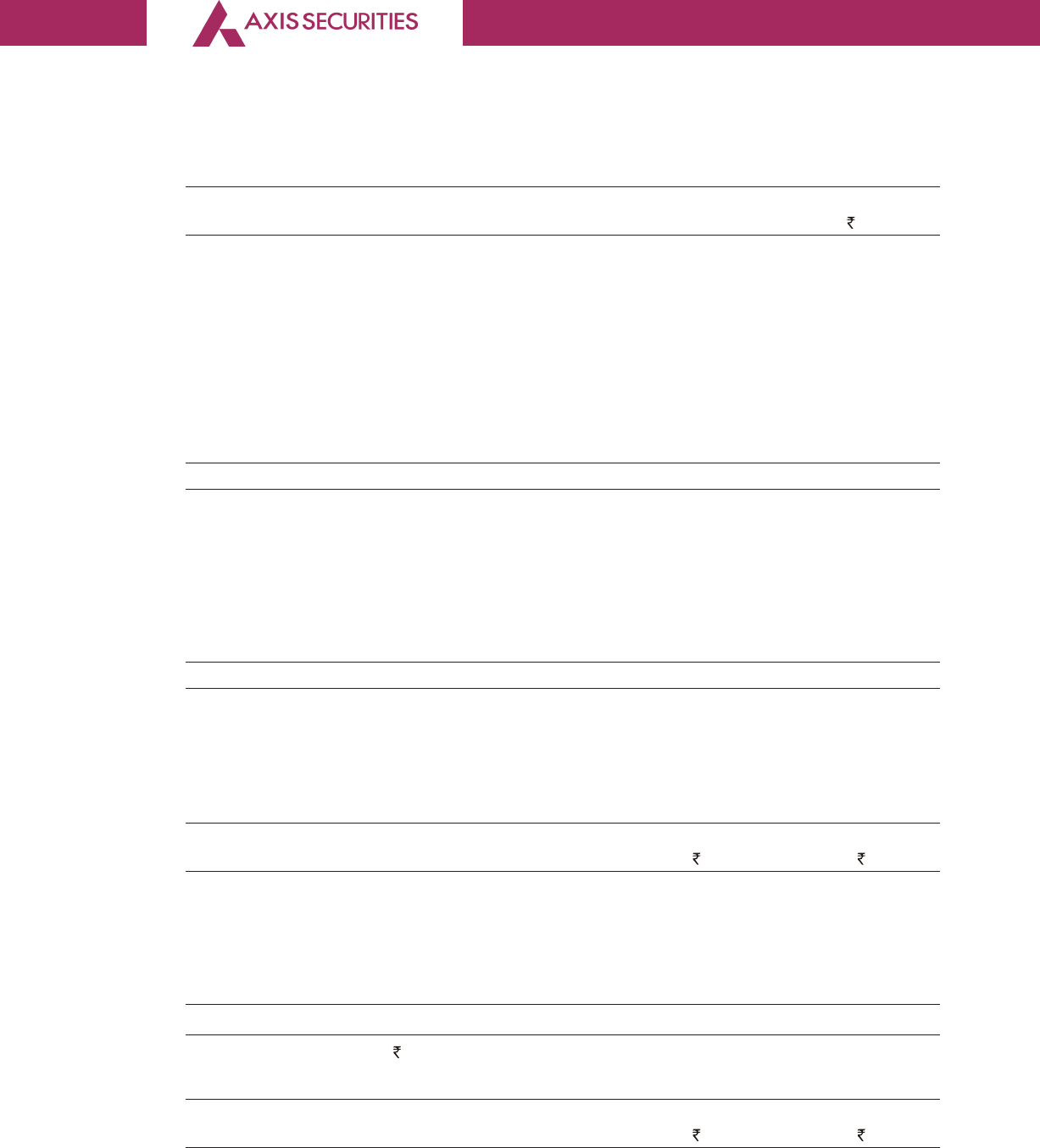
68
A Subsidiary of AXIS BANK
Impact on consolidated balance sheet (increase / (decrease))
31 March 2020
( in Lakhs)
Assets
Right-of-use assets 1,305
Total assets 1,305
Equity
Retained earnings 494
Total equity 494
Liabilities
Lease liabilities (1,651)
Deferred tax liabilities 87
Total liabilities (1,564)
Impact on statement of profit and loss (increase/(decrease) in profit)
31 March 2020
Depreciation and amortisation 803
Other expenses (1,202)
Finance cost 161
Profit for the period (238)
Attributable to:
Equity holders of the parent (238)
Depreciation and amortisation 803
Impact on consolidated statement of cash flows (increase/(decrease)
31 March 2020
Operating lease payments* (1,202)
Net cash flows from operating activities (1,202)
Payment of principal portion of lease liabilities 1,651
Payment of interest portion of lease liabilities 161
3. Cash and cash equivalents
31 March 2020 31 March 2019
( in Lakhs) ( in Lakhs)
Cash and cash equivalents
Balances with banks :
– In current accounts 12,235 4,587
– Balance in prepaid cards 2 1
– Deposits with original maturity of less than three months – 4,000
Cash in hand 0* –
12,237 8,588
* The Amount is less than 50,000/-
4. Bank balances other than (3 above)
31 March 2020 31 March 2019
( in Lakhs) ( in Lakhs)
Bank balances
– Deposits with original maturity for more than 12 months – 2
– Deposits with original maturity for more than 11,974 13,185
12 months under lien
Notes forming part of the financial statements for the year ended 31 March, 2020
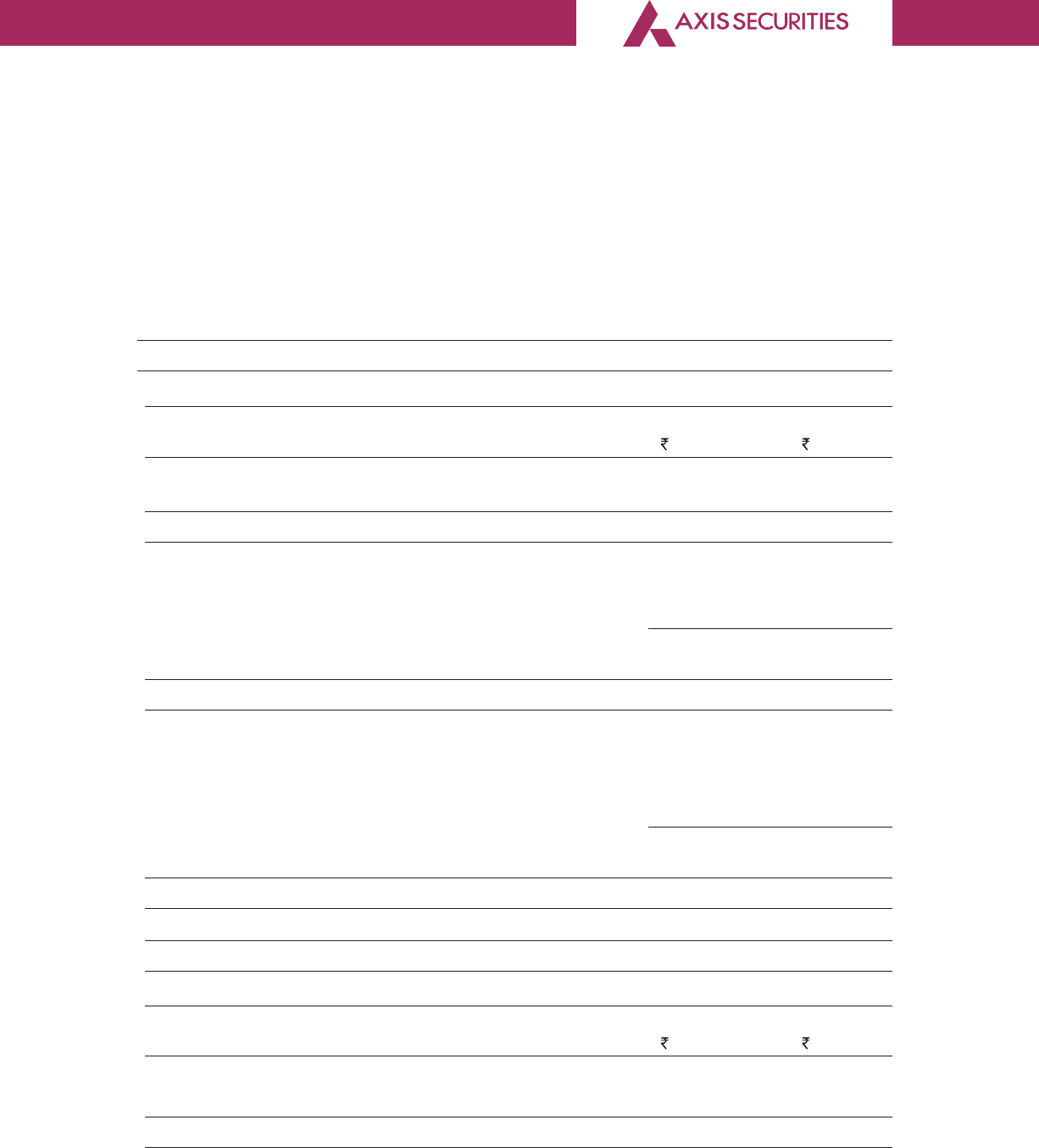
69
A Subsidiary of AXIS BANK
Notes forming part of the financial statements for the year ended 31 March, 2020
– Deposits with original maturity for more than – –
3 months but less than 12 months
– Deposits with original maturity for more than 4,431 –
3 months but less than 12 months under lien
– Deposits with original maturity for less than 7,995
3 months under lien
24,400 13,187
5. Trade Receivables
Particulars 31 March 2020 31 March 2019
( in Lakhs) ( in Lakhs)
Receivables from others 2,778 5,311
Receivables from other related parties (Note) 18 –
2,796 5,311
Break-up for security details:
Unsecured, considered good unless stated otherwise
Unsecured, considered good – –
Doubtful 189 187
189 187
Allowances for Impairement Loss (189) (187)
(A) – –
Other receivables
Unsecured considered good
- Due from holding company 18 –
- Due from others 2,778 5,311
Doubtful 38 45
2,834 5,356
Allowances for Impairement Loss (38) (45)
(B) 2,796 5,311
Other receivables ––
Total 2,796 5,311
6. Loans
Particulars 31 March 2020 31 March 2019
( in Lakhs) ( in Lakhs)
Funding under margin trading facility (secured)* 4,320 10,263
Less: Provision on Funding under margin trading facility (22) –
4,298 10,263
* This represent the margin trading facility extended to broking customers which are fully
secured against cash and/ or collateral of approved securities.
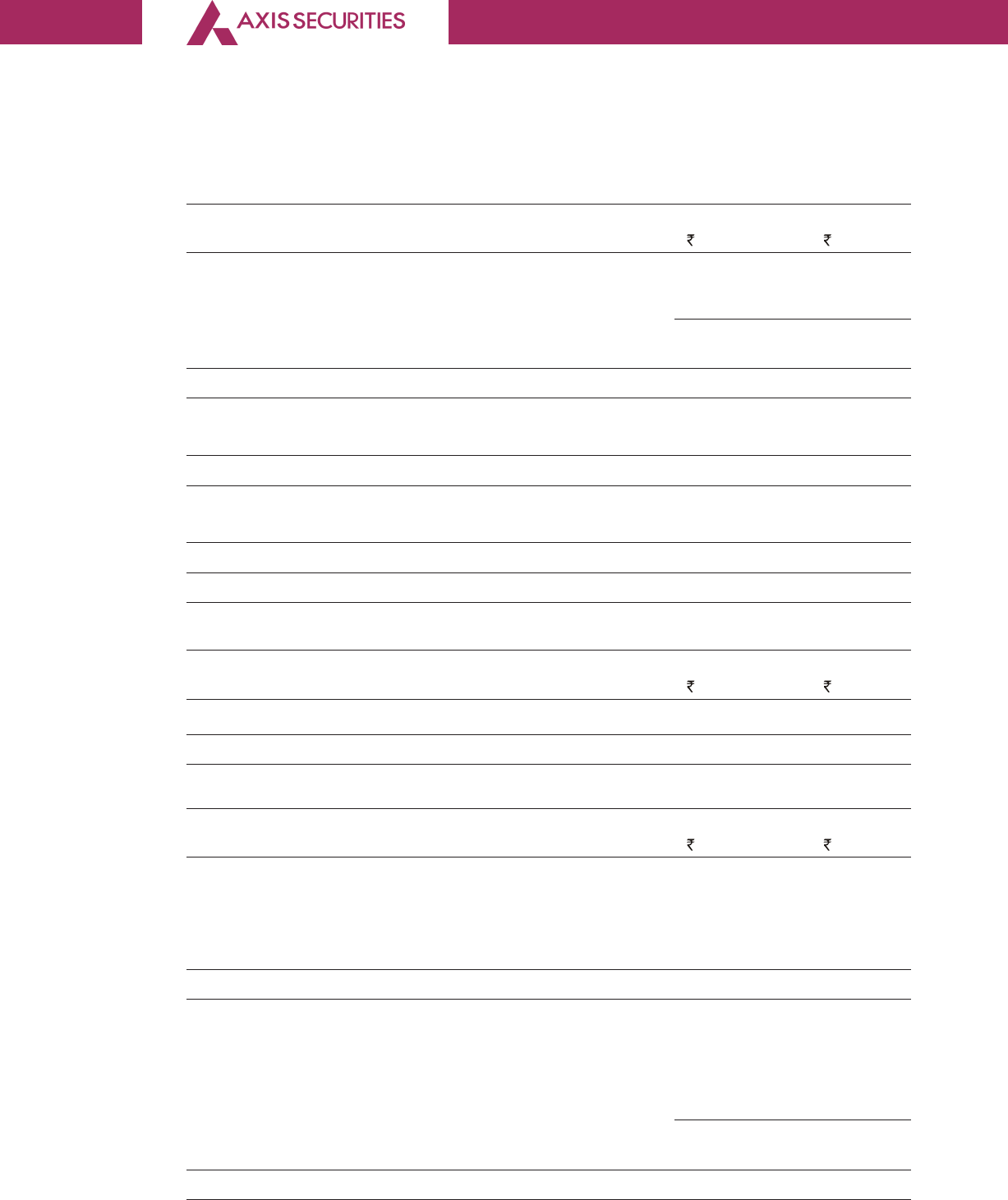
70
A Subsidiary of AXIS BANK
Notes forming part of the financial statements for the year ended 31 March, 2020
7. Other Financial Asset
Particulars 31 March 2020 31 March 2019
( in Lakhs) ( in Lakhs)
Security deposit
- Unsecured, considered good 525 526
- Unsecured, considered doubtful 26 21
551 547
Less: Provision for doubtful receivable (26) (21)
A 525 526
Non-current bank balances - Fixed Deposits 4,889 970
Interest accrued on fixed deposits 167 252
B 5,056 1,222
Others
Other receivables 700 –
C 700 –
Total (A) + (B)+ ( C) 6,281 1,748
8. Current Tax assets (net)
Particulars 31 March 2020 31 March 2019
( in Lakhs) ( in Lakhs)
Advance income-tax (net) 2,850 2,816
2,850 2,816
9. Deffered Tax
Particulars 31 March 2020 31 March 2019
( in Lakhs) ( in Lakhs)
Compensated Absense Cost – 48
Gratuity 58 135
Rent 190 135
Doubtful debts/ receivables 78 89
FA Difference 178 167
504 574
OCI section
Deferred tax related to items recognised in OCI during in the year:
Deferred Tax -IGAAP 504 574
On Subscription – 630
On Employee benefit plan (17) (81)
Deferred Tax Adjustment IND AS B/S (17) 549
Deferred Tax- Ind AS-OCI 17 81
Deferred Tax Asset In IND AS B/S 504 1,204
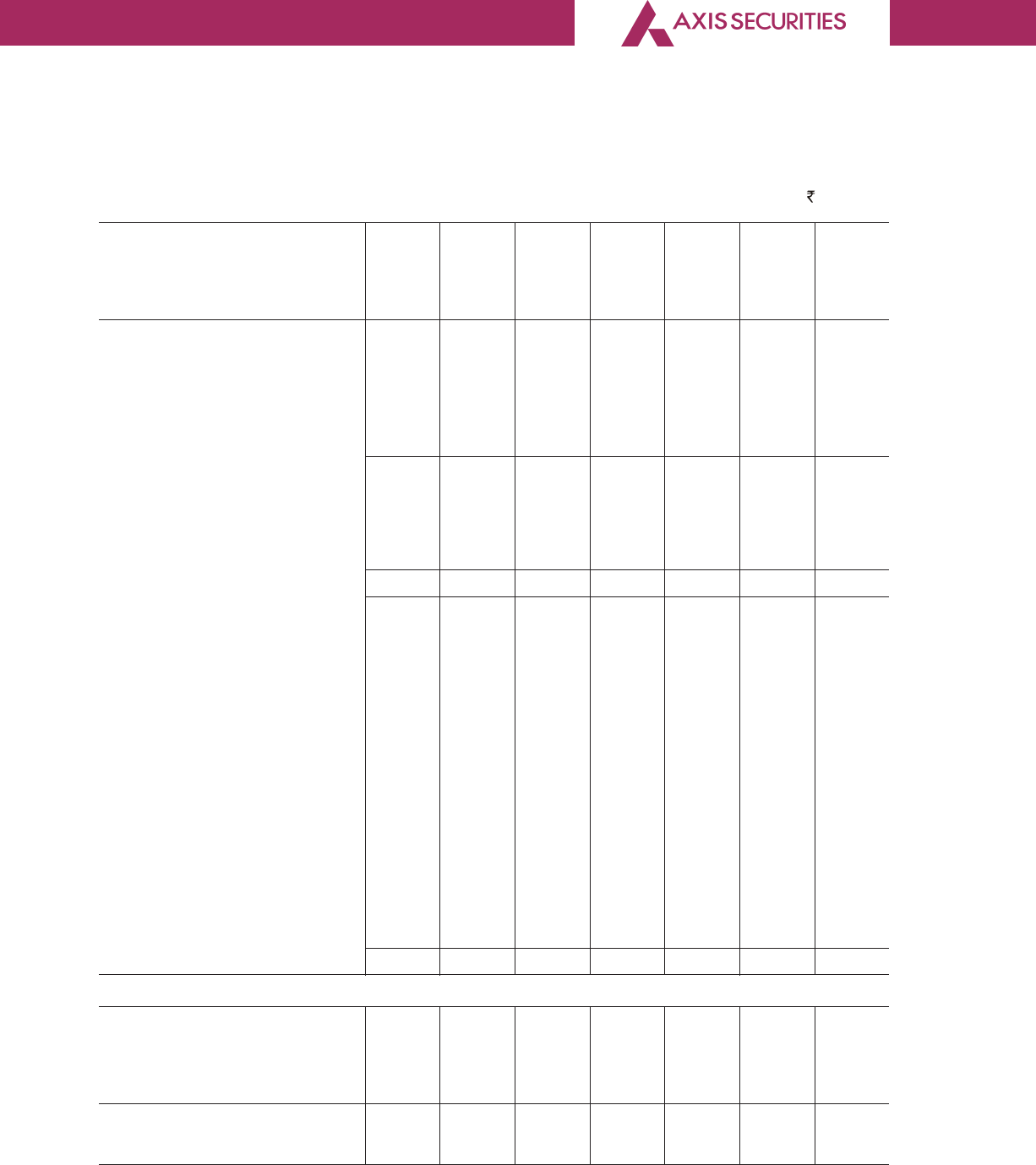
71
A Subsidiary of AXIS BANK
10. Property, Plant and Equipment
( in Lakhs)
Particulars Improve- Furniture Office Com- Motor Capital Total
ments to equip- puters vehicle work
leasehold ment in
premises progress
Cost or valuation
At 1 April 2018 1,202 1,231 970 2,309 – 156 5,868
Additions 98 120 71 365 – 35 689
Disposals 74 103 77 24 – 278
Discontinued operations 636 950 234 338 – 2,159
At 1 April 2019 590 297 730 2,311 – 35 3,964
Inter Departmental Transfer 636 950 234 338 – 2,159
Additions 89 – 14 628 69 799
Disposals 655 966 285 321 – 2,227
At 31 March 2020 660 281 693 2,957 69 – 4,660
Depreciation and impairment
At 1 April 2018 418 433 537 1,746 – – 3,134
Depreciation charge for the
year 148 131 160 423 – 863
Disposals 32 46 46 22 – 146
Impairment 25 31 5 – – 62
Discontinued operations 223 381 141 272 – 1,016
At 1 April 2019 337 169 516 1,876 – – 2,897
Inter Departmental Transfer 223 381 141 272 – 1,016
Depreciation charge for the 133 85 126 316 4 664
period
Disposals 289 460 202 297 – 1,247
Impairment 71 42 (1) – – 112
At 31 March 2020 475 216 580 2,167 4 – 3,442
Net Book Value Improve- Furniture Office Com- Motor Capital Total
ments to equip- puters vehicle work
leasehold ment in
premises progress
At 31 March 2020 185 65 113 790 65 – 1,218
At 31 March 2019 254 129 213 435 – 35 2,209
Notes forming part of the financial statements for the year ended 31 March, 2020
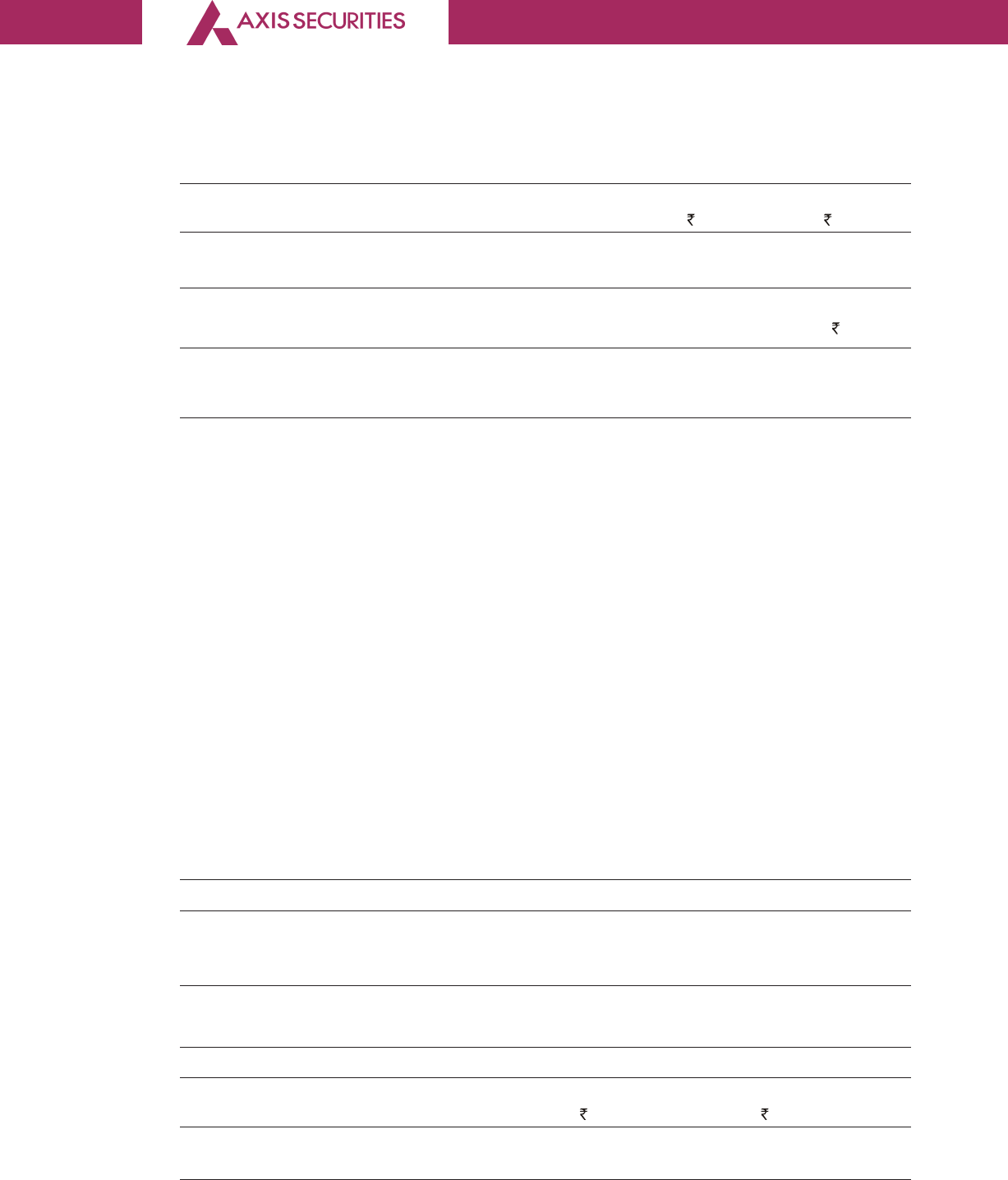
72
A Subsidiary of AXIS BANK
Notes forming part of the financial statements for the year ended 31 March, 2020
Particulars 31 March 2020 31 March 2019
( in Lakhs) ( in Lakhs)
Property, plant and equipment 1,218 1,031
Capital work in progress – 35
10. Other Intangible assets
( in Lakhs)
Particulars Software Intangible Total
asset under
development
Cost or valuation
At 1 April 2018 2,968 66 3,034
Additions 601 42 643
Disposals 1 66 67
Discontinued operations 261 – 261
At 1 April 2019 3,307 42 3,349
Interdepartmental Transfer 261 – 261
Additions 616 193 809
Disposals 212 – 212
At 31 March 2020 3,972 235 4,207
Depreciation and impairment
At 1 April 2018 1,580 – 1,580
Additions 450 450
Disposals 1 1
Discontinued operations 108 108
At 1 April 2019 1,921 – 1,921
Interdepartmental Transfer 108 108
Depreciation charge for the year 558 558
Disposals 112 112
At 31 March 2020 2,475 – 2,475
Net Book Value Software Intangible Total
asset under
development
At 31 March 2020 1,497 235 1,732
At 31 March 2019 1,386 42 1,428
Net Book Value 31 March 2020 31 March 2019
( in Lakhs) ( in Lakhs)
Other Intangible assets 1,497 1,386
Intangible asset under development 235 42
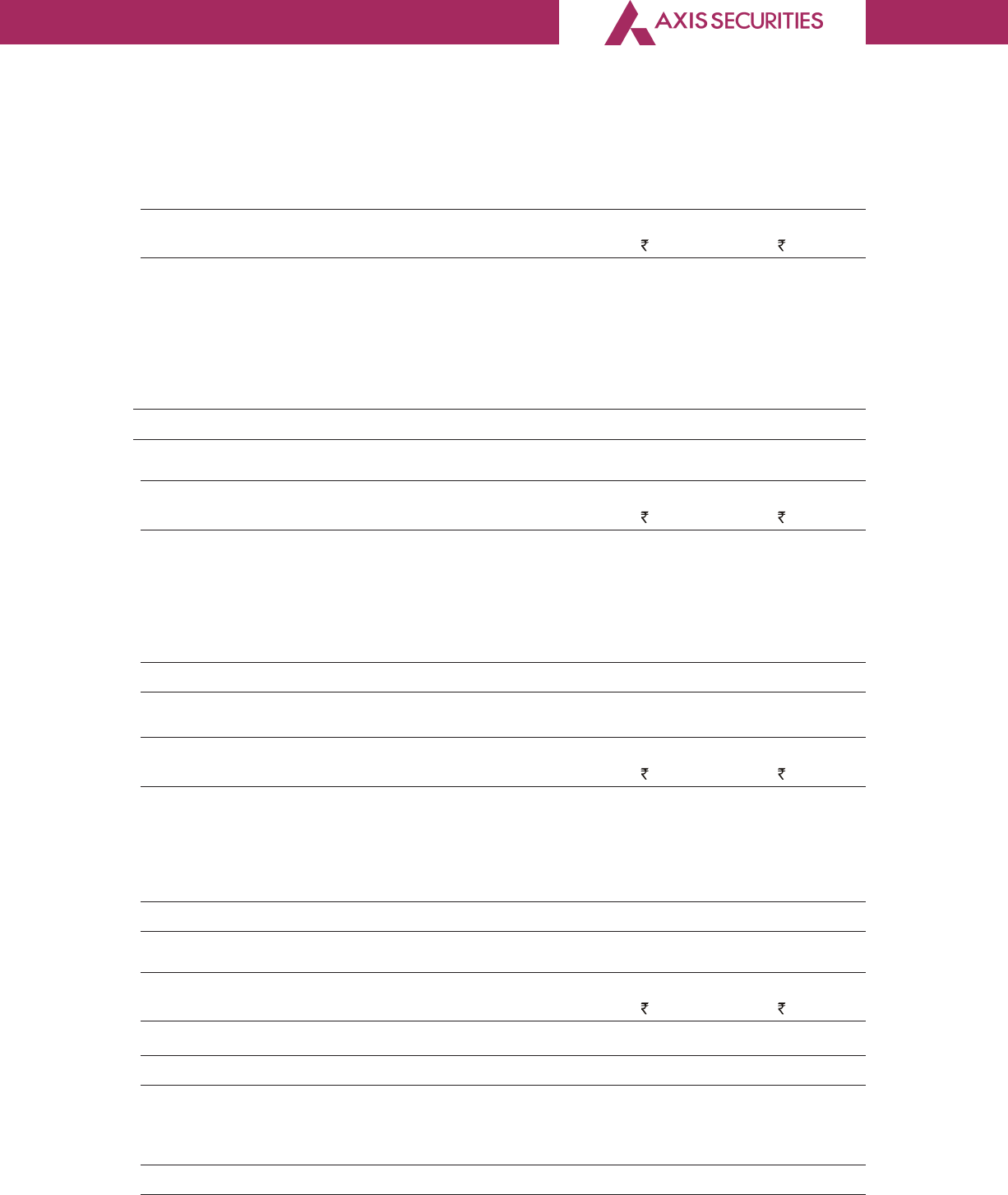
73
A Subsidiary of AXIS BANK
Notes forming part of the financial statements for the year ended 31 March, 2020
11. Other non-financial asset
Particulars 31 March 2020 31 March 2019
( in Lakhs) ( in Lakhs)
Capital Advances ––
Advances recoverable in cash or kind 327 90
Others
Prepaid expenses 314 283
Balances with statutory / government authorities 242 145
883 518
12. Trade Payables
Particulars 31 March 2020 31 March 2019
( in Lakhs) ( in Lakhs)
Trade payables
a) Total outstanding dues of micro enterprises
and small enterprises – –
b) Total outstanding dues of creditors other than
micro enterprises and small enterprises 19,826 11,928
Total 19,826 11,928
13. Other Financial Liabilities
Particulars 31 March 2020 31 March 2019
( in Lakhs) ( in Lakhs)
Overdraft Balances 16 1
Expense creditors
- Due to holding company 89 86
- Due to others 87 5
Total 192 92
14. Provisions
Particulars 31 March 2020 31 March 2019
( in Lakhs) ( in Lakhs)
Provision for bonus 1,919 989
A 1,919 989
Provision for employee benefits
Gratuity payable 228 275
Leave availment payable – 123
B 228 398
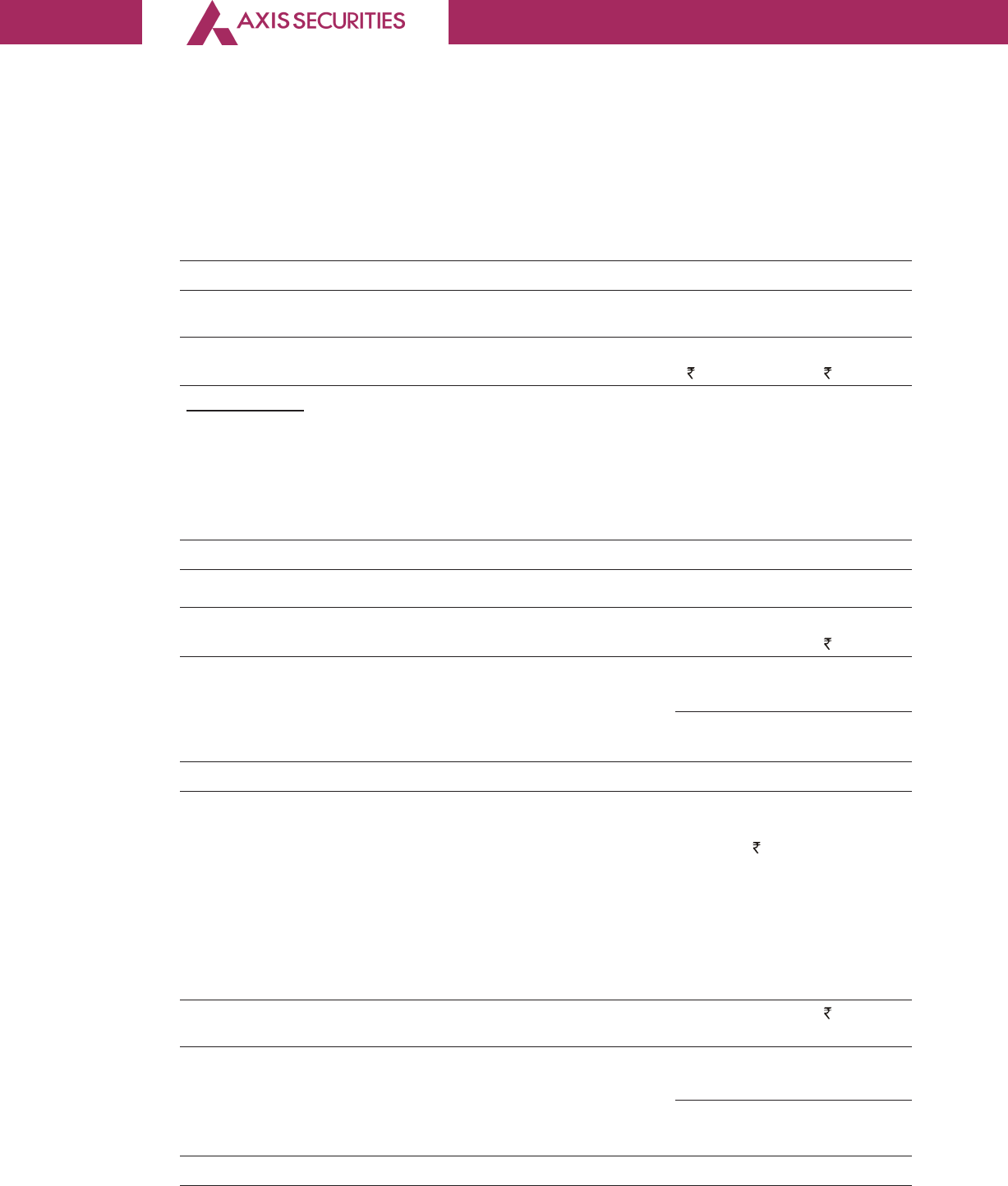
74
A Subsidiary of AXIS BANK
Others
Provision for expenses 1,190 721
C 1,190 721
Total (A) + (B)+ ( C) 3,337 2,108
15. Other non-financial Liabilities
Particulars 31 March 2020 31 March 2019
( in Lakhs) ( in Lakhs)
Other liabilities
Income received in advance 111 2,894
Undisputed statutory dues 654 364
Sundry creditors for capital expenditure 20 55
Salary & incentive payable 848 –
Others 283 262
1,916 3,575
16. Authorized Share Capital
Particulars Equity Shares
(No. in Lakhs) ( in Lakhs)
At 1 April 2018 1,500 15,000
Increase/(decrease) during the year – –
At 31 March 2019 1,500 15,000
Increase/(decrease) during the year 1,000 10,000
At 31 March 2020 2,500 25,000
Terms/ rights attached to equity shares
The Company has only one class of equity shares having par value of 10 per share. Each
holder of equity shares is entitled to one vote per share. The company declares and pays
dividends in Indian rupees. The dividend proposed by the Board of Directors is ratified by the
shareholders in the ensuing Annual General Meeting. In the event of liquidation of the
Company, the holders of equity shares will be entitled to receive remaining assets of the
Company, after distribution of all preferential amounts. The distribution will be in proportion to
the number of equity shares held by the shareholders.
Issued, Subscribed & Paid-up (No. in Lakhs) ( in Lakhs)
Equity Shares of INR 10 each issued, subscribed and fully paid
At 1 April 2018 1,445 14,450
Change during the year – –
At 31 March 2019 1,445 14,450
Changes during the year – –
At 31 March 2020 1,445 14,450
Notes forming part of the financial statements for the year ended 31 March, 2020

75
A Subsidiary of AXIS BANK
Shares held by holding/ ultimate holding company and/ or their subsidiaries/ associates
Out of equity shares issued by the Company, shares held by its holding company, ultimate
holding company and their subsidiaries/associates are as below:
31 March 2020 31 March 2019
Axis Bank Limited, the holding company and its 14,450 14,450
nominees 1,445 Lacs (31 March 2019: 1,445 Lacs)
equity shares of
INR
10/- each
Details of shareholders holding more than 5% shares in the Company
Name of the Shareholder
31 March 2020 31 March 2019
Nos. % Nos. %
Axis Bank Limited, the holding company 1445 100.00 1445 100.00
and its nominees
As per records of the Company, including its register of shareholders/ members and other
declarations received from shareholders regarding beneficial interest, the above shareholding
represents both legal and beneficial ownerships of shares.
17. Other Equity
Capital reserve ( in Lakhs)
At 1 April 2018 4
Changes during the year –
At 31 March 2019 4
Changes during the year –
At 31 March 2020 4
Securities premium
At 1 April 2018 1,525
Changes during the year –
At 31 March 2019 1,525
Changes during the year –
At 31 March 2020 1,525
General reserve
At 1 April 2018 1,479
Changes during the year 775
At 31 March 2019 2,254
Changes during the year 159
At 31 March 2020 2,413
Notes forming part of the financial statements for the year ended 31 March, 2020
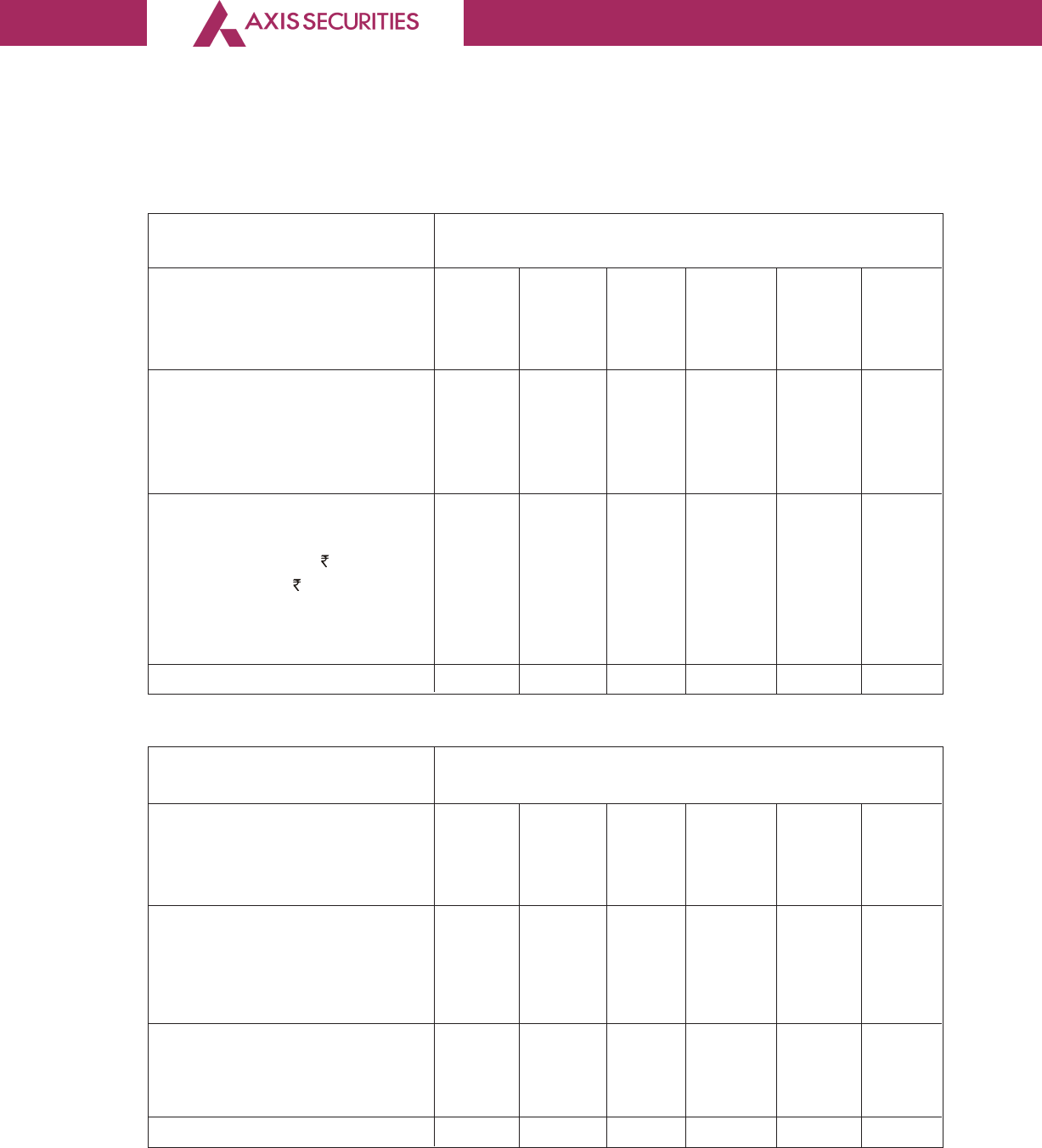
76
A Subsidiary of AXIS BANK
For the period ended 31 March 2020
Attributable to the equity holders of the parent
Reserves and Surplus
Capital Securities General Retained Other Deemed
reserve premium reserve earnings Compre- Equity
hensive
Income
As at 1 April 2019 4 1,525 2,254 14,439 (150) 475
Profit for the year 2,734 – 115
Other comprehensive income – 264 –
Additions during the year (521) –
Total comprehensive income 16,652 114 590
Final Equity dividend for FY 18-19
[(amount per share 2.30
(31 March 2018: 19,50,75,000)] (3,324)
Tax on equity dividend (683)
Transfer to General Reserve 159 (159)
At 31 March 2020 4 1,525 2,413 12,486 114 590
For the period ended 31 March 2020
Attributable to the equity holders of the parent
Reserves and Surplus
Capital Securities General Retained Other Deemed
reserve premium reserve earnings Compre- Equity
hensive
Income
As at 1 April 2018 4 1,525 1,479 7,952 (175) 320
Profit for the year ended
31 March 2019 7,262 115
Other comprehensive income – 25 –
Total comprehensive income 4 1,525 1,479 15,214 (150) 475
Transfer to General Reserve 775 (775)
Tax on equity dividend
At 31 March 2020 4 1,525 2,254 14,439 (150) 475
Captial reserve
Capital reserve is created by capital profits of the company which is not kept for distribution to the
shareholders in the form of dividend.This is included in the retained earning statements
Notes forming part of the financial statements for the year ended 31 March, 2020
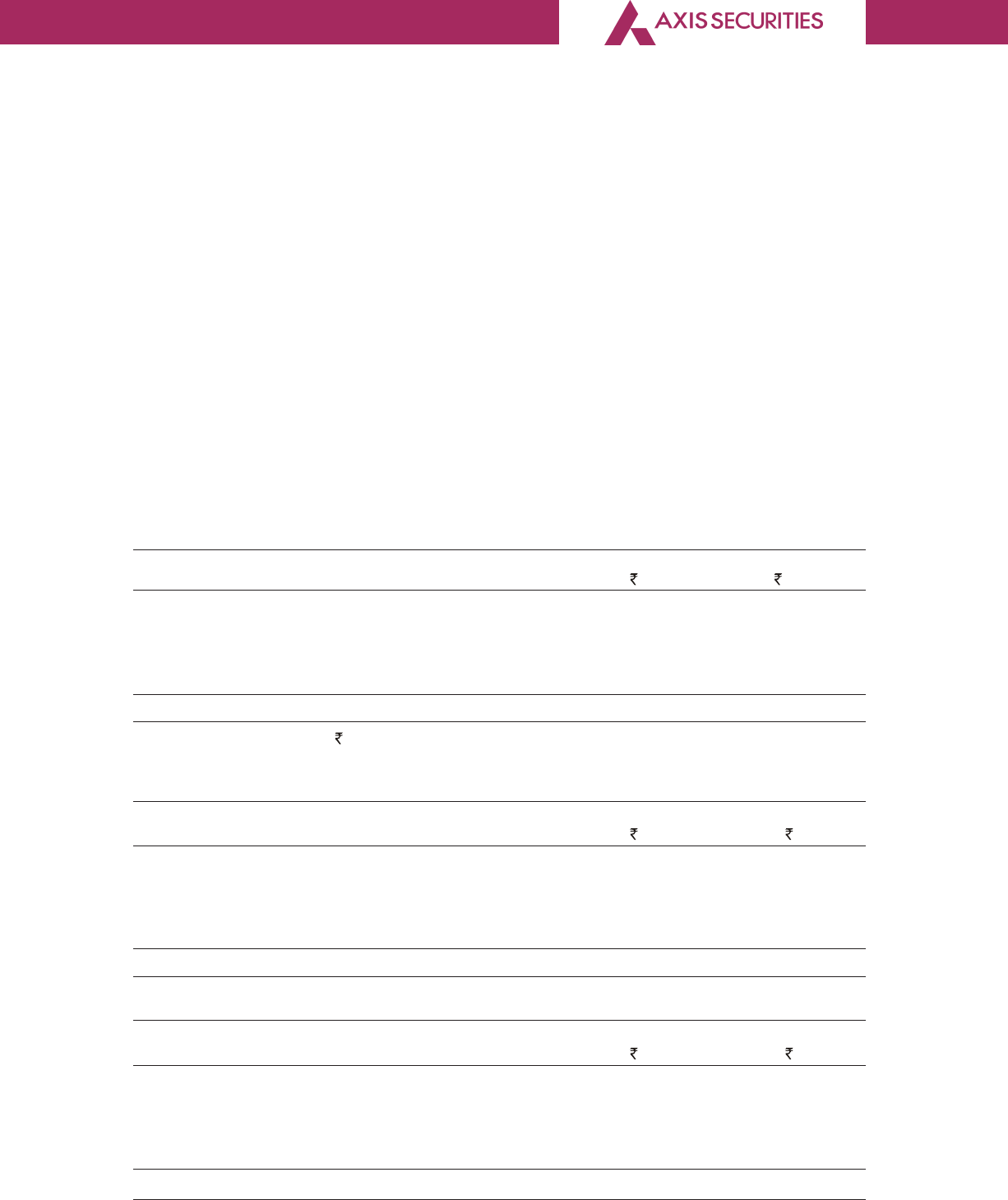
77
A Subsidiary of AXIS BANK
Securities premium reserve
Securities premium reserve is used to record the premium on issue of shares. The reserve can be
utilised only for limited purpose such as issuance of bonus shares in accordance with the provision
of Companies Act.
General reserve
Under the erstwhile Companies Act, 1956, general reserve was created through an annual transfer
of net income at a specified percentage in accordance with applicable regulations. The purpose
of these transfers was to ensure that if a dividend distribution in a given year is more than 10% of
the paid up capital of the company for that year, then the total dividend distribution is less than
the total distributable results for that year. Consequent to introduction of Companies Act, 2013,
the requirement to mandatorily transfer a specified percentage of the net profit to general reserve
has been withdrawn. However, the amount previously transferred to general reserve can be utilised
only in accordance with the specific requirements of Companies Act, 2013.
18. Other income
31 March 2020 31 March 2019
( in Lakhs) ( in Lakhs)
Interest income on bank deposits & income tax refund 1,185 737
Profit on sale of investments (fair value through P & L) 129 75
Miscellaneous income 0* 4
Interest Accretion (Right of Use Asset) 15 –
Total 1,329 816
* The Amount is less than 50,000/-
19. Employee benefits expense
31 March 2020 31 March 2019
( in Lakhs) ( in Lakhs)
Salaries, wages and bonus 6,886 8,706
Contribution to provident and other funds 285 422
Staff welfare expenses 64 61
Gratuity expense 178 339
Total 7,413 9,528
20. Depreciation and amortization expense
31 March 2020 31 March 2019
( in Lakhs) ( in Lakhs)
Depreciation of tangible assets 483 590
Amortization of intangible assets 525 411
Impairment of tangible assets 112 62
Amortization of right-of-use assets 318 –
1,438 1,063
Notes forming part of the financial statements for the year ended 31 March, 2020
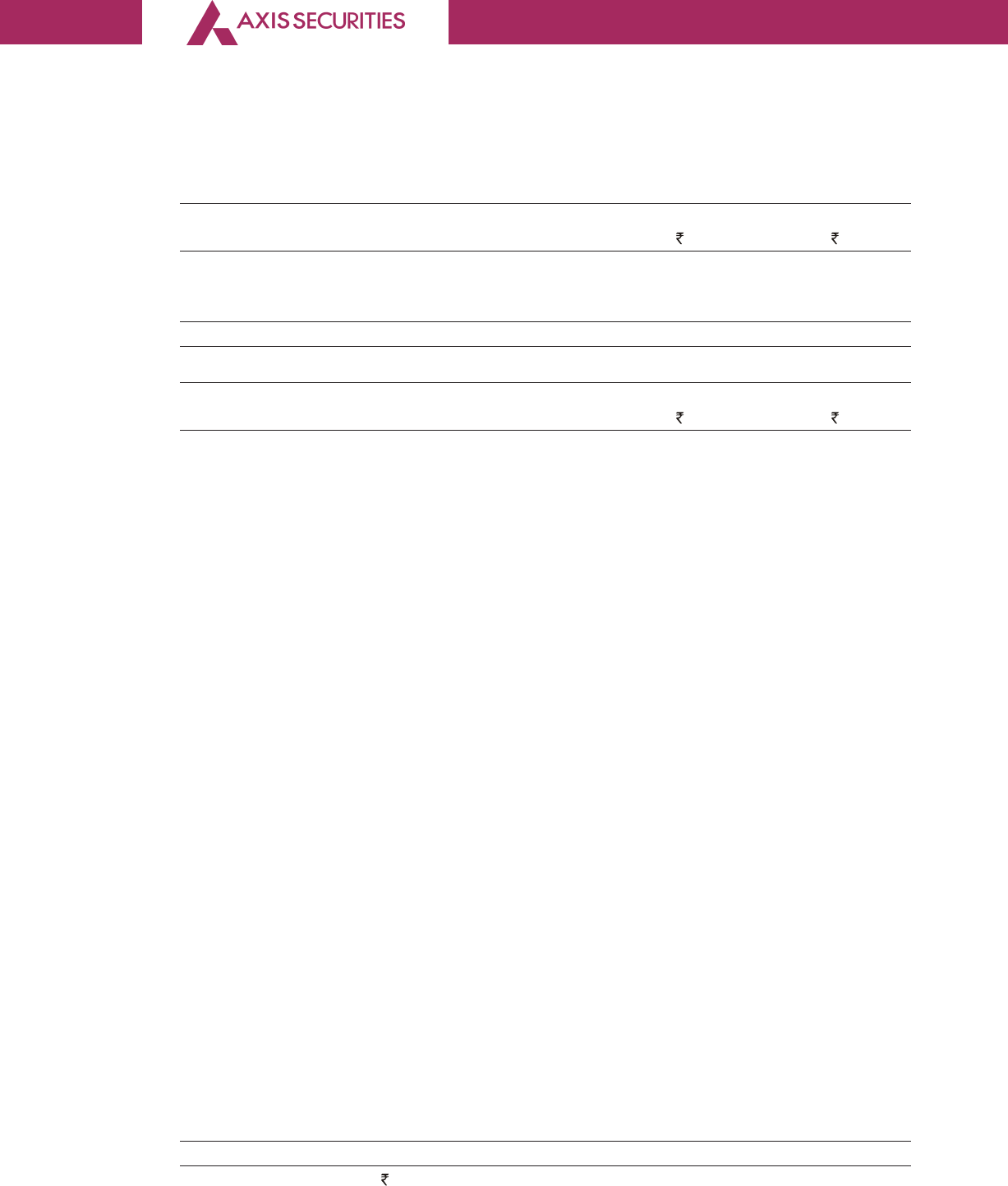
78
A Subsidiary of AXIS BANK
21. Finance Charges
31 March 2020 31 March 2019
( in Lakhs) ( in Lakhs)
Bank guarantee commission 104 82
Interest expense 127 145
Interest paid on lease liabilities 132 –
Total 363 227
22. Other expenses
31 March 2020 31 March 2019
( in Lakhs) ( in Lakhs)
Rent (premises) 10 727
Stamp, registration and exchange charges 2 3
Franking charges 102 132
Advertisement and sales promotion 114 382
Rates and taxes 80 22
Insurance 7 8
Housekeeping expenses 114 130
Security charges 51 73
Repair and maintenance- others 66 66
Travelling and conveyance 208 244
Communication cost 560 517
Call center cost 159 179
Information technology expenses 1,099 1,048
Loss on sale of fixed assets 51 65
Printing & stationery 236 107
Legal and professional fees 248 102
Director’s sitting fees 13 7
Auditors’ remuneration :
- Audit fee 25 17
- Out of pocket expenses – 0*
- Certification 5 –
Expense towards Corporate Social Responsibility (Note 38) 194 90
Electricity and water charges 144 169
Office expenses 26 31
Membership & subscription fees 102 89
Recruitment and training expenses 80 42
Allocated Expenses 1 –
Miscellaneous expenses 47 98
Bad debts 115 61
Provision for bad & doubtful debts 53 63
Sub brokerage – 3
DP- Transaction Charges 228 –
ROC filing fees 75 –
Total 4,215 4,475
* The Amount is less than 50,000
Notes forming part of the financial statements for the year ended 31 March, 2020
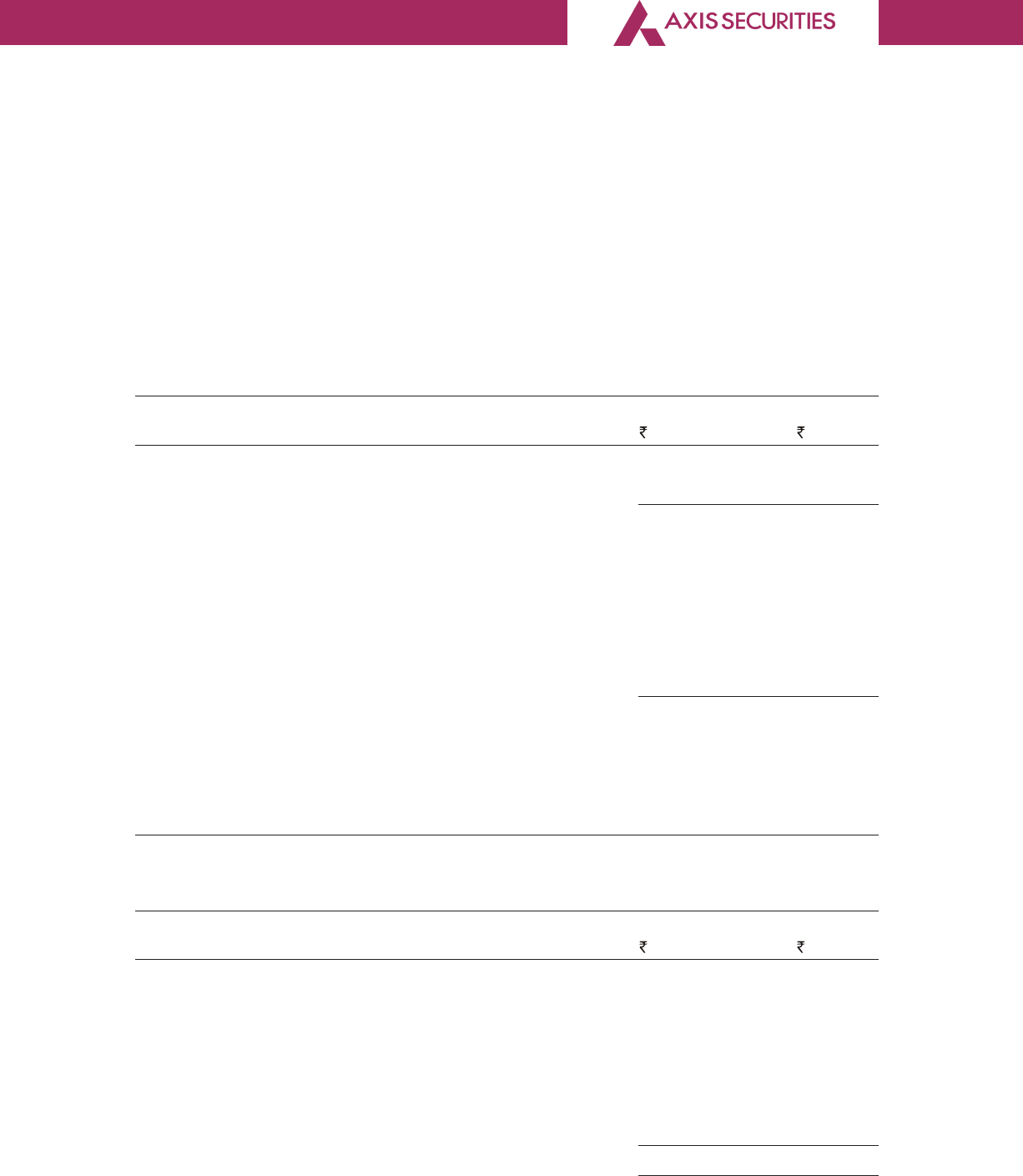
79
A Subsidiary of AXIS BANK
23. Discontinued operations
On 28 March 2019, Both Axis Bank Ltd and Axis Securities Ltd (ASL) have mutually taken decision
to exit Non Broking business pertaining to retail assets, credit cards, resource management
services etc. services offered by ASL to Axis Bank. During the transition of business subject to
terms and conditions compulsorily and expressly accepted by both the parties, the transition
cost incurred by ASL from April 1, 2019 onward till the arrangement is terminated will be billed
to Axis Bank. Being a discontinued operation, that segment is no longer presented in the
segment note.
Profit & Loss Statement of discontinued operations 31 March 2020 31 March 2019
( in Lakhs) ( in Lakhs)
Revenue from operation 2,789 87,882
Other Income 66 407
Total Revenue 2,855 88,289
Expenses
Employee benefit expense 1,410 77,997
Depreciation amortization expense and Impairment 698 312
Finance charges – (9)
Interest paid on lease liabilities 30 –
Other expenses 52 3,296
Total Expense 2,190 81,596
Profit/(loss) before tax from a discontinued operation 665 6,693
Tax (expenses)/income: (183) (2,408)
Deferred Tax – 50
Profit/(loss) for the year from a discontinued operation 482 4,335
The major classes of assets and liabilities of Axis Securities Limited classified as held for distribution
to equity holders as at 31st March 2020 are, as follows:
31 March 2020 31 March 2019
( in Lakhs) ( in Lakhs)
Assets
Property, plant and equipment (Note 10) – 1,143
Intangible assets (Note 10) – 153
Other financial assets – 255
Other current assets – 811
Trade receivable – 8,193
Cash and cash equivalent – 4,949
Assets classified as held for distribution – 15,504
Notes forming part of the financial statements for the year ended 31 March, 2020
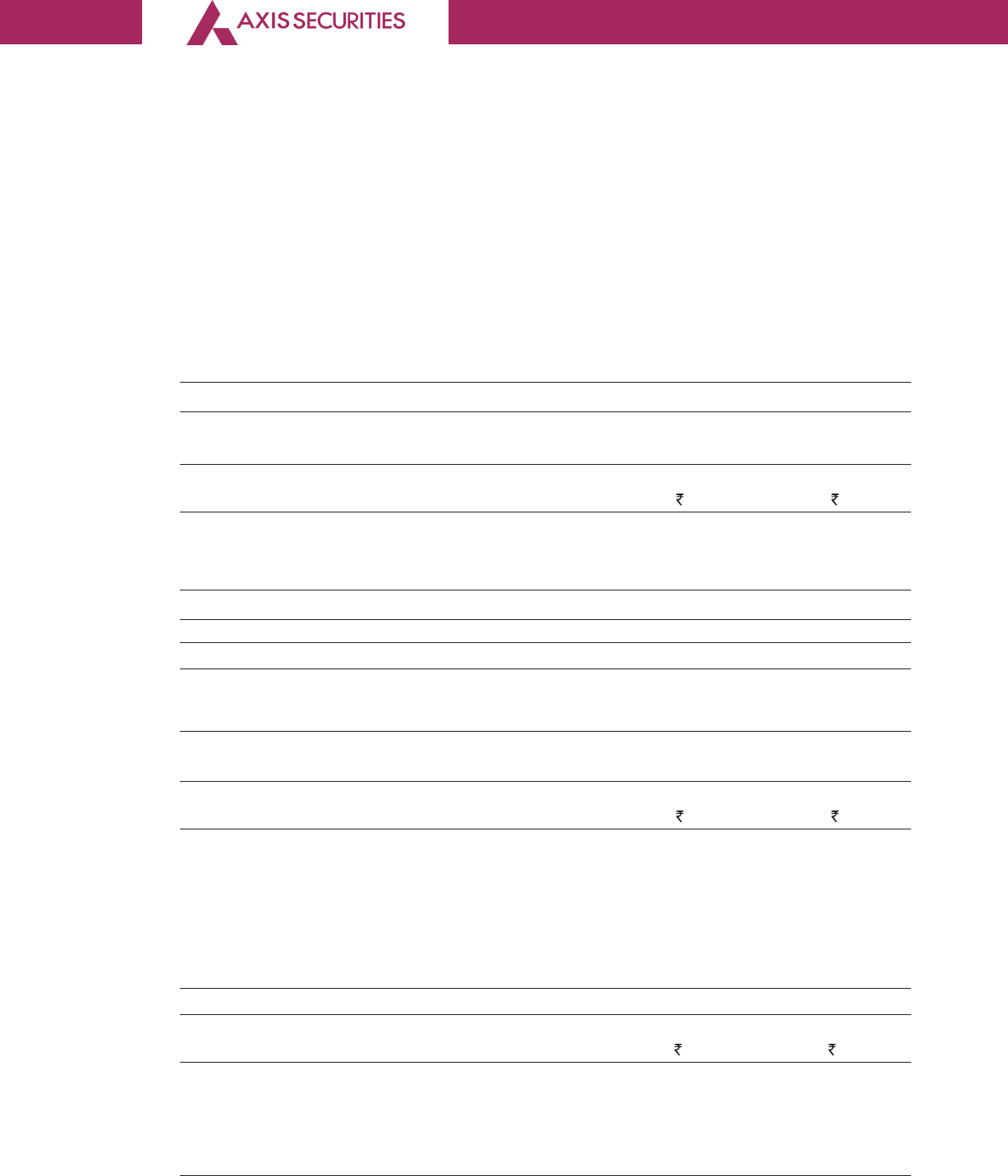
80
A Subsidiary of AXIS BANK
Liabilities
Net employee defined benefit liabillities – 124
Long term provisions – 259
Short term provisions – 2,336
Liabilities for statutory dues – 2,866
Other current liabilities – 5,223
Liabilities directly associated with assets classified – 10,809
as held for distribution
Net assets directly associated with disposal group – 4,695
The net cash flows incurred by discontinuing operations are as follows:
31 March 2020 31 March 2019
( in Lakhs) ( in Lakhs)
Operating 482 (140)
Investing – 1,428
Financing – 10
Net Cash (outflow) inflow 482 1,298
Earning per share: 31 March 2020 31 March 2019
Basic, profit/(loss) for the year from discontinued operation 0.33 3.00
Diluted, profit/(loss) for the year from discontinued operation 0.33 3.00
Earning per share (EPS)
Particulars 31 March 2020 31 March 2019
( in Lakhs) ( in Lakhs)
Profit attributable to equity holders of the parent:
Continuing operations 2,253 3,115
Discontinued operation 482 4,335
Profit attributable to equity holders of the parent for 2,734 7,450
basic earnings
Weighted average number of Equity shares for basic EPS 1,445 1,445
Earning per share: 31 March 2020 31 March 2019
( in Lakhs) ( in Lakhs)
Basic EPS from Continuing operations 1.56 2.16
Diluted EPS from Continuing operations 1.56 2.16
Basic EPS from Discontinued operation 0.33 3.00
Diluted EPS from Discontinued operation 0.33 3.00
Notes forming part of the financial statements for the year ended 31 March, 2020
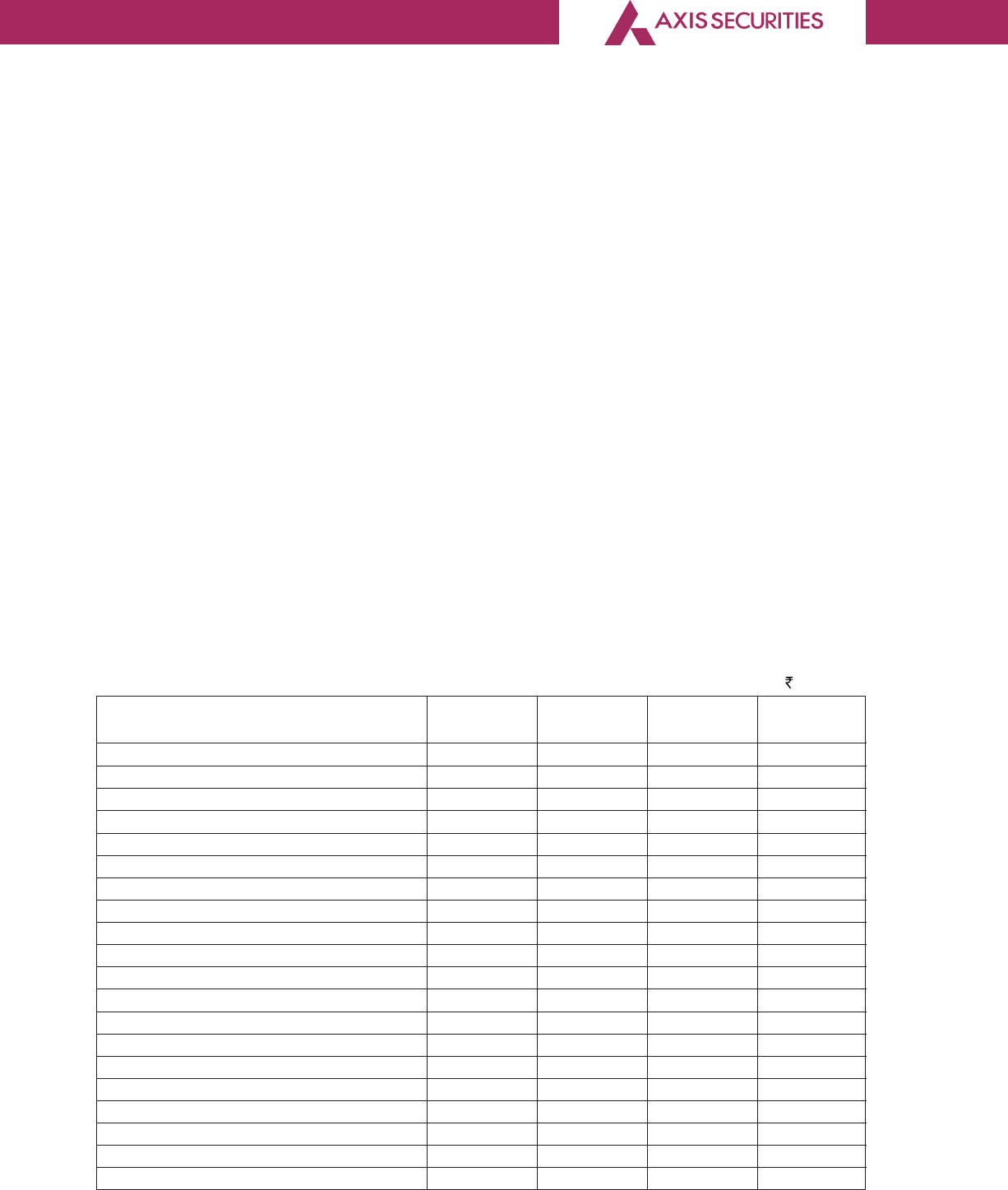
81
A Subsidiary of AXIS BANK
24. Related Party Transaction
Names of related parties where control exists irrespective of whether transactions have
occurred or not.
Holding Company Axis Bank Limited
Key Management Mr. Arun Thukral
Personnel Mr. Anand Shaha
Mr. Hemantkumar Patel (Chief Financial Officer)
Ms. Lovelina Faroz (Company Secretary upto 29.10.19)
Ms. Divya Poojary (Company Secretary from 30.01.20 to till date)
Mr. Gopkumar Bhaskaran (Managing Director & CEO - 01.01.20 till date)
(Additional Director -18.10.19 to 31.12.19)
Fellow Subsidiaries
Axis Private Equity Limited (APEL)
Axis Finance Limited (AFL)
Axis Mutual Fund Trustee Limited (AMFTL)
Axis Trustee Services Limited (ATSL)
Axis Asset Management Company Limited (AAMCL)
Axis Bank U. K. Limited (ABUKL)
Axis Capital Limited (ACL)
A. Treds Limited (ATL)
Freecharge Payment Technologies Private Limited (FPTPL)
(w.e.f. 06 Oct 2017)
Accelyst Solutions Private Limited (ASPL) (w.e.f. 06 Oct 2017)
Axis Capital USA LLC. (w.e.f. 02 Aug 2017)
( in Lakhs)
Transaction/Nature of Holding Key Manage- Fellow Grand Total
Relationship Company ment Personnel Subsidiary
Income
Income
Business sourcing fee income 1,024.92 – – 1,024.92
(45,962.94) – – (45,962.94)
Resource management fee – – – –
(41,912.27) – – (41,912.27)
Commission – – – –
(5.26) – – (5.26)
Interest on fixed deposits 54.74 – – 54.74
(59.54) – – (59.54)
Other income 17.90 – – 17.90
– – – –
Other income (AMTFL) – – 37.67 37.67
– – – –
Resource management fees (AAMC) – – 1.88 1.88
– – (6.71) (6.71)
Bank interest 2.47 – – 2.47
(0.96) – – (0.96)
Other income (AFL) – – 33.24 33.24
– – (47.31) (47.31)
Notes forming part of the financial statements for the year ended 31 March, 2020
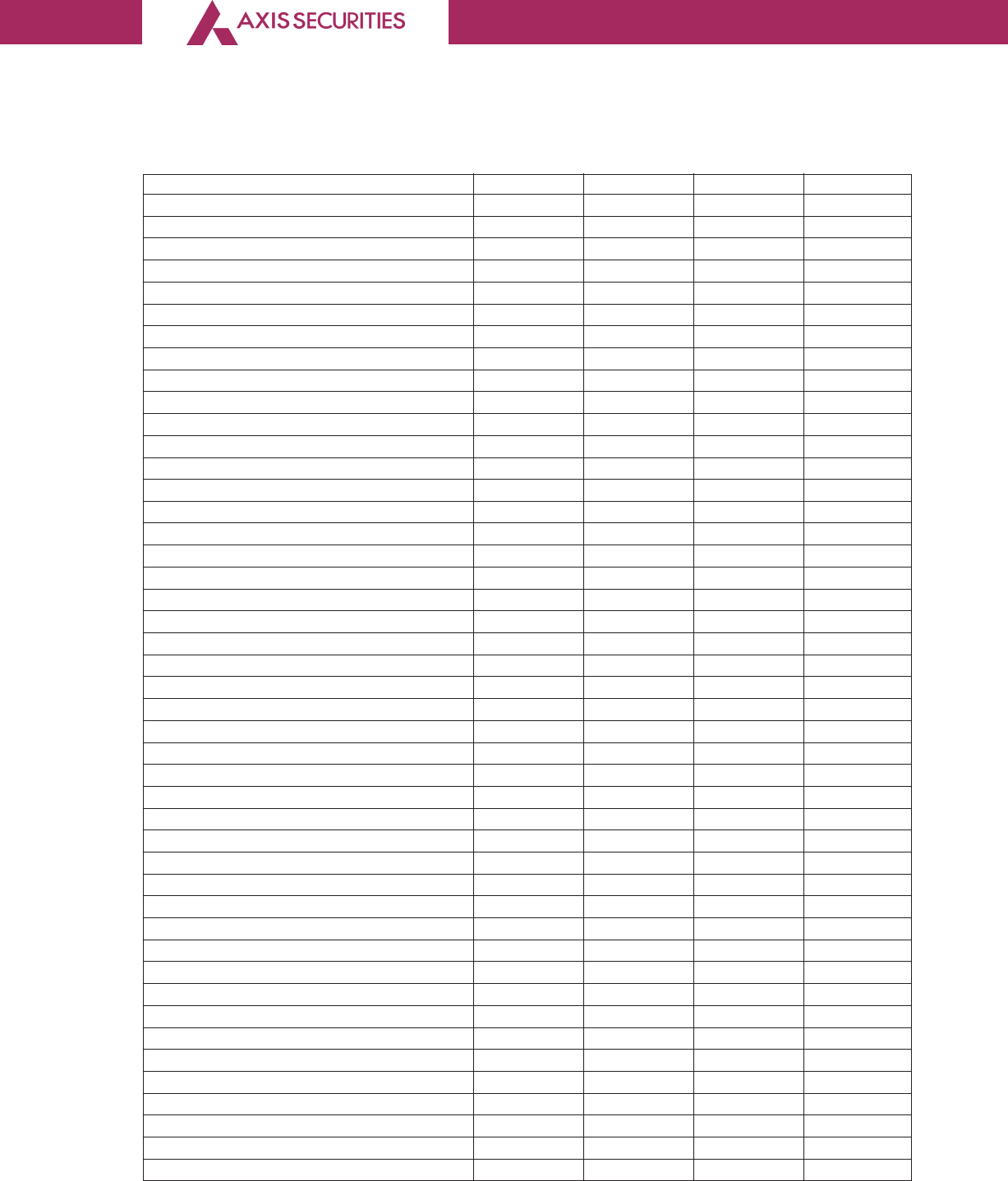
82
A Subsidiary of AXIS BANK
Other income (AAMC) – – – –
– – (182.92) (182.92)
Other income (ACL) – – 11.59 11.59
– – (19.85) (19.85)
Brokerage income (Mr. Arun Thukral) – 0.08 – 0.08
– (0.19) – (0.19)
Brokerage income (Mr. Anand Shaha) – 0.00 – 0.00
– (0.02) – (0.02)
Brokerage income (Mr. Hemantkumar Patel) – 0.01 – 0.01
– (0.02) – (0.02)
Expenses
Salaries (Mr. Gopkumar Bhaskaran) – 122.02 – 122.02
–– – –
Salaries (Mr. Arun Thukral) 142.19 – – 142.19
(185.12) – – (185.12)
Salaries (Mr. Anand Shaha) – 94.25 – 94.25
– (80.15) – (80.15)
Salaries (Mr. Hemantkumar Patel) – 58.66 – 58.66
– (52.53) – (52.53)
Salaries (Ms. Lovelina Faroz) – 9.70 – 9.70
– (14.66) – (14.66)
Salaries (Ms. Divya Poojari) – 3.04 – 3.04
–– – –
Reimbursement for expenses 6,160.18 – – 6,160.18
(645.79) – – (645.79)
Reimbursement for expenses (Mr. Arun Thukral) – 0.50 – 0.50
(1.41) (0.56) – (1.97)
Bank charges & other charges paid 114.45 – – 114.45
(73.43) – – (73.43)
Other expenses/ reimbursements (ACL) – –
– – (1.42) (1.42)
Other transactions
Other reimbursement received (AFL) – – – –
–– – –
Training Exp reimbursement(Cross Sell) – – – –
(12.99) – – (12.99)
Reimbursement of operating expenses – – – –
(2.65) (0.14) – (2.78)
Dividend paid 3,323.50 – – 3,323.50
–– – –
Income
Unamortised DP AMC transferred to ASL 1,873.73 – – 1,873.73
–– – –
Income
Transition Exp reimbursement – – – –
577.51 577.51 – –
Notes forming part of the financial statements for the year ended 31 March, 2020
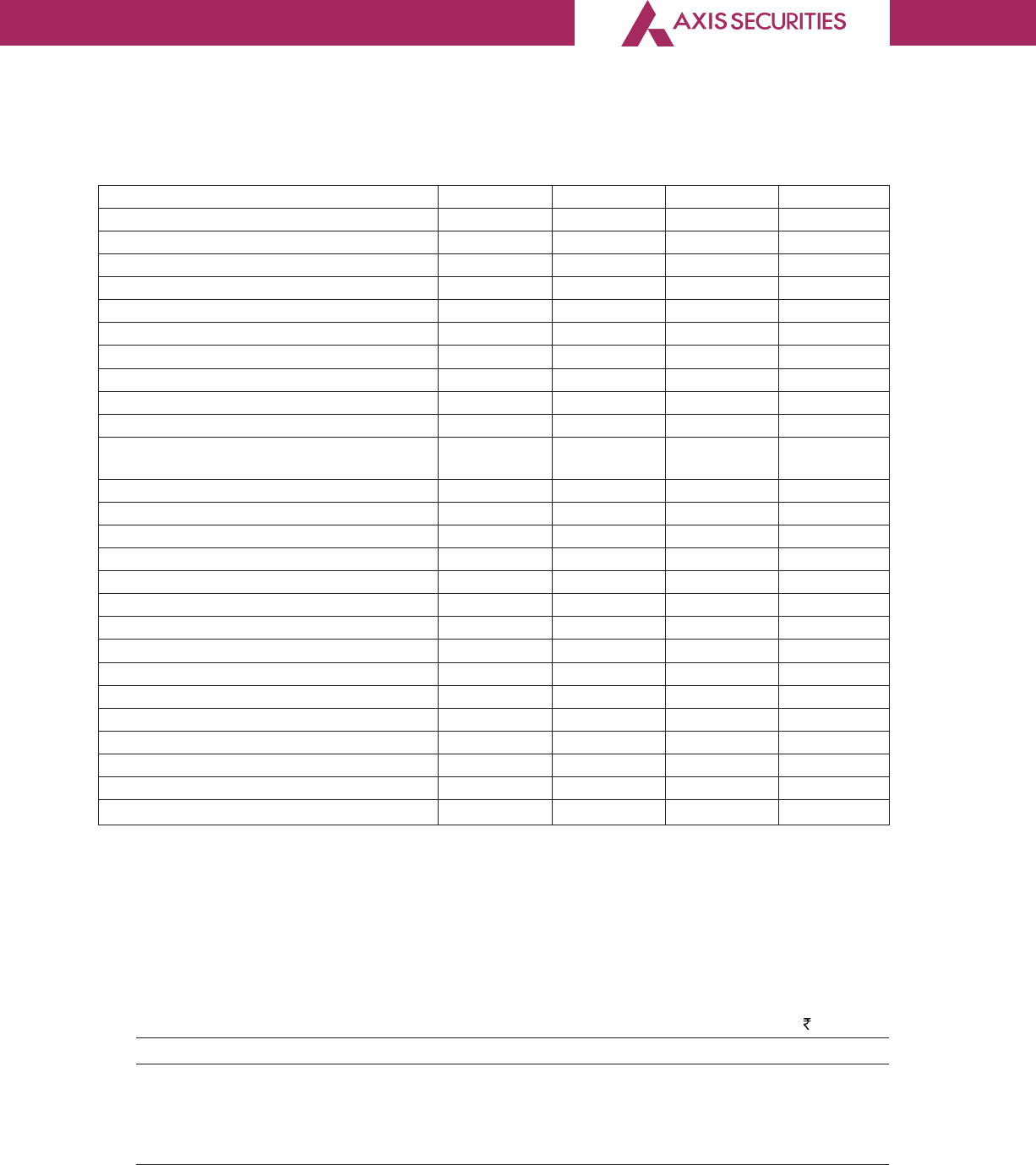
83
A Subsidiary of AXIS BANK
Income
Sale of asset – – – –
3.55 – – 3.55
Outstanding balance as at 31 March 2020
Other payables 164.75 – 54.82 219.57
(163.46) – – (163.46)
Accounts receivable-for services rendered 17.69 – – 17.69
(8,192.44) – – (8,192.44)
Other payables (AFC) – – 484.30 484.30
– – (226.34) (226.34)
Accounts receivable-for services rendered- – – – –
(AAMC)
– – (0.49) (0.49)
Other receivables (AAMC) – – – –
–– – –
Other receivables (ACL) – – 0.11 0.11
–– – –
Other receivables (AFL) – – 0.06 0.06
– – (0.03) (0.03)
Royalty Charges Payable 7.60 – – 7.60
–– – –
Overdraft Bank Balance 9.65 – – 9.65
–– – –
Current account 12,178.65 – – 12,178.65
(6,276.19) – – (6,276.19)
Fixed deposit balance 1,699.08 – – 1,699.08
(5,081.76) – – (5,081.76)
Notes:
1) As the liabilities for gratuity and leave encashment are provided on an actuarial basis for the Company as a
whole, the amount pertaining to the directors are not included above.
2) Figures in bracket represents corresponding amount of previous year.
25. Leases Disclosure under Ind AS 116
Company as a Lessee
Set out below are the carrying amounts of right-of-use assets recognised and the movements
during the period:
( in Lakhs)
ROU assets Total
As at April 1, 2019 1,707 1,707
Addition 401 401
Depreciation (803) (803)
As at March 31, 2020 1,305 1,305
Notes forming part of the financial statements for the year ended 31 March, 2020

84
A Subsidiary of AXIS BANK
Set out below are the carrying amounts of lease liabilities (included under interest-bearing
loans and borrowings) and the movements during the period:
( in Lakhs)
As at Total
March 31, 2020
As at 1st April (2,322) (2,322)
Addition (370) (370)
Accretion of interest (161) (161)
Payments 1,202 1,202
As at March 31, 2020 (1,651) (1,651)
The Maturity analysis of lease liabilities is as under:
( in Lakhs)
Lease liabilities As at
March 31, 2020
Not later than 1 month (37)
Later than 1 month not later than 3 months (74)
Later than 3 month not later than 1 year (354)
Later than 1 year (1,186)
Total (1,651)
The following are the amounts recognised in statement of profit or loss:
( in Lakhs)
Particulars As at
March 31, 2020
Depreciation expense of right-of-use assets 803
Interest expense on lease liabilities 161
Expense relating to short-term leases –
Expense relating to leases of low-value assets –
Variable lease payments –
Total amount recognised in profit or loss 964
Notes forming part of the financial statements for the year ended 31 March, 2020
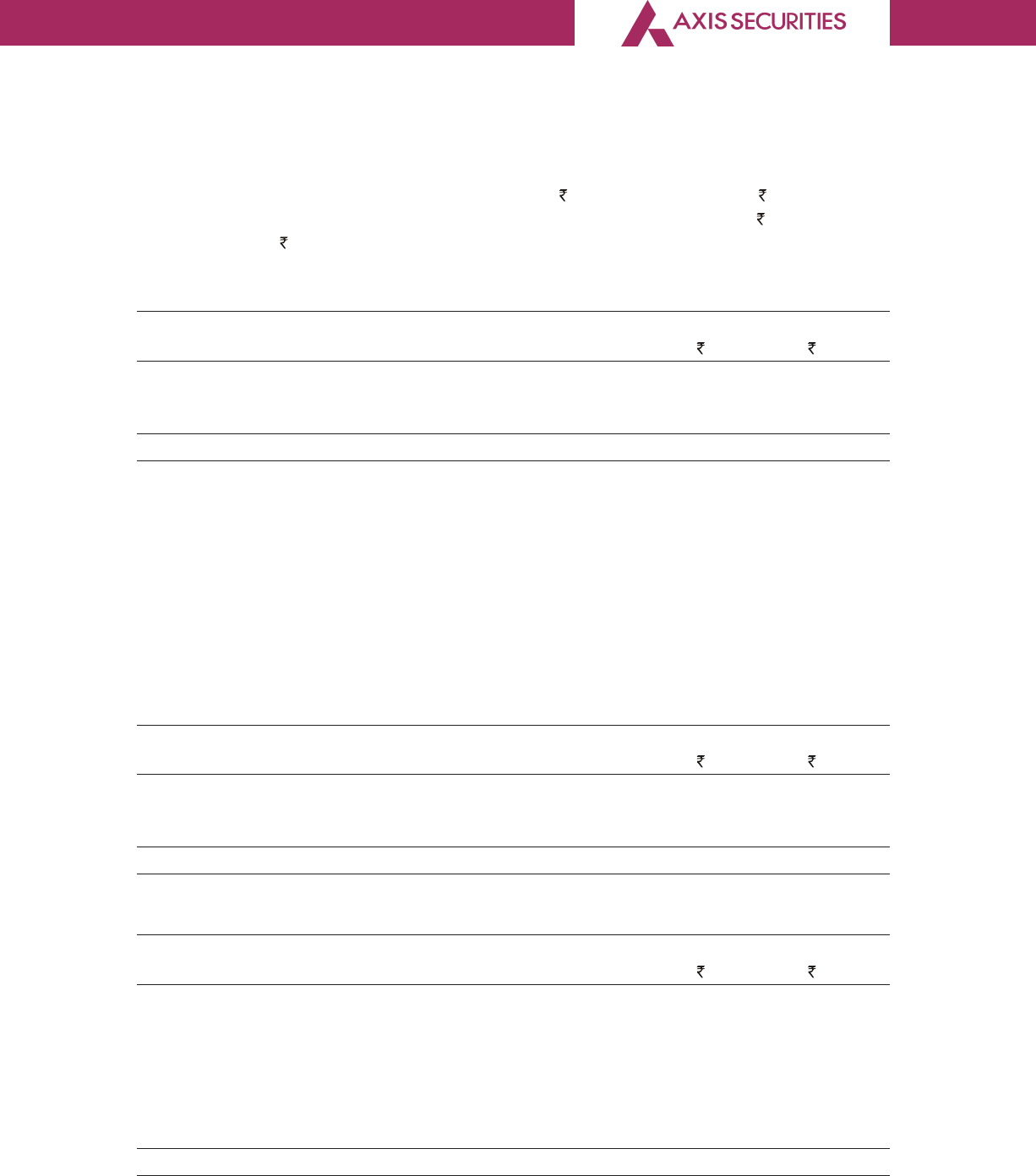
85
A Subsidiary of AXIS BANK
The Company had total cash outflows for leases of 1202 lakhs in FY 19-20 ( 1473 lacs in FY
18-19). The Company also had non-cash additions to right-of-use assets of 401 Lakhs and
lease liabilities of 370 Lakhs in FY19-20.
26. Details of Foreign currency transactions
Expenditure in foreign currency (accrual basis) 2019-20 2018-19
( in Lakhs) ( in Lakhs)
Subscription charges 15 51
Sales Promotion – 25
15 76
27. Gratuity and other benefit plans
The Company has a defined benefit gratuity plan. Every employee who has completed five
years or more of service gets a gratuity on retirement at 15 days salary (last drawn salary) for
each completed year of service. The schemes are funded with insurance companies in the
form of a qualifying insurance policies.
The following tables summarize the components of net benefit expense recognized in the
Statement of profit and loss and the funded status and amounts recognized in the balance
sheet for the respective plans.
Particulars 2019-20 2018-19
( in Lakhs) ( in Lakhs)
In statement of Profit and Loss 207 195
In other comprehensive Income (164) (39)
Total Expenses Recognized for the period 43 157
Net employee benefit expense (recognized in employee cost)
2019-20 2018-19
( in Lakhs) ( in Lakhs)
Current service cost 177 175
Past service cost – –
Administration expenses – –
Interest on net defined benefit liability / (asset) 30 20
(Gains) / losses on settlement – –
Total expense charged to profit and loss account 207 195
Notes forming part of the financial statements for the year ended 31 March, 2020
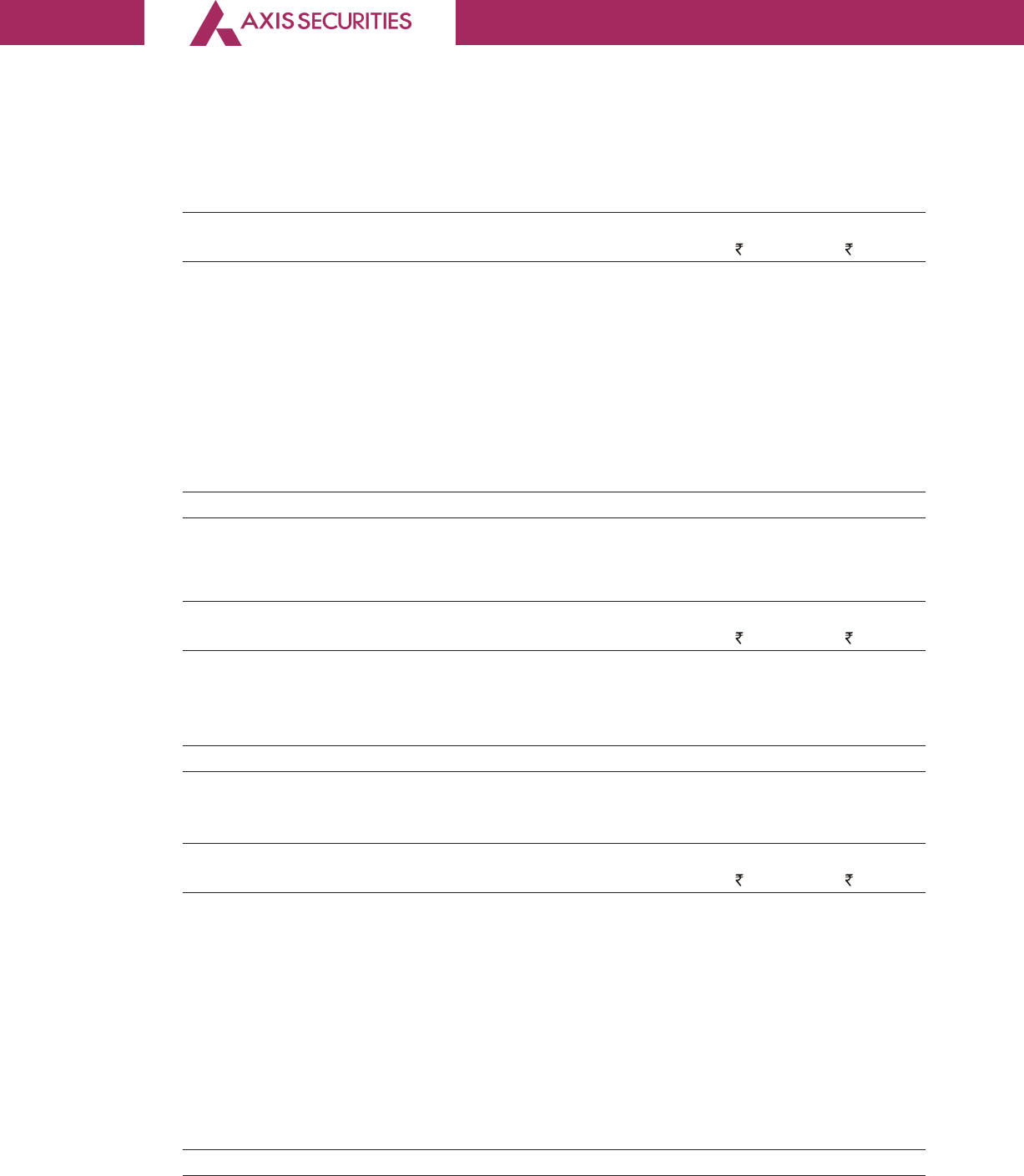
86
A Subsidiary of AXIS BANK
Amount recorded in Other comprehensive income
2019-20 2018-19
( in Lakhs) ( in Lakhs)
Opening amount recognized in OCI outside profit and
loss account 231 269
Remeasurements during the period due to –
Changes in financial assumptions 19 4
Changes in demographic assumptions – 4
Experience adjustments (159) (27)
Actual return on plan assets less interest on plan assets (24) (19)
Adjustment to recognize the effect of asset ceiling – –
Closing amount recognized in OCI outside profit and loss account 67 231
Balance Sheet
Details of provision for gratuity
2019-20 2018-19
( in Lakhs) ( in Lakhs)
Present value of obligation as at the end of the year 347 424
Fair value of plan assets 119 39
Net funded obligation
Net defined benefit liability recognized in balance sheet (228) (385)
Movement in benefit obligation are as follows:
2019-20 2018-19
( in Lakhs) ( in Lakhs)
Opening defined benefit obligation 424 733
Current service cost 177 175
Past Service Cost – –
Interest on defined benefit obligation 42 38
Remeasurements due to:
Actuarial loss / (gain) arising from change in financial assumptions 19 4
Actuarial loss / (gain) arising from change in demographic assumptions – 4
Actuarial loss / (gain) arising on account of experience changes (159) (27)
Benefits paid (156) (502)
Closing defined benefit obligation 347 424
Notes forming part of the financial statements for the year ended 31 March, 2020

87
A Subsidiary of AXIS BANK
Changes in fair value of plan assets are as follows :
2019-20 2018-19
( in Lakhs) ( in Lakhs)
Opening fair value of plan assets 39 355
Employer contributions 200 150
Interest on plan assets 12 18
Administration expenses – –
Remeasurements due to: –
Actual return on plan assets less interest on plan assets 24 19
Benefits paid (156) (502)
Closing fair value of plan assets 119 39
The Company expects to contribute 15,000,000 to gratuity in the next year.
The major categories of plan assets as a percentage of the fair value of total plan assets are
as follows:
For the year For the year
ended ended
31 March 2020 31 March 2019
Investment with insurer 100% 100%
DISGGREGATION OF PLAN ASSETS
A split of plans asset between various asset classes as well as segregation between quoted
and unqoted values is presented below:
Period Ended
31 Mar 2020
( in Lakhs)
Quoted Non–Quoted Total
Property – – –
Government debt instrument – – –
Other debt instruments – – –
Entity’s own equity instrument – – –
Insurer managed funds – 119 119
Other – – –
The overall expected rate of return on assets is determined based on the market prices
prevailing on that date, applicable to the period over which the obligation is to be settled.
Notes forming part of the financial statements for the year ended 31 March, 2020
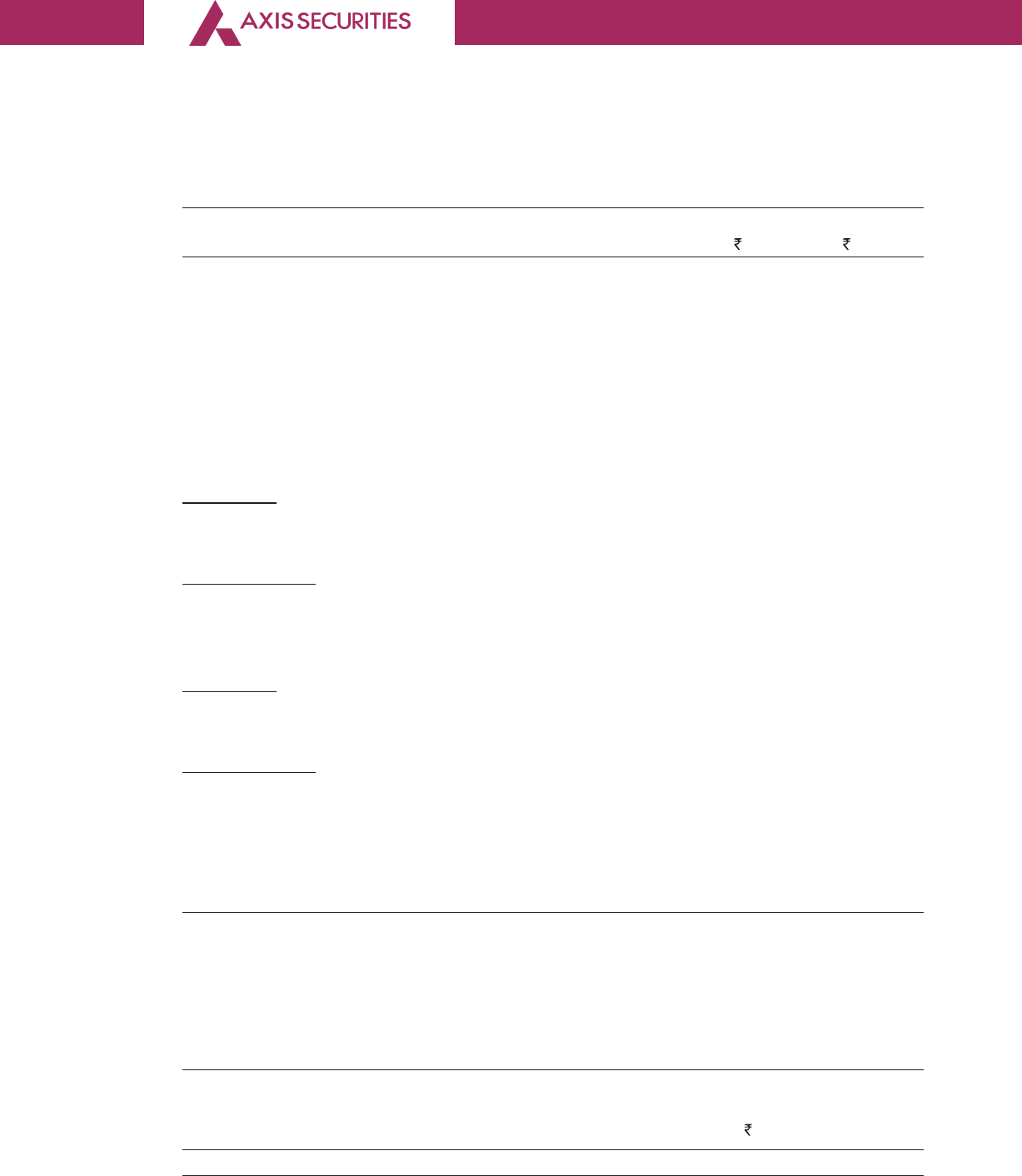
88
A Subsidiary of AXIS BANK
The principal assumptions used in determining gratuity obligations are shown below:
2019-20 2018-19
( in Lakhs) ( in Lakhs)
Discount rate
Broking 6.30% 7.00%
Non-broking (discontinuing operations) – 6.55%
Expected rate of return on assets
Broking 7.25% 7.50%
Non-broking (discontinuing operations) – 6.55%
Employee turnover
For Broking
Managerial
Age : 21-44 years 20.00% 20.00%
Age : 45-59 years 1.00% 1.00%
Non-Managerial
Age : 21-44 years 60.39% 60.39%
Age : 45-59 years 1.00% 1.00%
For Non Broking (discontinuing operations)
Managerial
Age : 21-44 years – 35.00%
Age : 45-59 years – 1.00%
Non-Managerial
Age : 21-44 years – 89.76%
Age : 45-59 years – 1.00%
Salary escalation rate
Broking 7.75% 7.64%
Non-broking (discontinuing operations) – 6.82%
The estimates of future salary increases considered in actuarial valuation, take account of
inflation, seniority, promotion and other relevant factors, such as supply and demand in the
employment market.
Estimated provision for defined benefit obligation for Key Managerial Persons is shown as below:
Key Managerial Person Gratuity
FY 19-20 FY 18-19
DBO (In lakhs )
Post-employment benefit 15.98 10.20
Notes forming part of the financial statements for the year ended 31 March, 2020
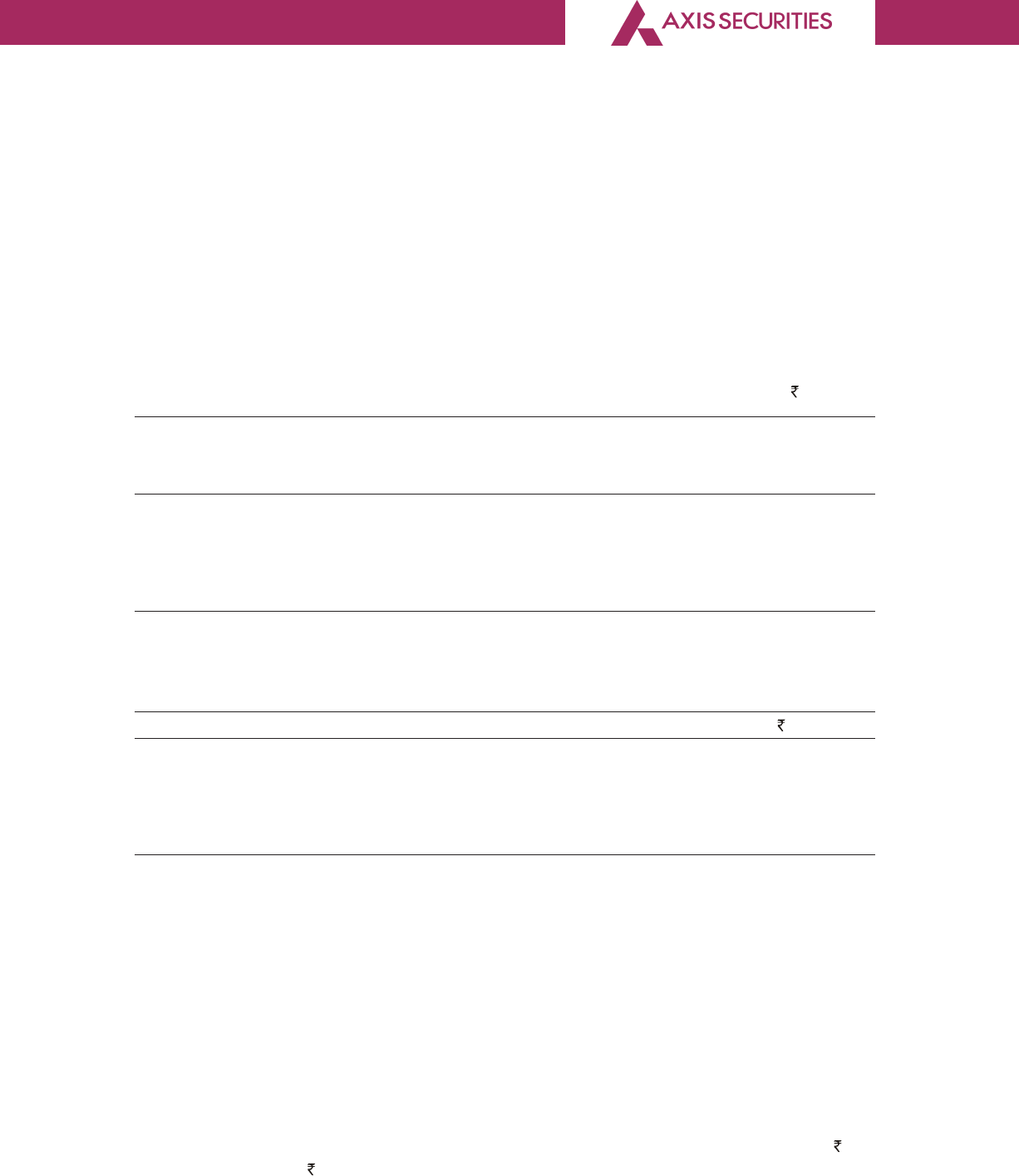
89
A Subsidiary of AXIS BANK
SENSITIVITY ANALYSIS:
Gratuity is a lump sum plan and the cost of providing these benefits is typically less sensitive to
small changes in demographic assumptions. The key actuarial assumptions to which the benefit
obligation results are particularly sensitive to are discount rate and future salary escalation
rate. The following table summarizes the change in defined benefit obligation and impact in
percentage terms compared with the reported defined benefit obligation at the end of the
reporting period arising on account of an increase or decrease in the reported assumption by
50 basis points
( in Lakhs)
Period Ended
31-Mar-20
Discount Rate Salary Escalation
Defined benefit obligation on increase in 50 bps 335 359
Impact of increase in 50 bps on DBO -3.43% 3.50%
Defined benefit obligation on decrease in 50 bps 360 335
Impact of decrease in 50 bps on DBO 3.69% -3.39%
Maturity Profile of Defined Benefit Obligation
Weighted average duration (based on discounted cashflows) is 8.18 years
Expected cash flows over the next (valued on undiscounted basis): ( in Lakhs)
1 years 95
2 to 5 years 111
6 to 9 years 61
10 years and above 344
28. INCOME TAX
The Company offsets tax assets and liabilities if an only if it has legally enforceable right to set
off current taxes assets and current taxed liabilities and the deferred tax assets and deferred
tax liabilities relate to income taxes levied by the same tax authority
Deferred Tax :
Ind AS 12 requires entities to account for deferred taxes using the balance sheet approach,
which focuses on temporary differences between the carrying amount of an asset or liability
in the balance sheet and its tax base. The application of Ind AS 12 approach has resulted in
recognition of deferred tax on new temporary differences which was not required under Indian
GAAP. The company has recognized DTA in books as per Indian GAAP to the extent of 364
lakhs (Previous year : 573.71 Lakhs)
Notes forming part of the financial statements for the year ended 31 March, 2020
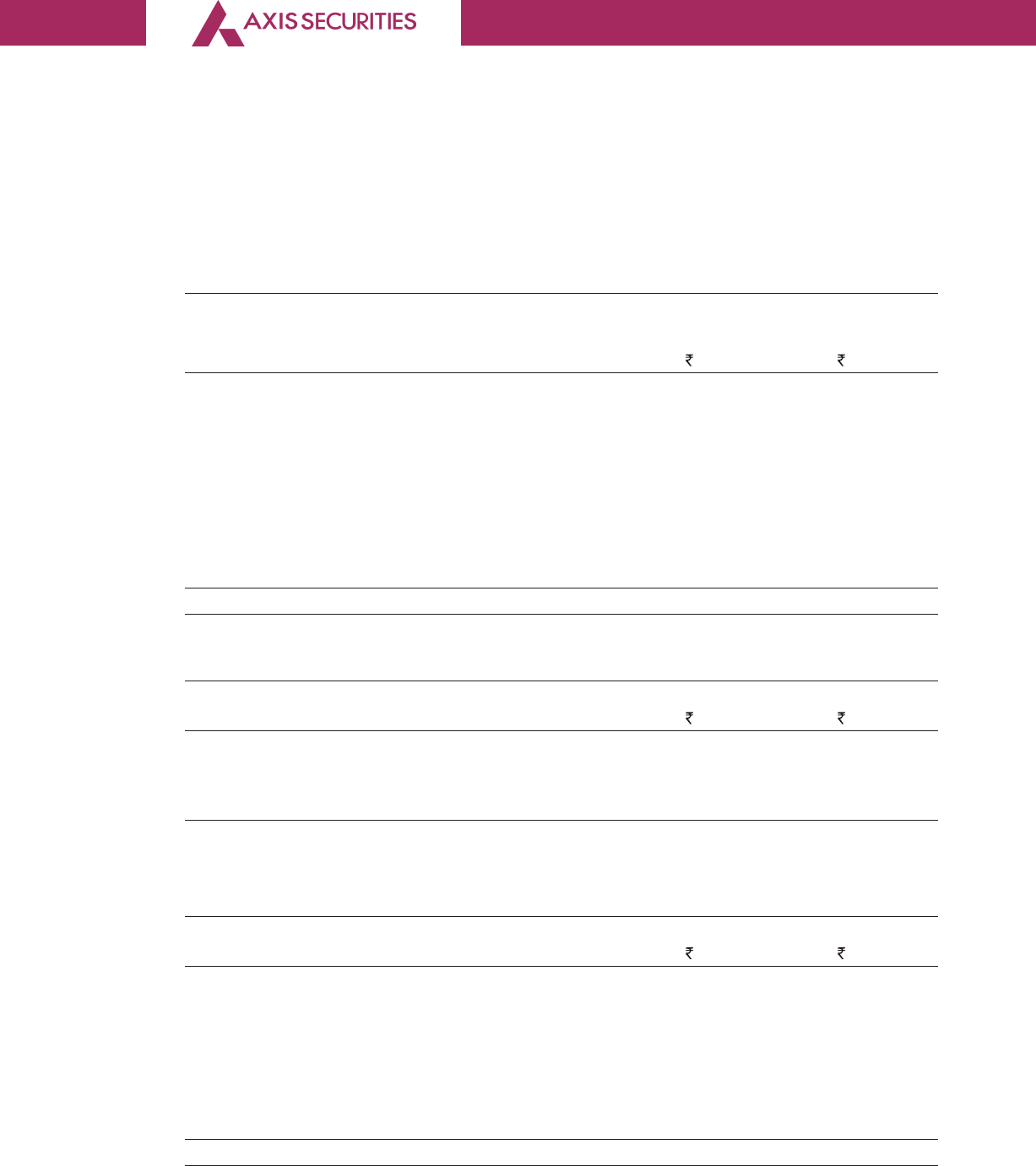
90
A Subsidiary of AXIS BANK
In addition, the various transitional adjustments lead to temporary differences. According to
the accounting policies, the Company has to account for such differences. Deferred tax
adjustments are recognized in correlation to the underlying transaction either in retained
earnings or a separate component of equity.
Deferred Tax Calculation Balance Sheet
31 March 20 31 March 19
( in Lakhs) ( in Lakhs)
Deferred tax Assets
Compensated absence cost – 48
Rent- Lease equalisation 190 135
Provision for doubtful debts 78 89
Retirement benefits 58 135
Advance Subscription Income – 630
Depreciation 178 167
Net deferred tax assets/(liabilities) 504 1,204
Reflected in the balance sheet as follows:
31 March 20 31 March 19
( in Lakhs) ( in Lakhs)
Deferred tax assets 504 1,204
Deferred tax liabilities – –
Deferred tax Assets/(liabilities), net 504 1,204
29. Estimated amount of contracts remaining to be executed on capital account and not provided
for:
31 March 20 31 March 19
( in Lakhs) ( in Lakhs)
Commitment for addition/acquisition of
broking software 154 233
Commitment for office equipment / furniture 4 20
Commitment for computer / servers 137 189
Commitment for leasehold improvement and other
capital assets 38 41
Total 333 483
Notes forming part of the financial statements for the year ended 31 March, 2020
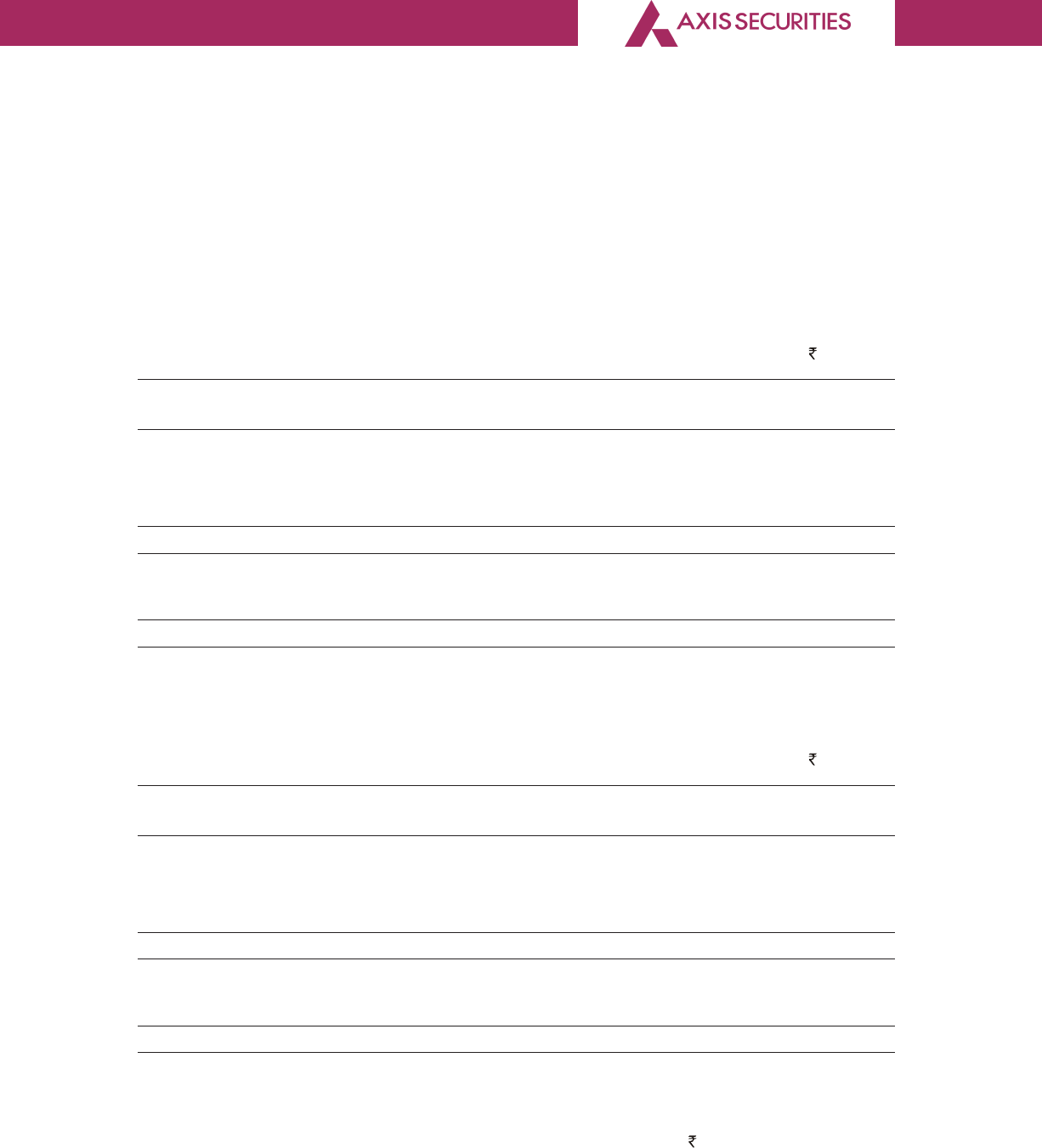
91
A Subsidiary of AXIS BANK
30. Expected credit loss
The company has adopted simplified method for ECL provision on receivables. The provision
is made in following manner:-
Receivable outstanding for more than 90 days, 50% of the amount is provided. A further 50%
is provided for if the outstanding is for more than 180 days.
( in Lakhs)
Trade receivable 0-90 90-180 More than Total
days past due days days 180 days
ECL rate 0% 50% 100%
31-Mar-20 Other Trade Receivable 733 74 189 996
ECL- simplifiedapproach – (38) (189) (228)
Net Amount 733 35 – 768
31-Mar-19 Other Trade Receivable 342 91 187 620
ECL- simplifiedapproach – (45) (187) (233)
Net Amount 342 45 – 388
The Company assesses allowance for expected credit losses for loans. The ECL allowance is
assessed based on the 12 months’ expected credit loss. ECL is calculated on collective basis
for loans. The Company has not experienced any loss on its loan portfolio historically.
( in Lakhs)
Trade receivable 0-90 90-180 More than Total
days past due days days 180 days
ECL rate 0% 50% 100%
31-Mar-20 Loans 4,321 – – 4,321
ECL (22) – – (22)
Net Amount 4,299 – – 4,299
31-Mar-19 Loans 10,262 – – 10,262
ECL – – – –
Net Amount 10,262 – – 10,262
31. At the beginning of the year there was no amount payable to any Micro, Small and/or Medium
Enterprises as defined under Micro, Small and Medium Enterprise Development Act, 2006. The
outstanding balance as on 31 March 2020 and 31 March 2019 are Nil.
The Company also has not received any claims against interest outstanding amount due to
any vendor registered under Micro, Small and Medium Enterprises Development Act, 2006.
Notes forming part of the financial statements for the year ended 31 March, 2020
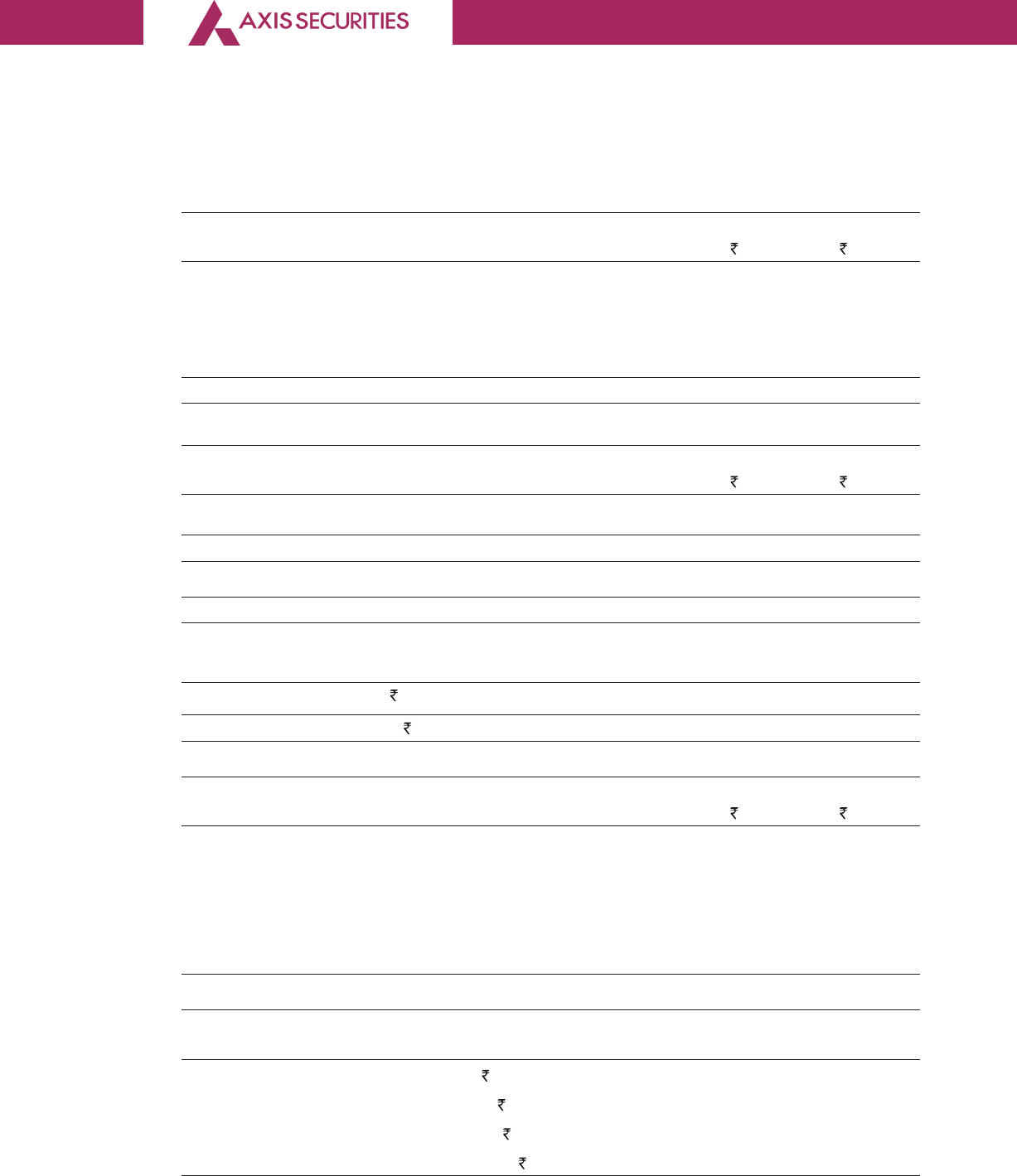
92
A Subsidiary of AXIS BANK
32. Outstanding bank guarantee issued on behalf of the Company:
2019-20 2018-19
( in Lakhs) ( in Lakhs)
ICICI Bank 10,000 10,000
Bank of Baroda – 5,500
HDFC Bank Ltd 5,000 –
IndusInd Bank 1,473 1,840
Total 16,473 17,340
33. Earnings per share (‘EPS’)
2019-20 2018-19
( in Lakhs) ( in Lakhs)
Profit / (loss) after tax 2,734 7,451
Net profit / (loss) for calculation of basic and diluted EPS 2,734 7,451
No. No.
Weighted average number of equity shares in calculating
basic and diluted EPS 14,45,00,000 14,45,00,000
Basic earnings per share ( ) 1.89 5.16
Diluted earnings per share ( ) 1.89 5.16
Particulars 2019-20 2018-19
( in Lakhs) ( in Lakhs)
Profit attributable to equity holders of the parent:
Continuing operations 2,252 3,116
Discontinued operation 482 4,335
Profit attributable to equity holders of the parent for basic earnings 2,734 7,451
Weighted average number of Equity shares for basic EPS* 1,445 1,445
Earnings per share: 31 March 31 March
2020 2019
Basic EPS from continuing operation ( ) 1.56 2.16
Diluted EPS from continuing operation ( ) 1.56 2.16
Basic EPS from discontinuing operation ( ) 0.33 3.00
Diluted EPS from discontinuing operation ( ) 0.33 3.00
Notes forming part of the financial statements for the year ended 31 March, 2020
Equity shares and derivative transactions pertains to error trades.
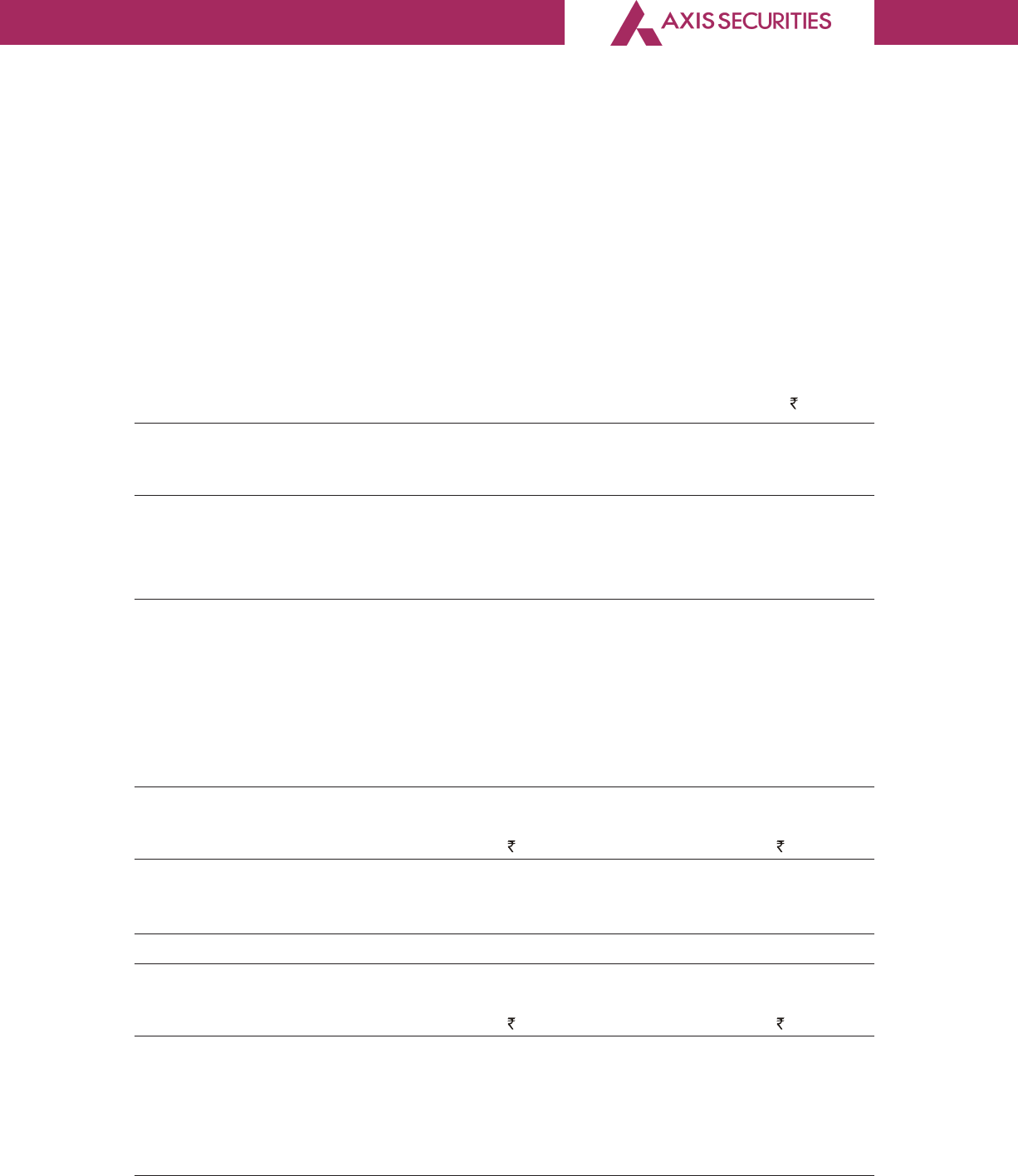
93
A Subsidiary of AXIS BANK
34. Contingent liability :
A contingent liability is a possible obligation that arises from past events whose existence will
be confirmed by the occurrence or non-occurrence of one or more uncertain future events
beyond the control of the Company or a present obligation that is not recognized because it
is not probable that an outflow of resources will be required to settle the obligation. A
contingent liability also arises in extremely rare cases where there is a liability that cannot be
recognized because it cannot be measured reliably. The Company does not recognize a
contingent liability but discloses its existence in the financial statements.
Claims against the Company not acknowledged as debt. ( in Lakhs)
Nature of statute Description Forum where As on 31 As on 31
dispute is March 2020 March 2019
pending
Stamp Act Penalty on MP High – 18
Stamp Duty Court
Income Tax Penalty ITAT – 5
Income Tax Income Tax CIT (A) 280 280
Note:
The Company is contesting the demands and the management believes that its position will
likely be upheld in the appellate process. No provision has been accrued in the financial
statements for the demand raised. The management believes that the ultimate outcome of
this proceeding will not have a material adverse effect on the Company’s financial position
and results of operations.
35. (a) Financial assets at FVTPL
Category Opening Stock Closing Stock
Quantity Value Quantity Value
( in Lakhs) ( in Lakhs)
Equity shares Nil Nil Nil Nil
Derivatives Nil Nil Nil Nil
Mutual funds Nil Nil Nil Nil
Category Opening Stock Closing Stock
Quantity Value Quantity Value
( in Lakhs) ( in Lakhs)
Equity shares 26,204 71 26,204 71
(18,335) (55) (18,335) (55)
Derivatives 1,82,594 788 1,82,594 789
(6,290) (110) (6,290) (110)
Mutual funds 37,81,969 79,530 37,81,969 79,716
(67,14,797) (1,34,679) (67,82,342) (1,36,154)
Equity shares and derivative transactions pertains to error trades.
Notes forming part of the financial statements for the year ended 31 March, 2020
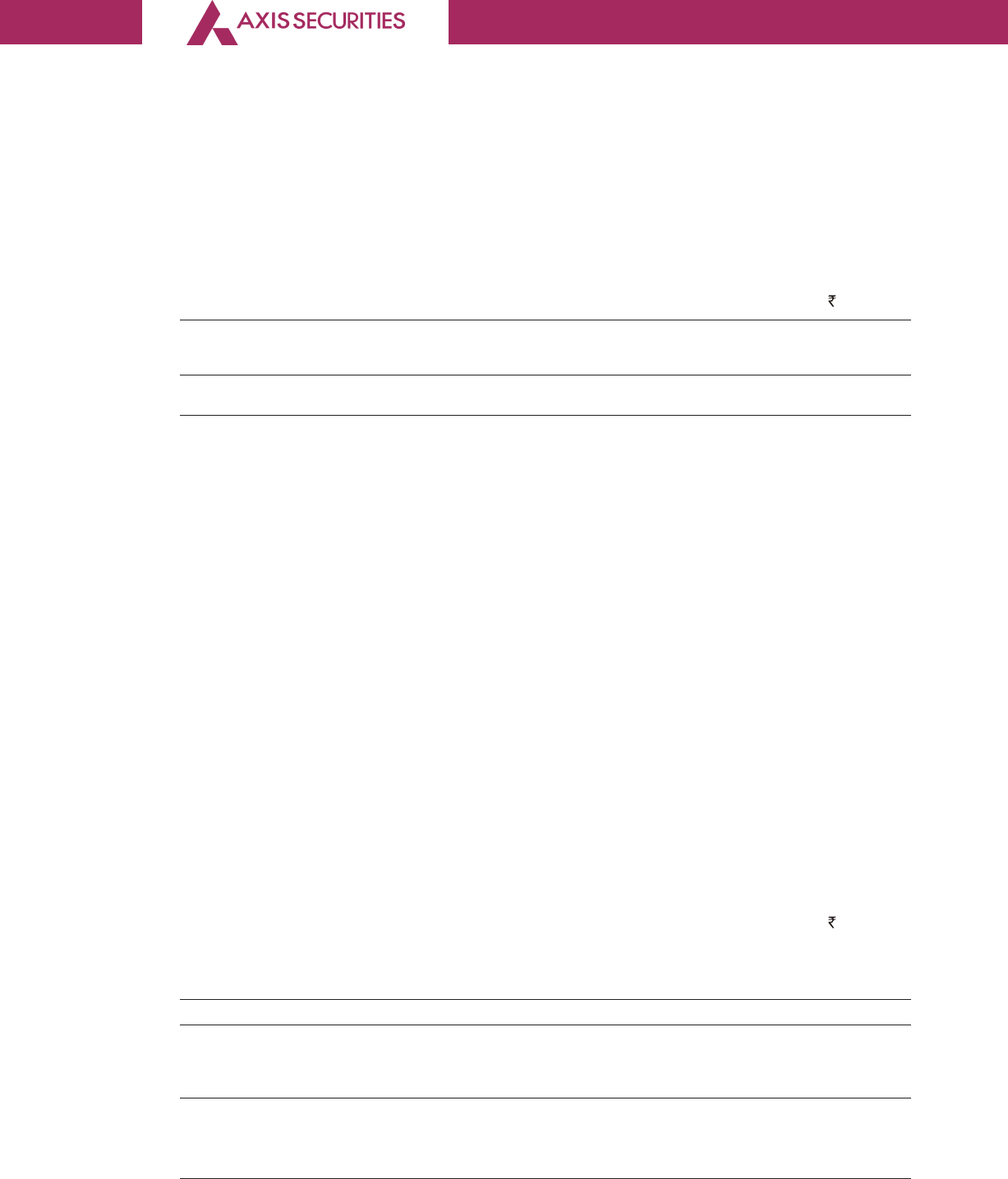
94
A Subsidiary of AXIS BANK
36 FAIR VALUES
Set out below is a comparison by class of the carrying amount and fair value of the Company’s
financial instruments other than those with carrying amounts that are reasonable
approximations of fair value:
( in Lakhs)
Financial Assets Carrying Value Fair Value
31 March 20 31 March 19 31 March 20 31 March 19
Security Deposits 269 587 199 455
The fair value of the financial assets and liabilities is included at the amount at which the
instrument could be exchanged in a current transaction between willing parties, other than in
a forced or liquidation sale. The following methods and assumptions were used to estimate
the fair value:
a) Long-term fixed-rate and variable-rate receivables/borrowings are evaluated by the
Company based on the parameters such as interest rates.
b) Fair value of the Deposits & Advances is measured using the DCF (discounting cash
flow) model.
The fair value measurement of the financial liability of the Company being Commercial papers
is done by transaction cost incurred in initial recognition is included in the initial recognition
amount of the financial liability and charged to profit or loss using effective interest method.
The own non-performance risk as at 31st March 2020 is assessed to be insignificant.
The management assessed that cash and cash equivalents, trade receivables, margin with
exchanges, trade payables, bank balances and other current liabilities approximate their
carrying amount largely due to the short-term maturities of these instruments.
FAIR VALUE HIERARCHY
Following table provides the fair value measurement hierarchy of the Company’s assets and
liabilities as on 31st March 2020 & 31st March 2019.
( in Lakhs)
The following table provides the fair value measurement hierarchy of the Company’s Assets
Quantitative disclosures fair value measurement hierarchy for assets as at 31st March 2020
Fair value measurement using
Date of Total Quoted prices Significant Significant
Valuation in active Observable unobservable
markets inputs inputs
Assets measured
at Fair Value
Security Deposits 31.03.2020 199 – – 199
Notes forming part of the financial statements for the year ended 31 March, 2020
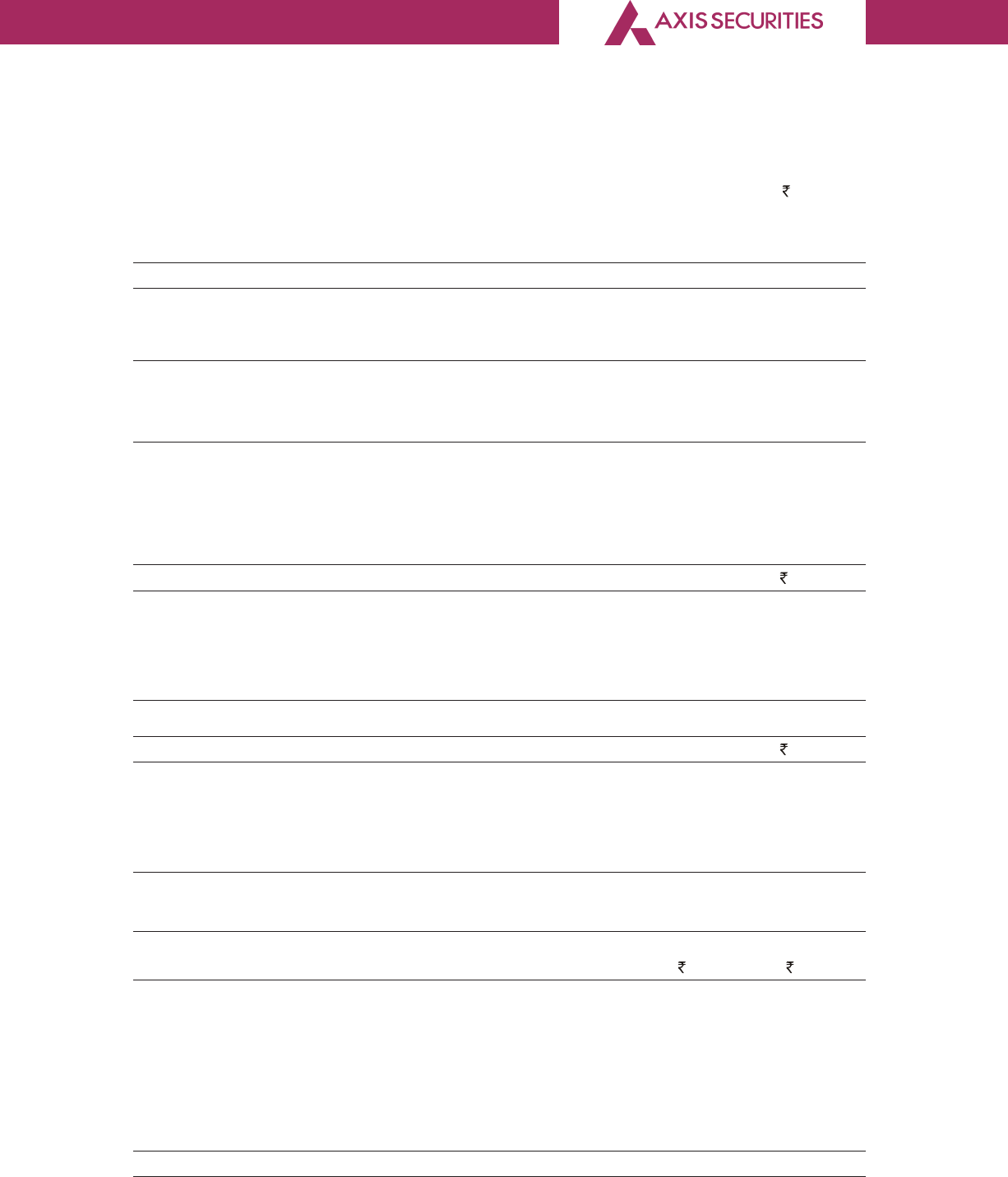
95
A Subsidiary of AXIS BANK
( in Lakhs)
The following table provides the fair value measurement hierarchy of the Company’s Assets
Quantitative disclosures fair value measurement hierarchy for assets as at 31st March 2019
Fair value measurement using
Date of Total Quoted prices Significant Significant
Valuation in active Observable unobservable
markets inputs inputs
Assets measured
at Fair Value
Security Deposits 31.03.2019 455 – – 455
Assets and liabilities by fair value hierarcy
The following table shows an analysis of financial instruments recorded at fair value by level of
the fair value hierarcy:
31 March 2020 ( in Lakhs)
Level 1 Level 2 Level 3 Total
Assets measured at fair value
on a recurring basis
Security Deposits – – 199 199
31 March 2019 ( in Lakhs)
Level 1 Level 2 Level 3 Total
Assets measured at fair value
on a recurring basis
Security Deposits – – 455 455
37. FINANCE COST
Particulars 31 March 20 31 March 19
( in Lakhs) ( in Lakhs)
Interest on ODBD 87 47
Interest on ODFD 26 25
Interest - Others 14 10
Interest on CP – 64
Interest paid on lease liabilities 132 –
BG Commission 104 82
363 227
Notes forming part of the financial statements for the year ended 31 March, 2020

96
A Subsidiary of AXIS BANK
38 CSR expenditure
31 March 20 31 March 19
( in Lakhs) ( in Lakhs)
Gross amount required to be spent by the company
during the year 194 151
194 151
(a Amount spent during the year In cash Yet to be Total
ending on March 31, 2020: paid in cash
( in Lakhs) ( in Lakhs) ( in Lakhs)
i) Construction/acquisition of any asset – – –
ii) On purposes other than (i) above 194 – 194
(b Amount spent during the year In cash Yet to be Total
ending on March 31, 2019: paid in cash
( in Lakhs) ( in Lakhs) ( in Lakhs)
i) Construction/acquisition of any asset – – –
ii) On purposes other than (i) above 151 – 151
39A Reconciliation of equity and profit reported in accordance with previous Indian GAAP and
Ind AS to explain how the transition from the previous Indian GAAP to Ind AS effected is provided
below:-
Reconciliation of Total equity ( in Lakhs)
31 March 20 31 March 19
( in Lakhs) ( in Lakhs)
Total equity as per Indian GAAP – 34,168
Adjustments
Amortization of Subscription income – (1,801)
Tax effects of adjustment – 629
Total adjustments – (1,172)
Total equity as per Ind AS – 32,997
Notes forming part of the financial statements for the year ended 31 March, 2020
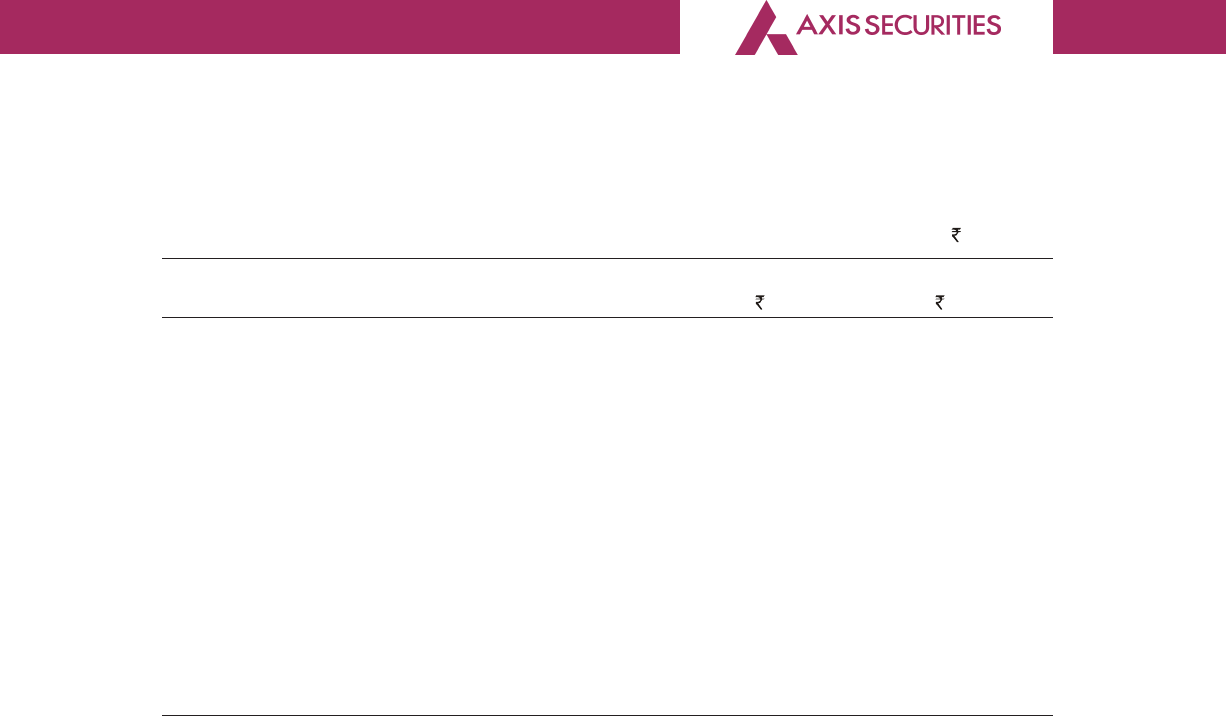
97
A Subsidiary of AXIS BANK
Net Profit Reconciliation is as under ( in Lakhs)
31 March 20 31 March 19
( in Lakhs) ( in Lakhs)
Net profit after tax reported under Indian GAAP – 7,747
Adjustments
Amortization of Subscription income – (468)
Adjustment due to fair valuation of employee stock options – (155)
Actuarial gain/loss on valuation of gratuity – (39)
Tax effects of adjustment – 177
Total adjustments – (485)
Net profit after tax as per Ind AS – 7,262
Other comprehensive income, net of tax – 189
Total comprehensive income – 7,451
Footnotes to the reconciliation of equity and profit or loss
a. FVTPL Financial assets
Under Indian GAAP, the company accounted for short term investment in quoted liquid
mutual funds as investment measured at cost less provision for other than temperory
diminution in the value of investment. Under Ind AS, the company has designated such
investment as FVTPL investment. Ind AS requires FVTPL investment to be measured at fair
value. As at the date of transition to Ind AS, there is no such investment in the balance
sheet.
b. Trade receivable
Under Indian GAAP, the company has created provision for impairment of receivables.
Under Ind AS, the Company has adopted simplied method for computation of Expected
Loss Model (ECL).The simplified approach is similar to model used under Indian GAAP.
Hence there has been no impact on account of application of ECL model under Ind AS
c. Reclassification of subscription income
Under Indian GAAP, the subscription income was amortised over the period of the plan.
Under Ind AS, the subscription income is recognised on the basis of utilisation of turnover
provided under the plan.Consequently reclassification adjustment is recorded for the
same.
Notes forming part of the financial statements for the year ended 31 March, 2020
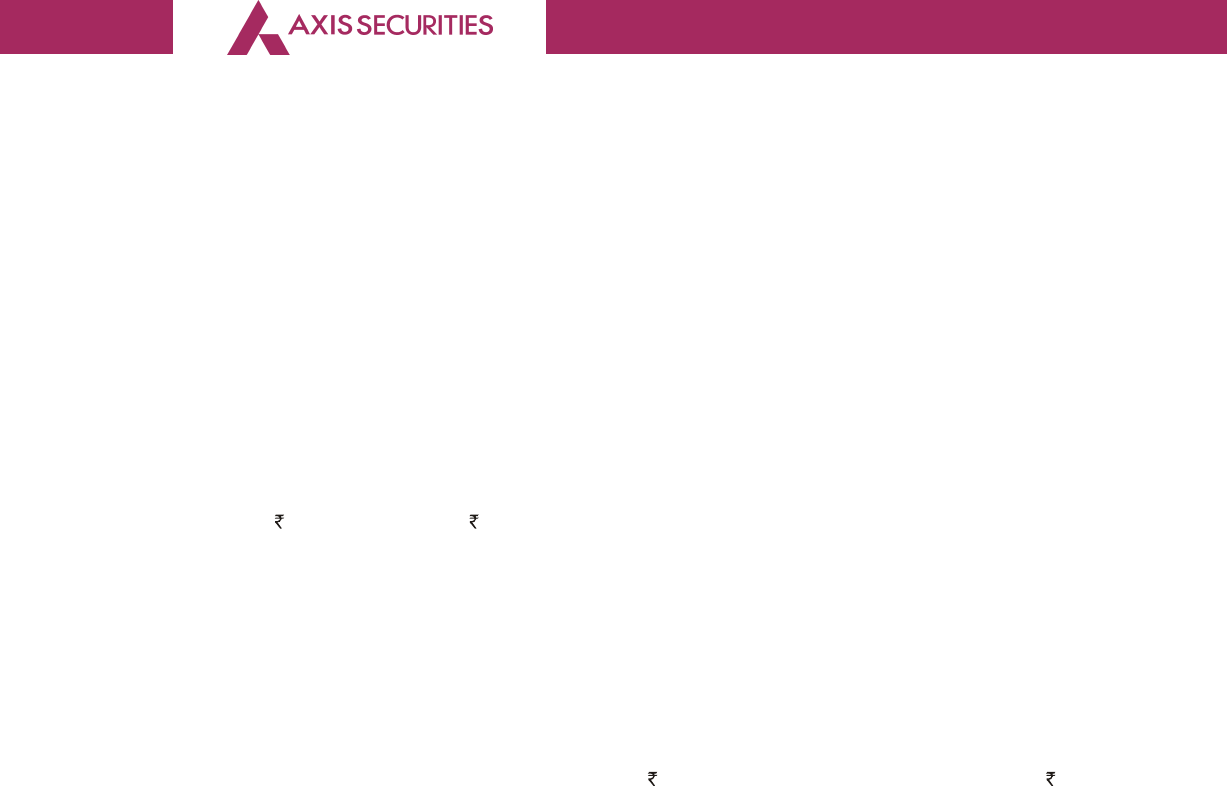
98
A Subsidiary of AXIS BANK
d. Defined benefit liabilities
Both under Indian GAAP and Ind AS, the group recognised costs related to its post-
employment defined plan on an actuarial basis. Under Indian GAAP, the entire cost,
including acturial gains and losses, are charged to profit and loss. Under Ind AS,
remeasurements [comprising of acturial gains and losses, the effect of asset ceiling,
excluding amount included in net interest on the defined benefit liability and the return
on plan assets excluding amounts included in net interest on the net defined benefit
liability] are recognised immediately in the balancesheet with as corresponding debit or
credit to retained earnings through OCI. Thus the employee benefit cost is reduced by
183.57 lakhs and 85.63 lakhs for year ended 31 March 2018 and 31 March 2017
respectively and remeasurement gains / losses on defined benefit plans has been
recognised in the OCI net of tax.
e. Security deposit
Under Indian GAAP, interest free security deposit for leasehold premises is taken at carrying
value in the balance sheet. Under Ind AS, the security deposit value has been discounted
to present value at each balancsheet date starting the date of transition i.e 1 April 2017.
The impact of EIR on Security deposit is 8.40 lakhs (discounting rate 9.43 %) and 12.70
lakhs (discounting rate 9.43%) for financial year ending 31 March 2020and 31 March
2019 respectively
f. Deferred tax
Indian GAAP requires deferred tax accoutning using the statement of profit and loss
approach, which focuses on differences between taxable profits and accounting profits
for the period. Ind As 12 requires entities to account for deferred taxes using balancsheet
approach, which focuses on temperory differences between the carrying amount of an
asset or liability in the balance sheet and its tax base. The application of Ind AS 12
approach has not resulted in recognition of deferred tax on new temperory differences
which was not required under Indian GAAP
g. Other comprehensive income
Under Indian GAAP, the company has not presented other comprehensive (OCI)
separatley. Hence it has reconciled Indian GAAP profit or loss to profit or profit or loss as
per Ind AS. Further, Indian GAAP profit or loss is reconciled to total comprehensive income
as per Ind AS
h. Statement of cash flows
The transition from Indian GAAP to Ind As has not a material impact on the statement of
cash flows
Notes forming part of the financial statements for the year ended 31 March, 2020
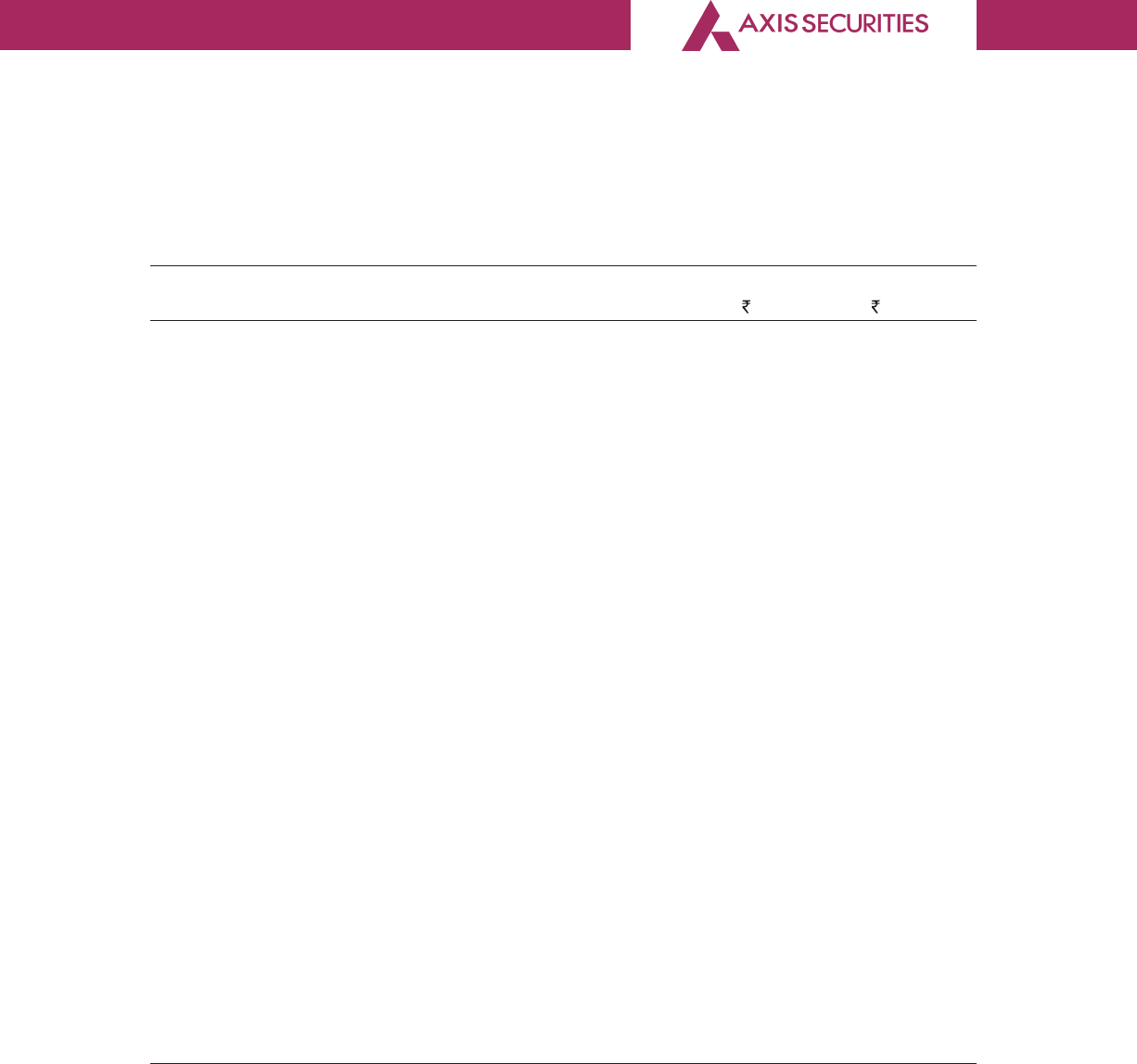
99
A Subsidiary of AXIS BANK
Notes forming part of the financial statements for the year ended 31 March, 2020
39B Reconciliation of tax expense and the accounting profit multiplied by India’s domestic tax
rate for 31 March 2020 and 31 March 2019:
31 March 20 31 March 19
( in Lakhs) ( in Lakhs)
Accounting profit before tax from continuing operations 4,644 4,551
Profit/(loss) before tax from a discontinuing operations 665 6,693
Accounting profit before income tax 5,309 11,244
At India’s statutory income tax rate of 22% (31 March 2019: 30%)
Adjustments in respect of conversion from Indian GAAP to Ind AS
Timing difference in gratuity as per Ind As (13) 16
Timing difference in subscription as per Ind As (629) 168
Timing difference in Fixed Assets 10 130
Timing difference for other items (171) 55
Deductions u/s Chapter VIA 97 67
Non-deductible expenses for tax purposes:
Impairment of business expenses – –
Other non-deductible expenses 2,354 1,760
Allowable Expenses (1,365) (1,333)
Short Term Capital Gains 186 175
At the effective income tax rate of 25.17% (31 March 2019: 27%)
Income tax expense reported in the statement of profit and loss – –
Basic Tax 1,405 3,732
Surcharge 141 448
Education Cess 62 167
Excess Provision for Last year – –
DTA Rate change effect (314) 7
Income tax expense reported in the statement of profit and loss 1,608 4,347
Income tax attributing to round off (0.47) (0.48)
40. Share based payments
Employee Stock Options granted by holding company
During the year, the holding company issued Current Year NIL(Previous year:74,000) of stock
options to some employees of the holding company who are on deputation with the Company.
Further the holding company has also issued Current Year NIL (Previous year: 20,000) stock
options directly to the employees of the Company. Since these stock options are issued by
the holding company directly to the employees of the Company or holding company and
the related costs, if any, will be borne by the holding company, no provision is made in the
accompanying financials statements.
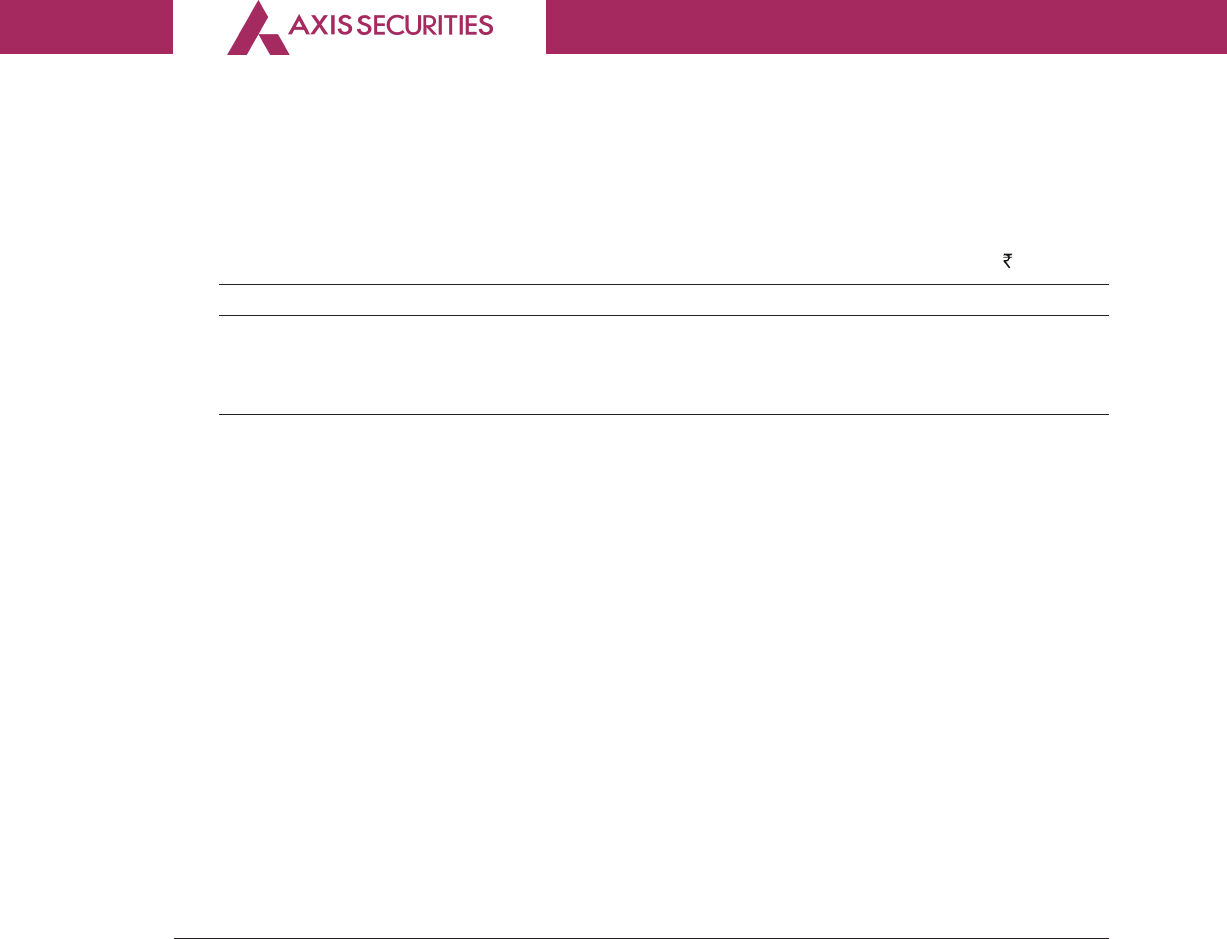
100
A Subsidiary of AXIS BANK
Notes forming part of the financial statements for the year ended 31 March, 2020
The expense recognised for employee services (company’s employee) received during the
year is shown in the following table ( in Lakhs)
31 March 20 31 March 19
Expense arising from equity-settled share-based 115 155
payment transactions
115 155
41. During the year the company has paid Rs. 28.45 crores to Axis Bank Limited towards transfer of
Client’s Demat accounts. The said transaction is of exceptional nature and is non recurring
and has been disclosed accordingly. The total accounts transferred are 1896451 accounts.
42 As the global pandemic COVID-19 continues to spread, on March 24, 2020, the Indian
government announced a strict 21-day lockdown which was further extended by 19 days
across the country to contain the spread of the virus. The management has assessed the
internal and external information upto the date of approval of these financial statements
including economic forecasts and concluded that there is no material impact of Covid-19 on
the Company’s future performance.
43. Previous year comparatives
Previous year figures have been regrouped and reclassified, wherever necessary to conform
to current year’s presentation.
44 Events after reporting date
There have been no events after the reporting date that require disclosure in these financial
statements.
For S.R.Baltiboi & Co. LLP For and on behalf of the Board of Directors
Firm Registration No.: 301003E/E300005
Chartered Accountants
Pralay Mondal
Chairman
DIN No: 00117994
per Jitendra H. Ranawat
Partner Gopkumar Bhaskaran Anand Shaha
Membership No. : 103380 Managing Director & CEO Whole-Time Director
DIN No: 07223999 DIN No: 02421213
Hemantkumar Patel Divya Poojari
Place : Mumbai Chief Financial Officer Company Secretary
Date : April 23, 2020 PAN: AGOPP9611N PAN: BIJPP6102N
